Meadoway Updates
There is always something on the go in The Meadoway, as we work to transform a 16 km stretch of the Gatineau Hydro Corridor into a thriving meadow and multi-use trail.
Check this page regularly to get our latest trail building and meadow restoration updates.
LATEST NEWS
August 2025
The Meadoway in Bloom!
The Meadoway is currently in full bloom, showcasing a diverse mix of native flowers that act as an important food source for many pollinators.
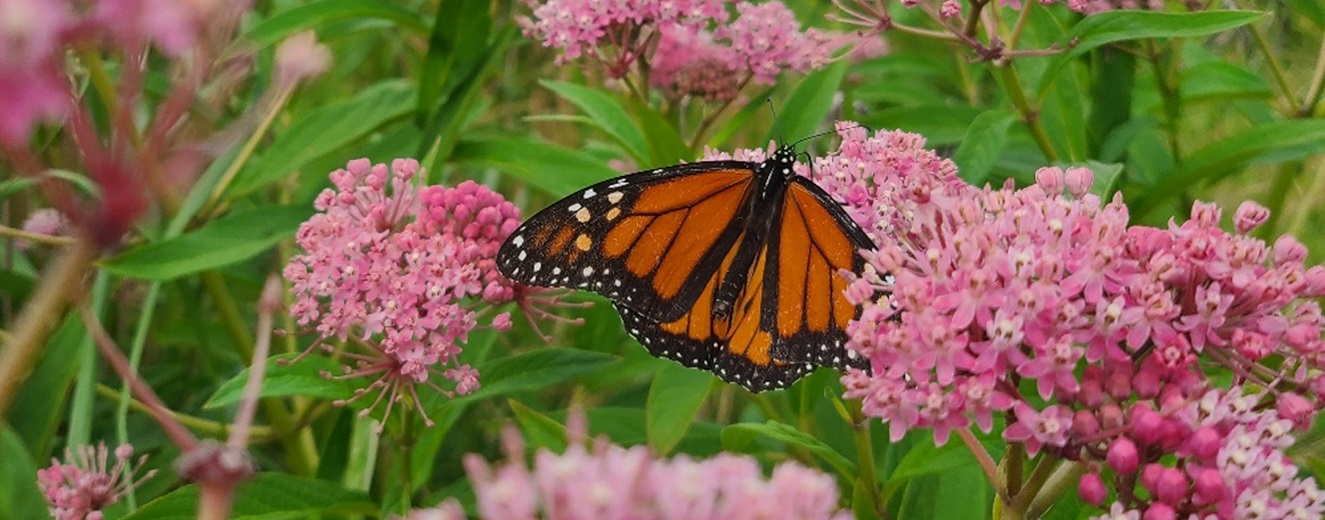
Our Restoration Team has been hard at work mowing the turfgrass buffers around the meadow, managing invasive plant species through various methods, and installing additional signage.
A small area within the corridor, close to Morningside Road, is undergoing site preparation to convert it into meadow. This site will be seeded next spring to bring additional species diversity to The Meadoway.
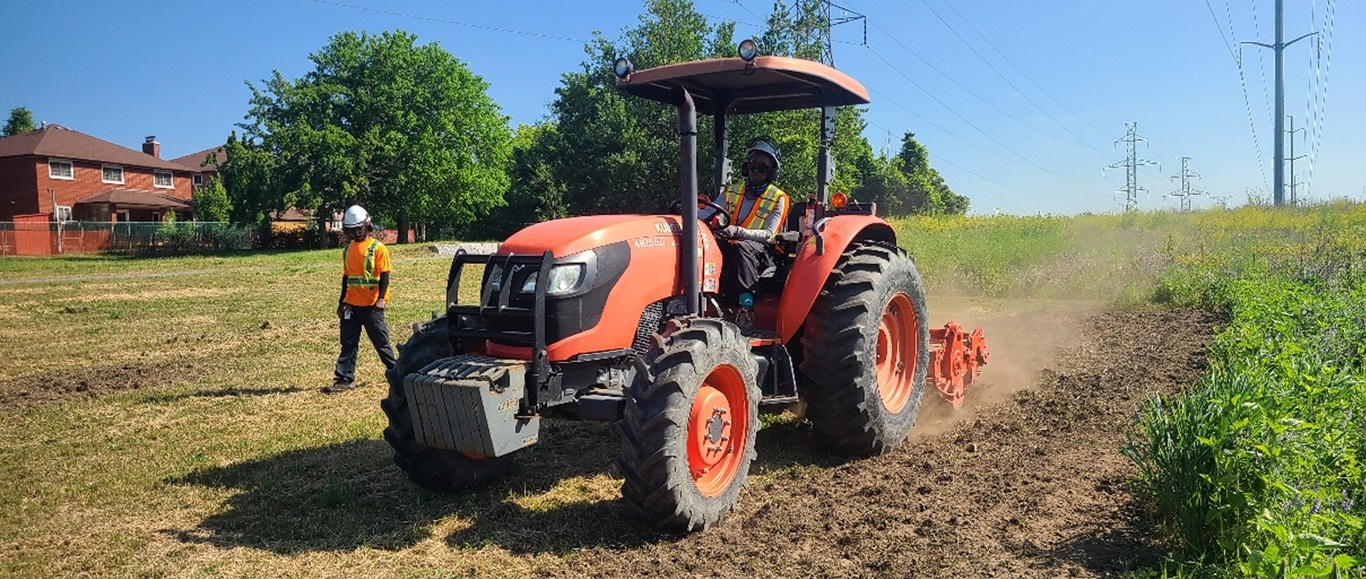
The recently constructed Meadoway Entrance Garden, a generous gift from The Garden Club of Toronto, is also thriving as the team waters and weeds the newly planted space.
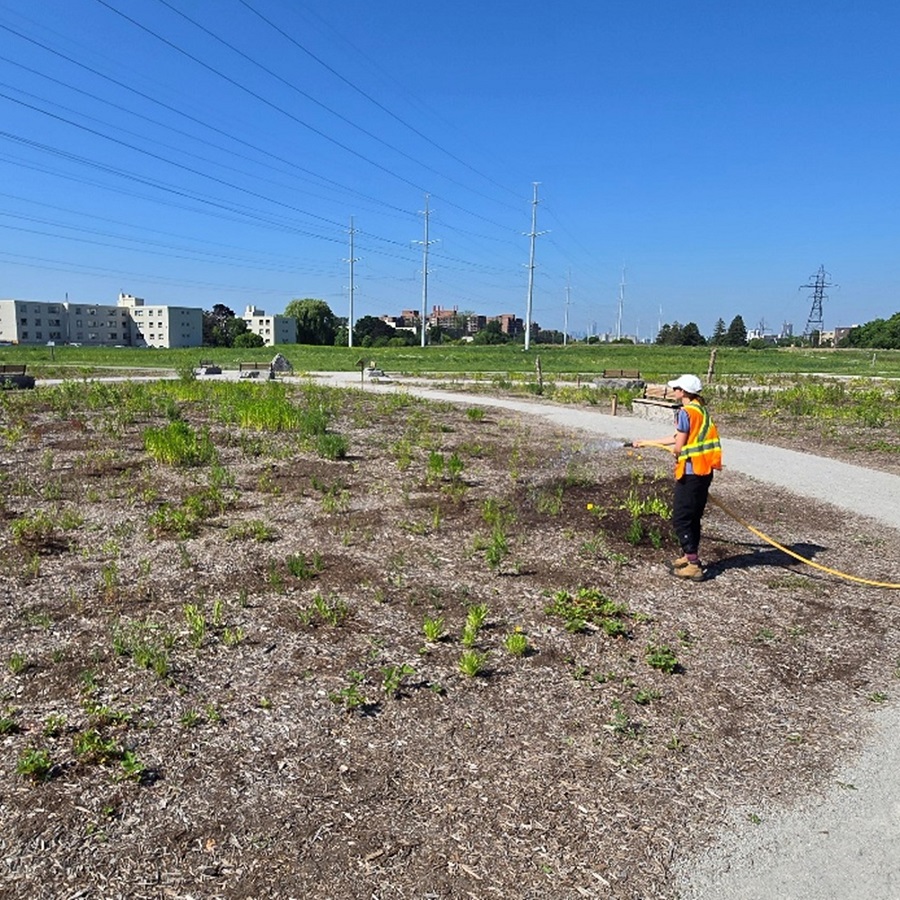
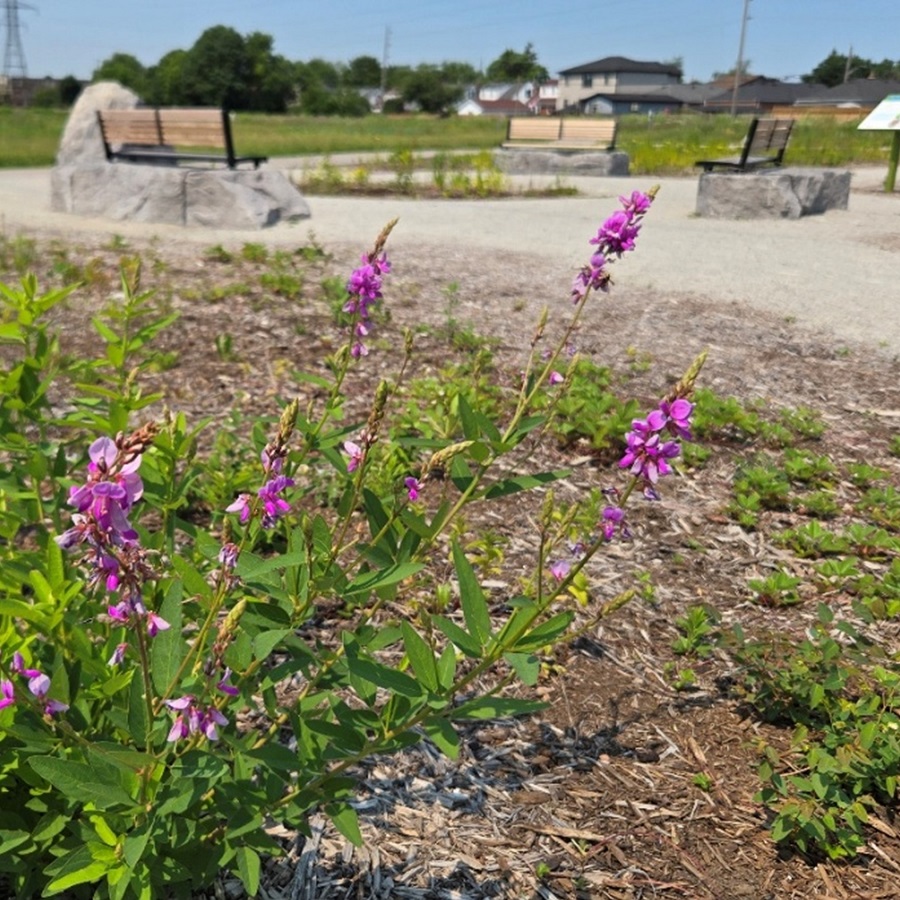
As the summer progresses and blooms begin to fade, staff will begin harvesting seeds from successful meadow areas to help restore and enrich underperforming areas throughout the corridor.
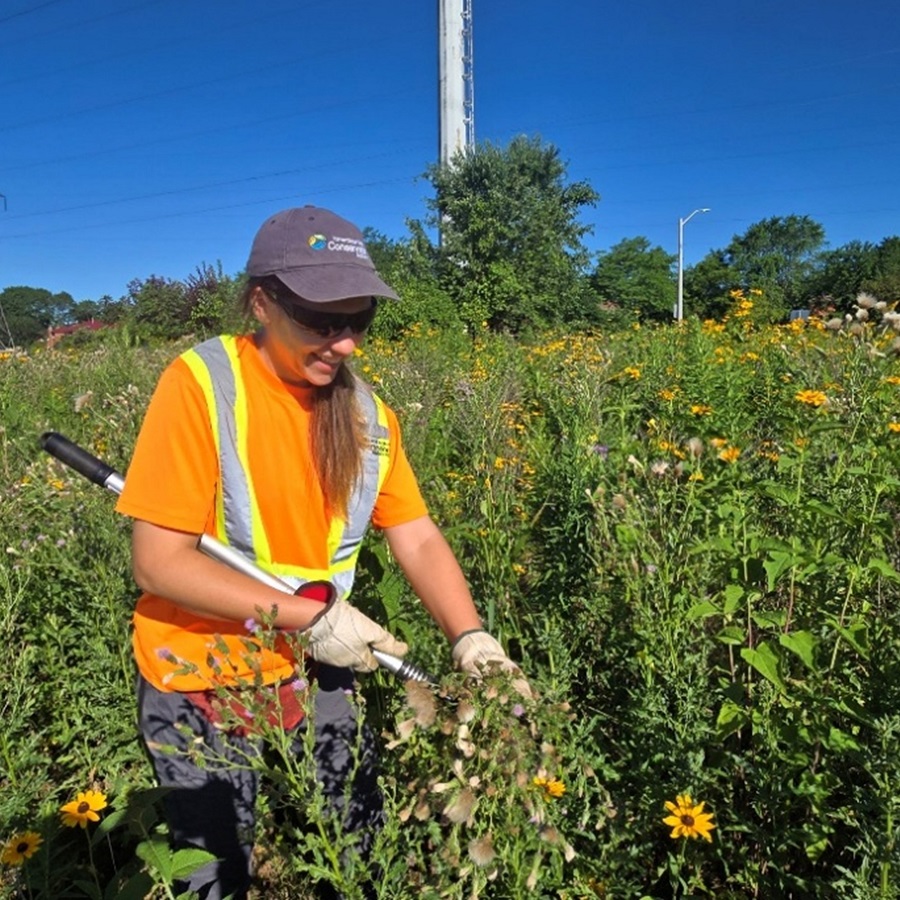
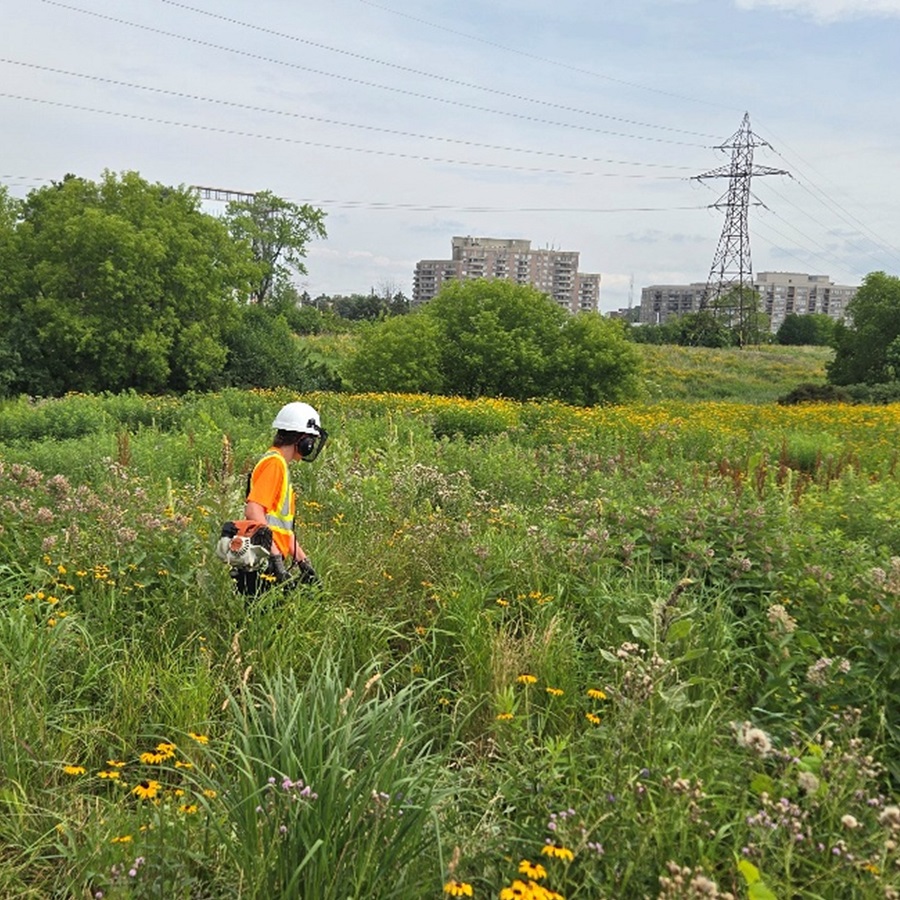
The images below demonstrate the increase in species diversity following meadow creation. The top photo was taken in 2022, before restoration. The bottom photo is current, taken in the summer of 2025
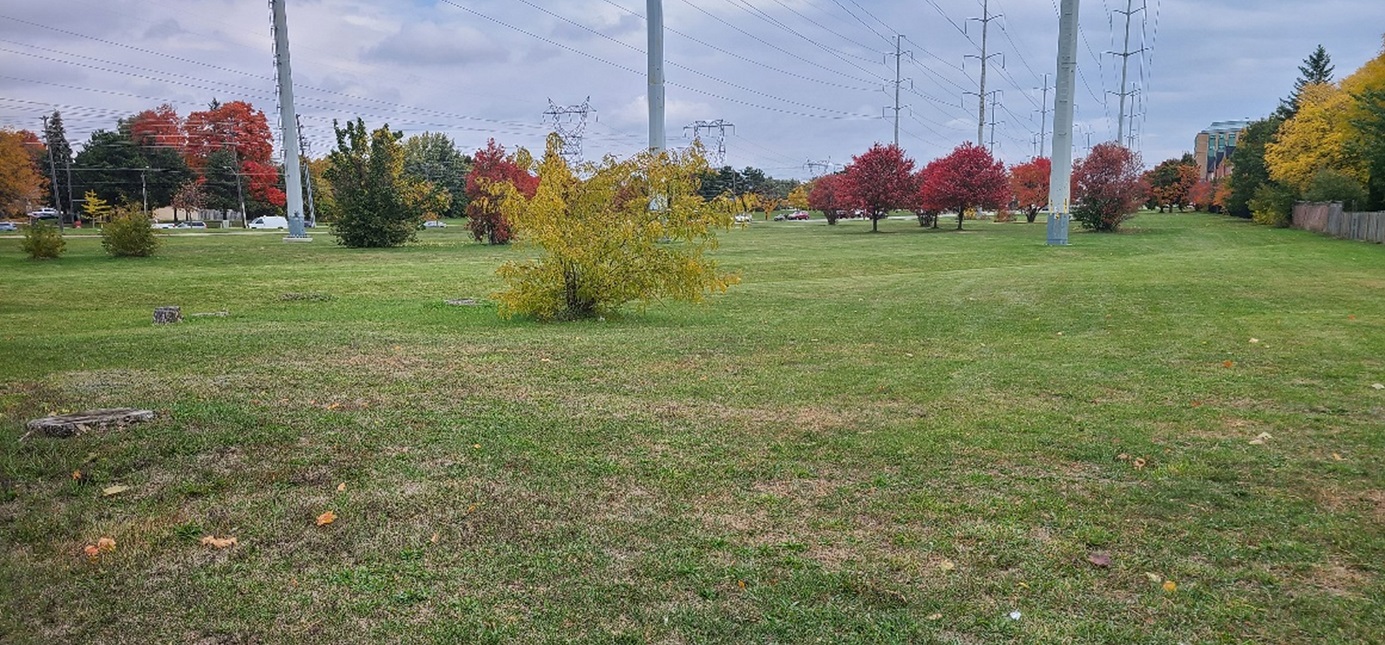
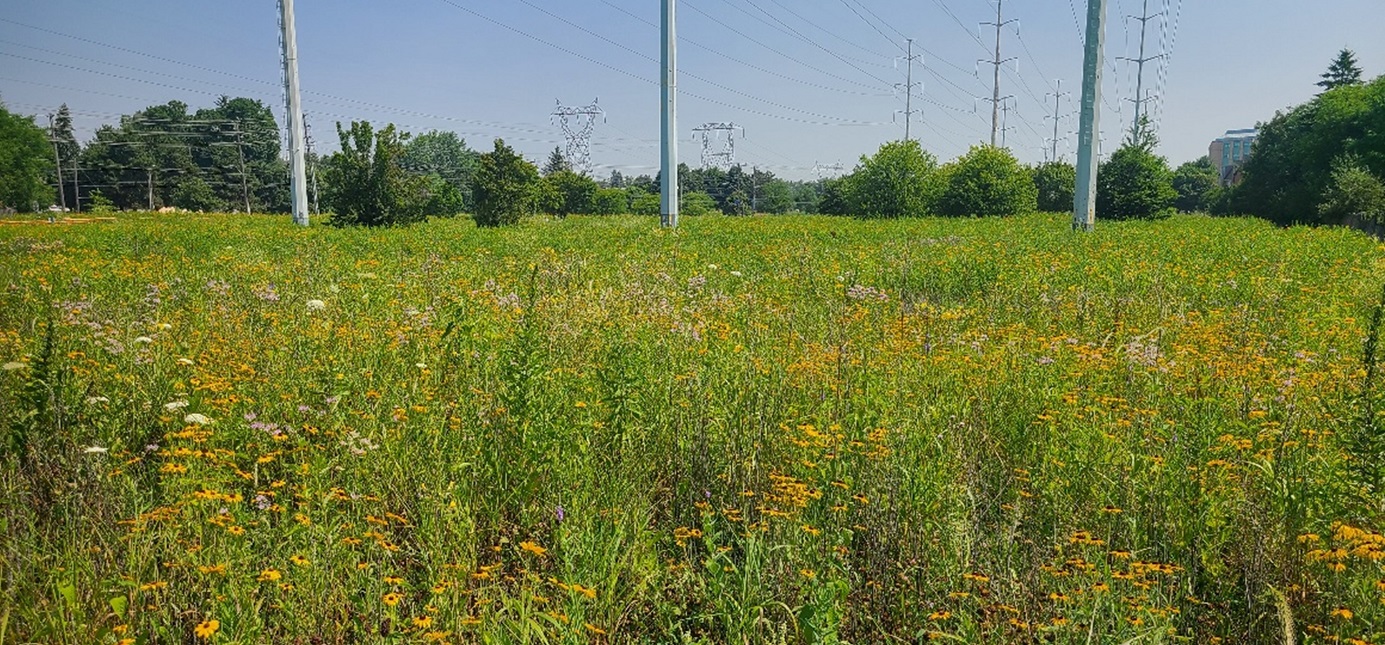
April 2025
NOTICE OF CONSTRUCTION:
The Meadoway – Section 3, Phase 1
Midland Avenue to Marcos Boulevard
Toronto and Region Conservation Authority (TRCA) is preparing to start construction on The Meadoway – Section 3, Phase 1. This work will enhance connectivity and accessibility along the corridor through the introduction of a multi-use trail and the installation of a new signalized crossing at Midland Avenue to improve safety for all users.
March 2025
NOTICE OF CONSTRUCTION:
Military Trail to Neilson Road – New Seating and Rest Areas
Toronto and Region Conservation Authority (TRCA) will be installing new benches and rest areas within The Meadoway between Military Trail and Neilson Road to improve comfort and accessibility for trail users.
The trail will remain open during construction. Trail users should use caution around the four installation areas shown on the map (see the Notice of Construction for details).
Trail Enhancements in Progress – Construction Begins
Great news! Construction of trail enhancements has begun on The Meadoway, from Military Trail to Neilson Road. This phase includes new benches and rest areas, enhancing comfort and accessibility for trail users.
We’re excited to see this space evolve into a more inviting and inclusive environment. Thank you for your patience as we work to improve The Meadoway!
Stay tuned for more updates as construction progresses.
February 2025
Exciting Progress Ahead for the Meadoway!
Looking ahead to spring 2025, exciting progress is planned for two key projects that will further enhance this incredible green corridor.
Section 3: Spanning from south of Arsandco Park, crossing Midland Avenue east to Marcos Boulevard, south of Lawrence Avenue, this section will be moving into construction. This includes a new signalized crossing on Midland Avenue.
Section 5: Stretching from Military Trail to Neilson Road, this area will see public realm enhancements, including new benches and rest nodes, to provide more comfort and amenities for trail users.
Stay tuned for updates as we continue transforming the Meadoway into a vibrant, sustainable, and accessible trail for everyone!
VIEW PAST UPDATES
October 2024: New Section of Trail
NEW SECTION OF TRAIL:
The Meadoway Trail from Military Trail to Morningside Avenue
We are thrilled to announce that a new section of The Meadoway multi-use trail from Military Trail to Morningside Avenue has officially been completed and is now open for everyone to enjoy!
This newly completed section of the larger Meadoway corridor features 650 m of multi-use trail, providing a safe and ecologically rich connection for pedestrians, cyclists, and nature enthusiasts alike.
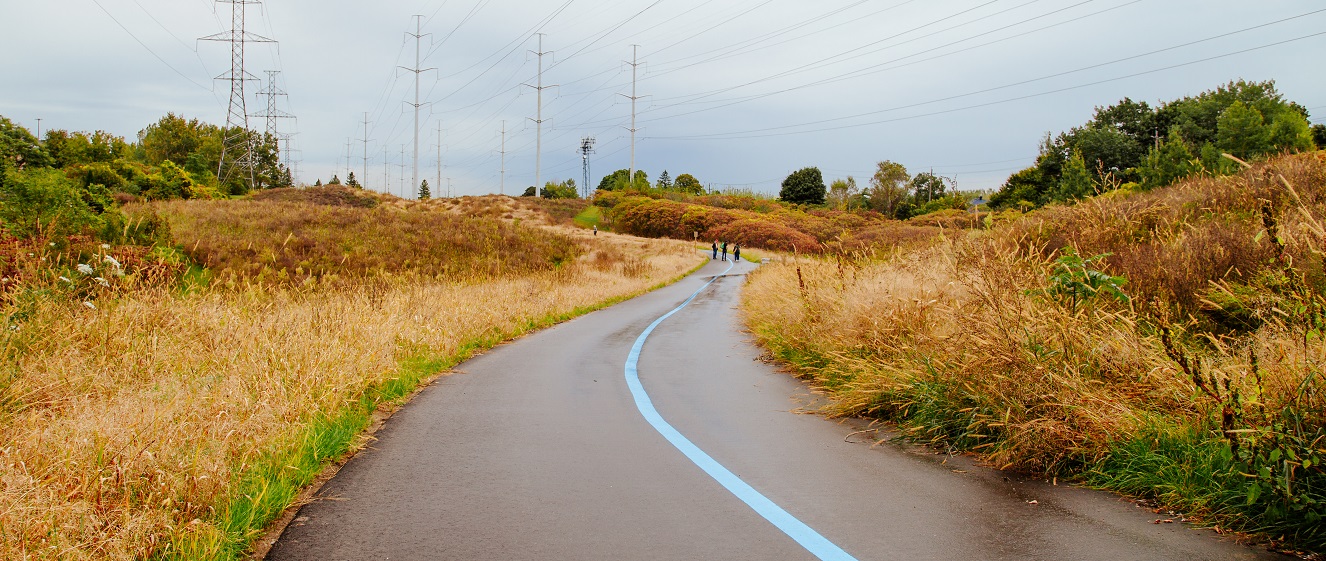
Toronto and Region Conservation Authority (TRCA) would like to extend our gratitude to everyone who has contributed to the realization of this remarkable trail connection.
This project has been achieved through the power of partnership, and with unwavering support from the community.
October 4, 2024: Unveil the Trail Community Event
Unveil the Trail: Community Event
Thank you to everyone who joined us for our Unveil the Trail event!
It was a wonderful celebration of our growing trail network, powered by the passion and engagement of our community.
Together, we are creating vibrant spaces for connection, biodiversity, and active transportation.
SEE PHOTOS FROM THE TRAIL OPENING:
September 2024: Guided Meadoway Hike and Gardening Workshop
Guided Meadoway Hike and Gardening Workshop
On September 14, 2024, TRCA gathered with enthusiastic participants at Thomson Memorial Park to explore one of Canada’s most exciting greenspace revitalization projects: The Meadoway!
Partnering with the Toronto Master Gardeners, attendees learned about the importance of The Meadoway, a thriving ecological corridor that will benefit local people, plants, and animals for years to come.

Guided by TRCA, Toronto Master Gardeners, and Meadoway Ambassadors Anika, Tulika, and Kishani, the group had a hands-on experience collecting seeds from native species, including Wild Bergamot, Giant Sunflower, Hairy Beardtongue, and Common Milkweed.
Everyone took home a bit of The Meadoway, ready to re-wild their own backyards and share with neighbours to expand the positive environmental impact!
We left feeling inspired to be a part of this incredible journey to restore local ecosystems.
A big thank you to everyone who joined us! Keep an eye out for more upcoming events in The Meadoway and opportunities to get involved.
April 2024: Let's Clean Up The Meadoway!
Let’s Clean Up The Meadoway!
This year’s third annual Earth Day cleanup at The Meadoway brought together dedicated community members who worked hard to make a difference!
Together, we collected an impressive 94 lbs of litter, helping to keep Scarborough’s community-powered greenspace clean and healthy.
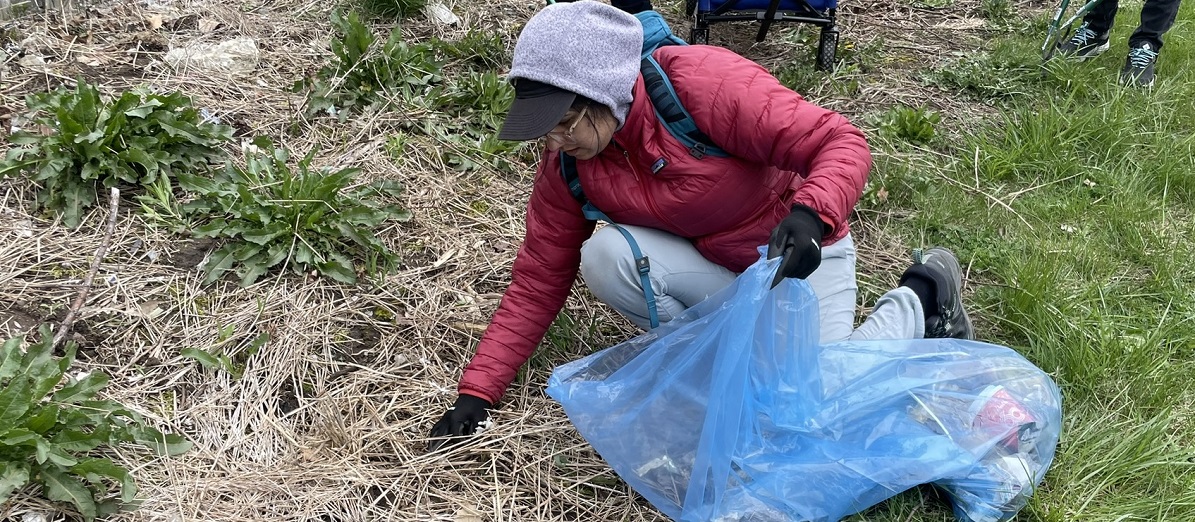
During the event, participants learned about the impact of microplastics, stormwater pollution, and why it’s so important to keep our natural spaces free of litter.
Thanks to everyone who joined us in taking action for a cleaner, greener future!
March 2024: NOTICE OF CONSTRUCTION - The Meadoway Entrance Garden
NOTICE OF CONSTRUCTION:
The Meadoway Entrance Garden
Toronto and Region Conservation Authority (TRCA) is undertaking the creation of an entrance garden within The Meadoway project this March. The proposed gardens are located within Section 1 of The Meadoway, north of Eglinton Avenue and just west of Pharmacy Avenue in Scarborough.
February 2024: NOTICE OF CONSTRUCTION - Section 6, Phase 1
NOTICE OF CONSTRUCTION:
The Meadoway Trail Implementation: Section 6, Phase 1
Toronto and Region Conservation Authority (TRCA) is preparing to commence trail implementation construction work. This work will establish a new section of multi-use trail from Military Trail east to Morningside Avenue, enhancing access and connectivity.
October 2023: Updated Trail Branding
TRAIL UPDATE:
Updated Trail Branding!
The Meadoway trail from Conlins Road to Zoo Road has undergone a refresh, with updated trail branding and centrelines.
You will now notice a clear and colorful centreline along the route, as well as Meadoway logos at trail entrances and exits, making navigation easier and safer for walkers, runners, and cyclists.
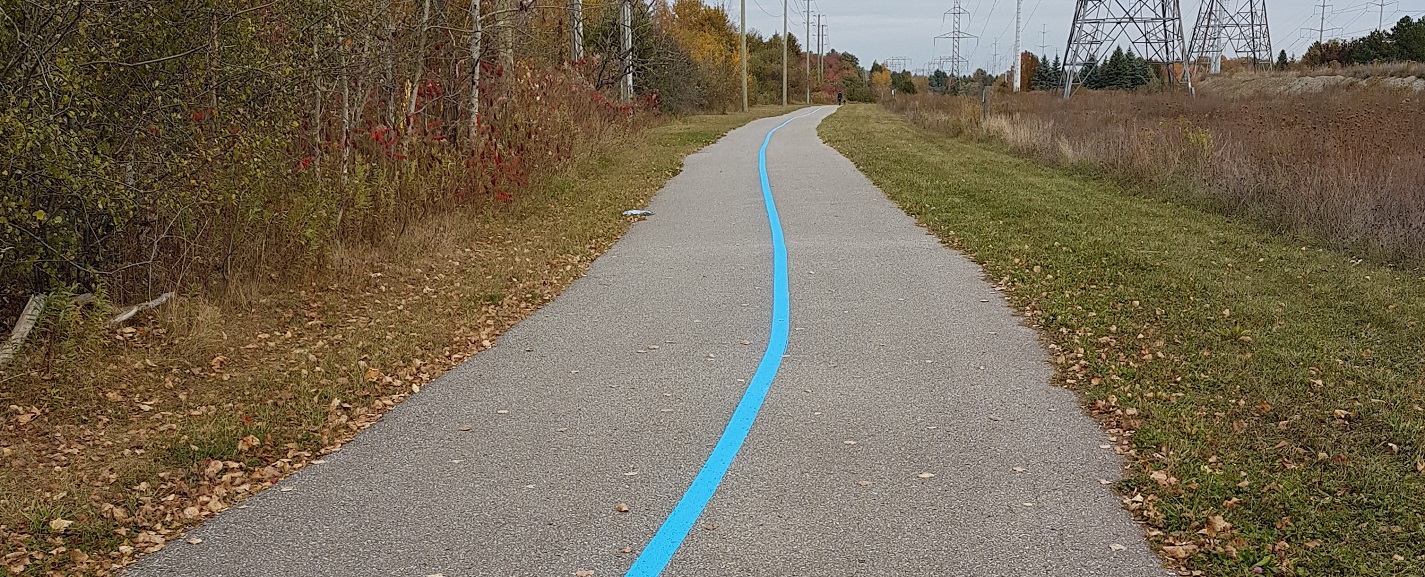
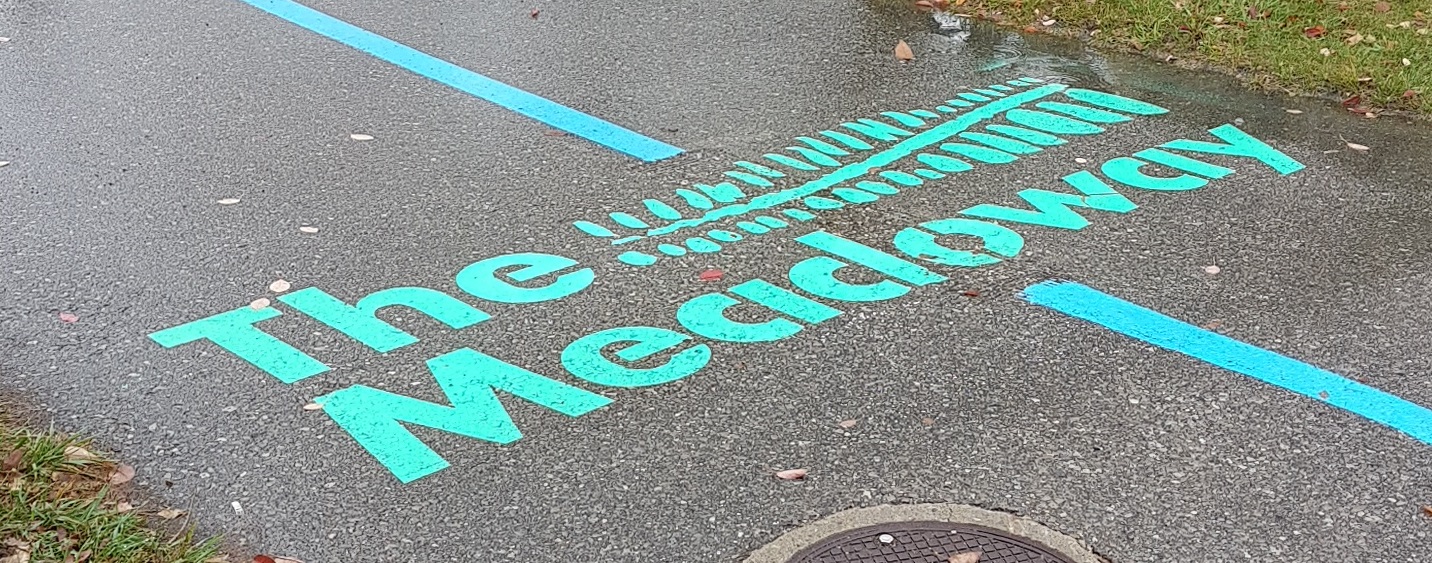
October 26, 2023: Grand Opening - The Meadoway Trail from Military Trail to Neilson Road
GRAND OPENING:
The Meadoway Trail from Military Trail to Neilson Road
We are excited to announce that The Meadoway trail from Military Trail to Neilson Road is now open to the public!
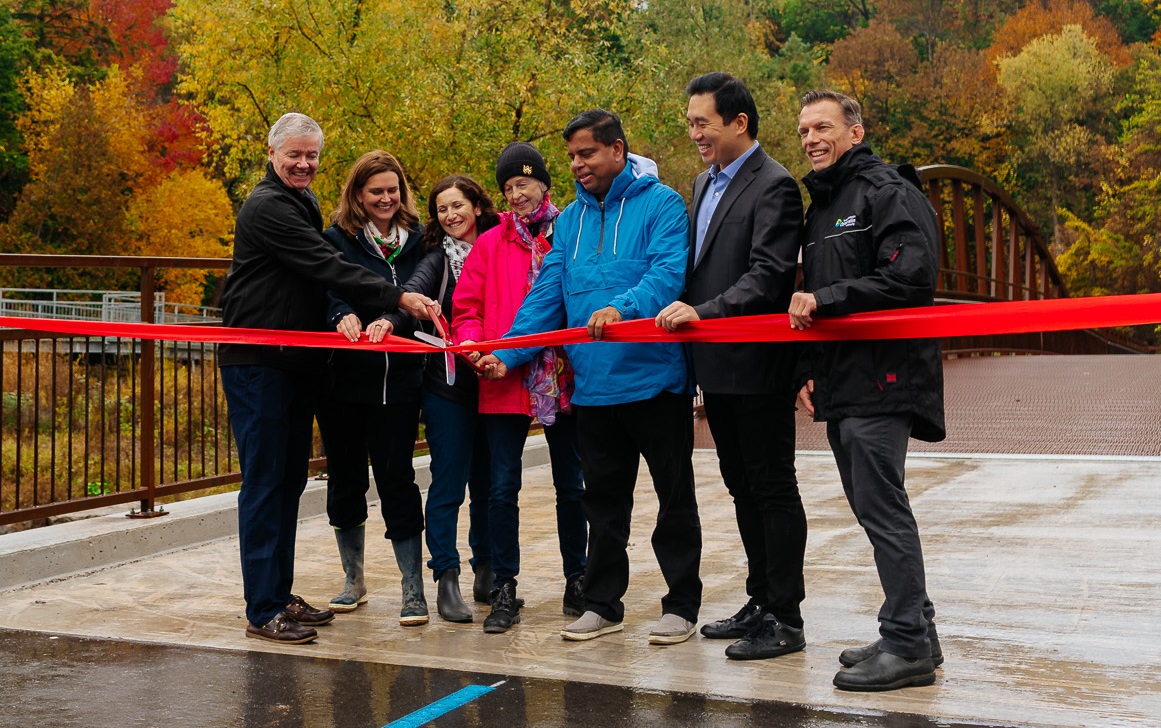
The grand opening of the trail from Military Trail to Neilson Road. Left to right: City of Toronto Councillor Paul Ainslie, Chair of Toronto and Region Conservation Authority’s (TRCA) Board of Directors; Jennifer McKelvie, Deputy Mayor, City of Toronto and TRCA Board member; Lara O’Donnell, Executive Director, Weston Family Foundation; Camilla Dalglish, Board Director, Weston Family Foundation; Gary Anandasangaree, Member of Parliament for Scarborough-Rouge Park; Shaun Chen, Member of Parliament for Scarborough North; John MacKenzie, Chief Executive Officer, TRCA.
This newly completed section of the larger Meadoway corridor features a 2 km multi-use trail that frames 16 hectares of meadow habitat and weaves across the stunning ravine landscape, linking Military Trail to Neilson Avenue and providing a safe and ecologically rich connection for pedestrians, cyclists, and nature enthusiasts alike.
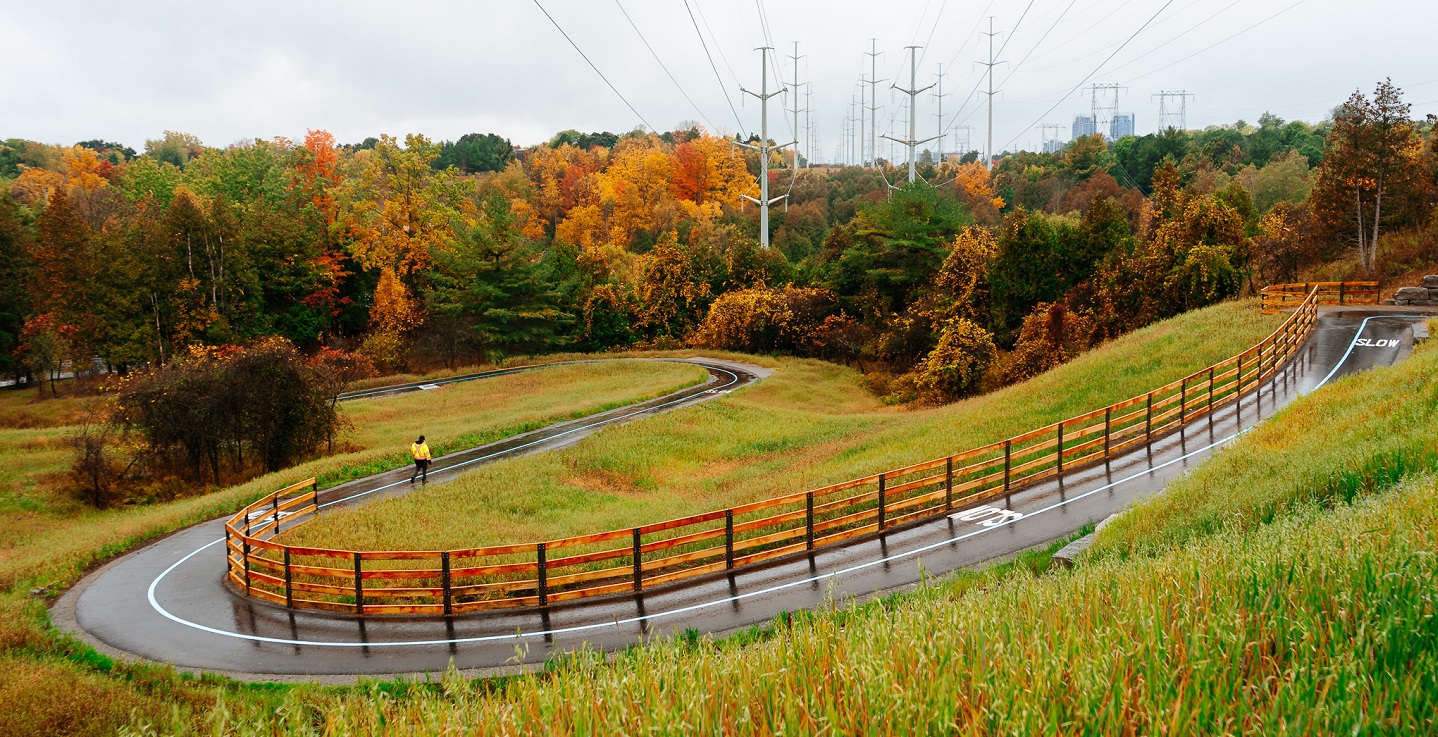
Special features of the project include a pedestrian bridge offering spectacular views for the annual salmon run in Highland Creek, an elevated boardwalk spanning a provincially significant wetland, and a switchback capturing views of the surrounding community and valley.
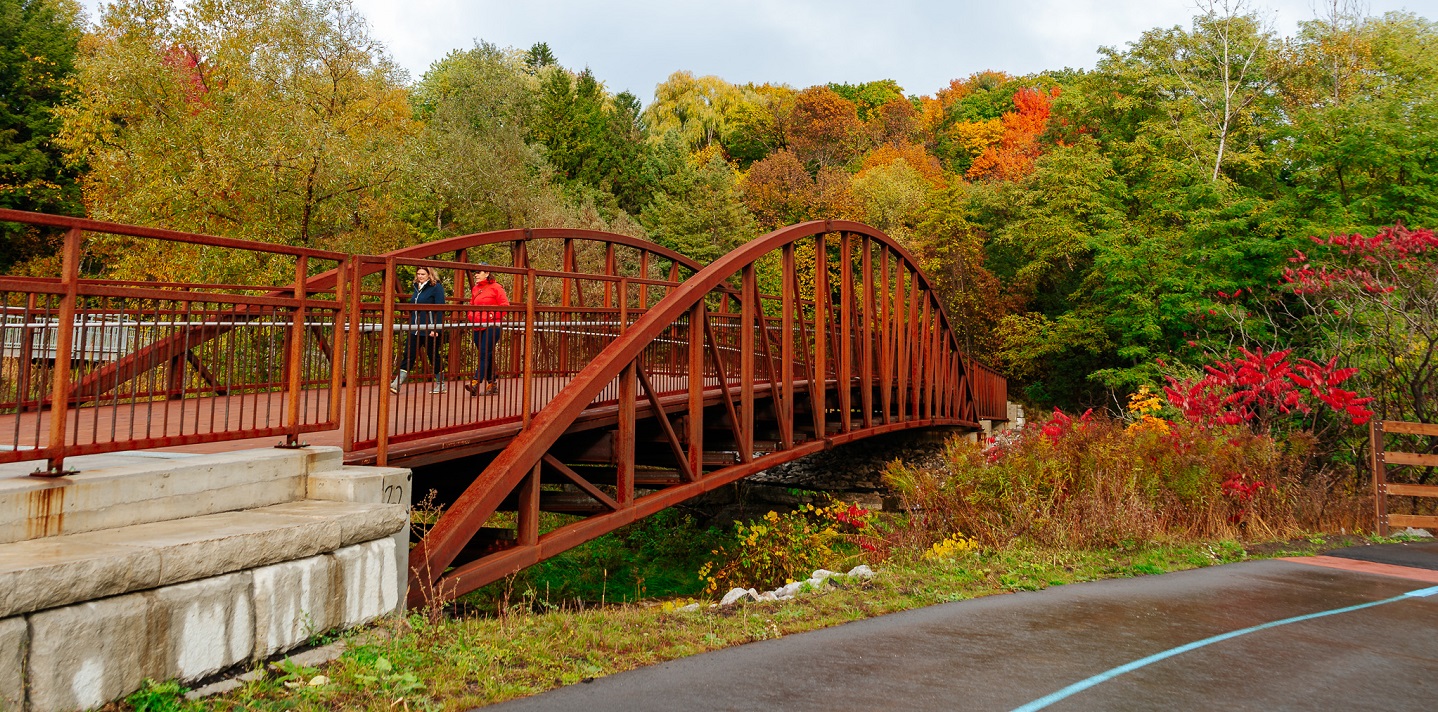
Toronto and Region Conservation Authority (TRCA) would like to extend our gratitude to everyone who has contributed to the realization of this remarkable trail connection.
This project has been achieved through the power of partnership, and with unwavering support from the community.
View The Meadoway Public Access Map.
SEE MORE PHOTOS OF THE TRAIL FROM THE GRAND OPENING:
August 2023: Trail Construction Update
TRAIL CONSTRUCTION UPDATE
The trail from Military Trail to Neilson Road is nearing the finish line! Construction crews are moving into the final stages of work including seeding and paving.
View The Meadoway Public Access Map.
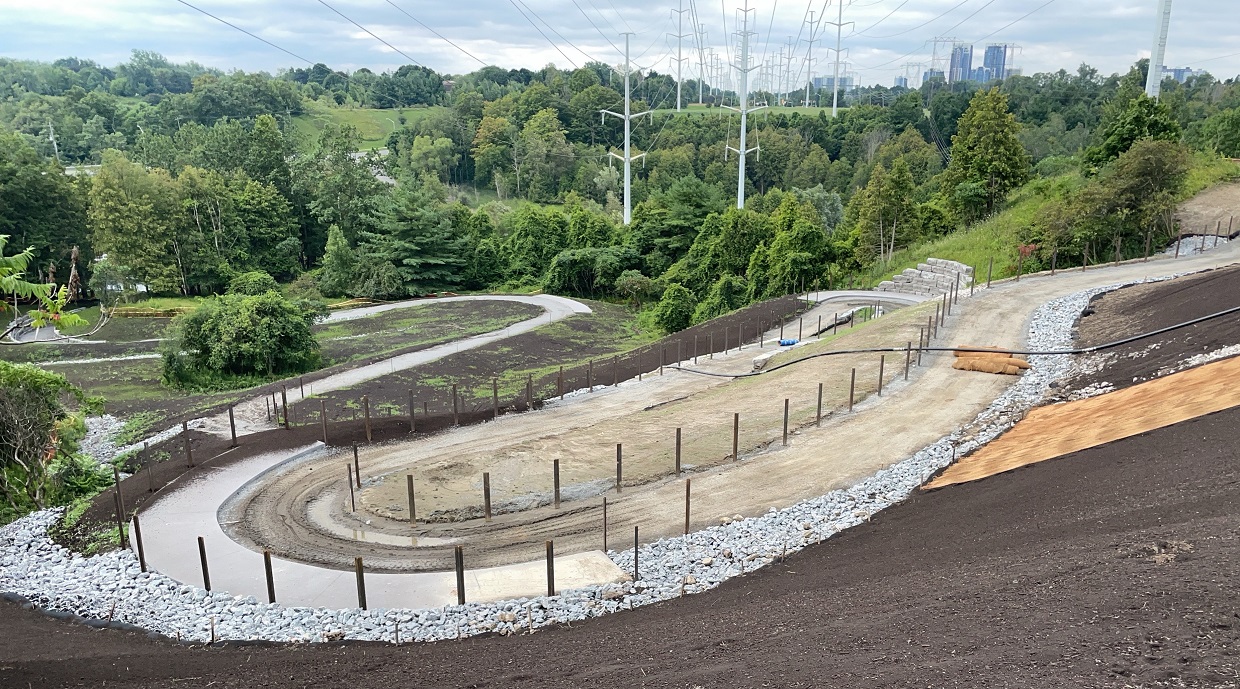
June 2023: Updates
TRAIL CONSTRUCTION UPDATE
The Meadoway trail from Military Trail to Neilson Road is well underway and will be open to the public by Fall 2023.
While this segment of The Meadoway is under construction, the existing pedestrian pathway through the hydro corridor west of Neilson Road is now open for public use on weekends.
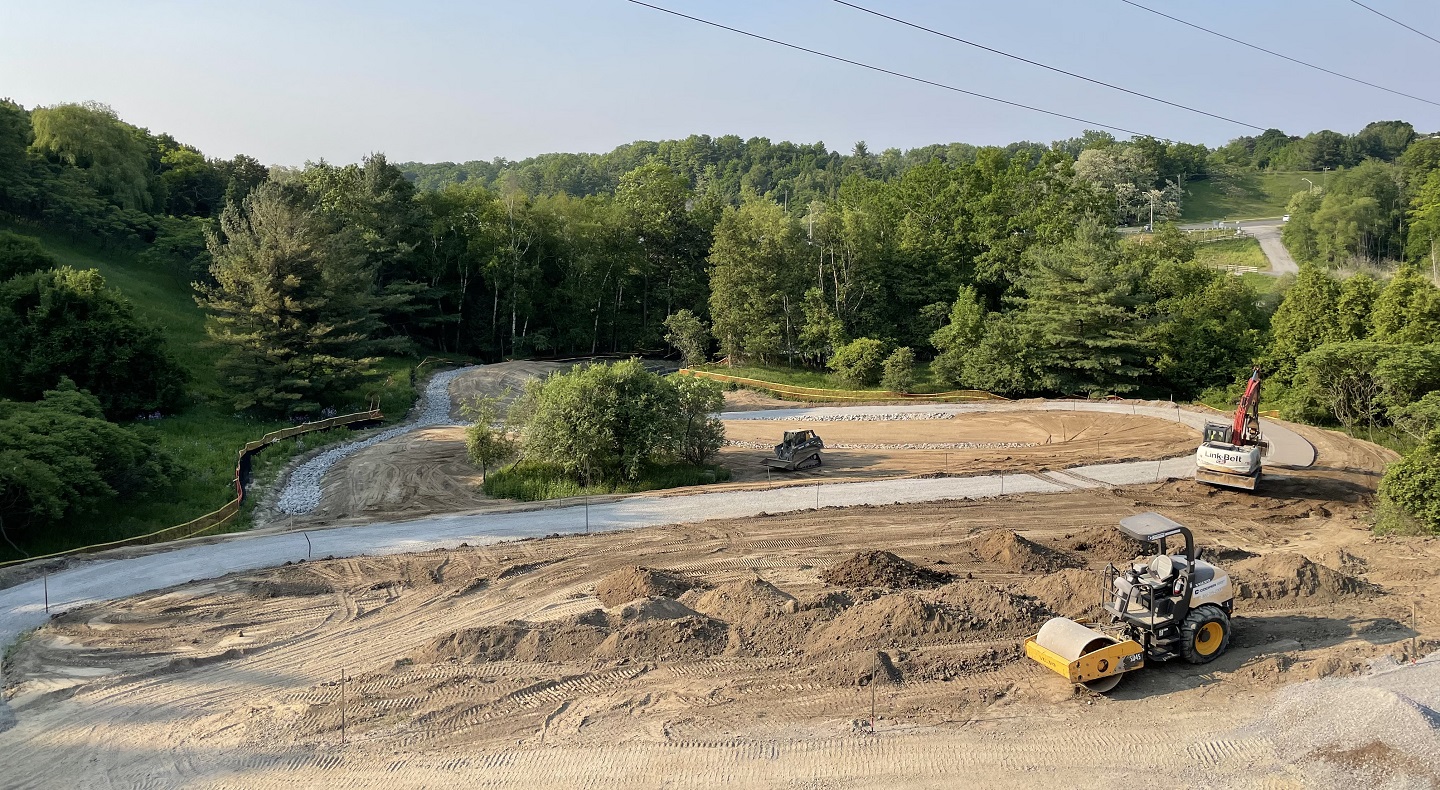
RESTORATION UPDATE
Despite the challenges posed by fluctuating temperatures and precipitation, our teams have responded swiftly and adjusted schedules to ensure that all tasks continue moving forward.
We’re proud to share that approximately 3,000 kg of garbage has been collected in preparation for the upcoming works. The management of invasive species along the corridor has also made significant progress, with a total of 10 hectares addressed to date.
Site preparation activities, including mowing, rototilling, and seeding with cover crop, have been completed between Kennedy Rd. to Thompson Park and Neilson Rd. to Conlins Rd.
Additionally, the first round of turfgrass buffer mowing around the meadows has been finished throughout The Meadoway, and we’re currently in progress with the second round.
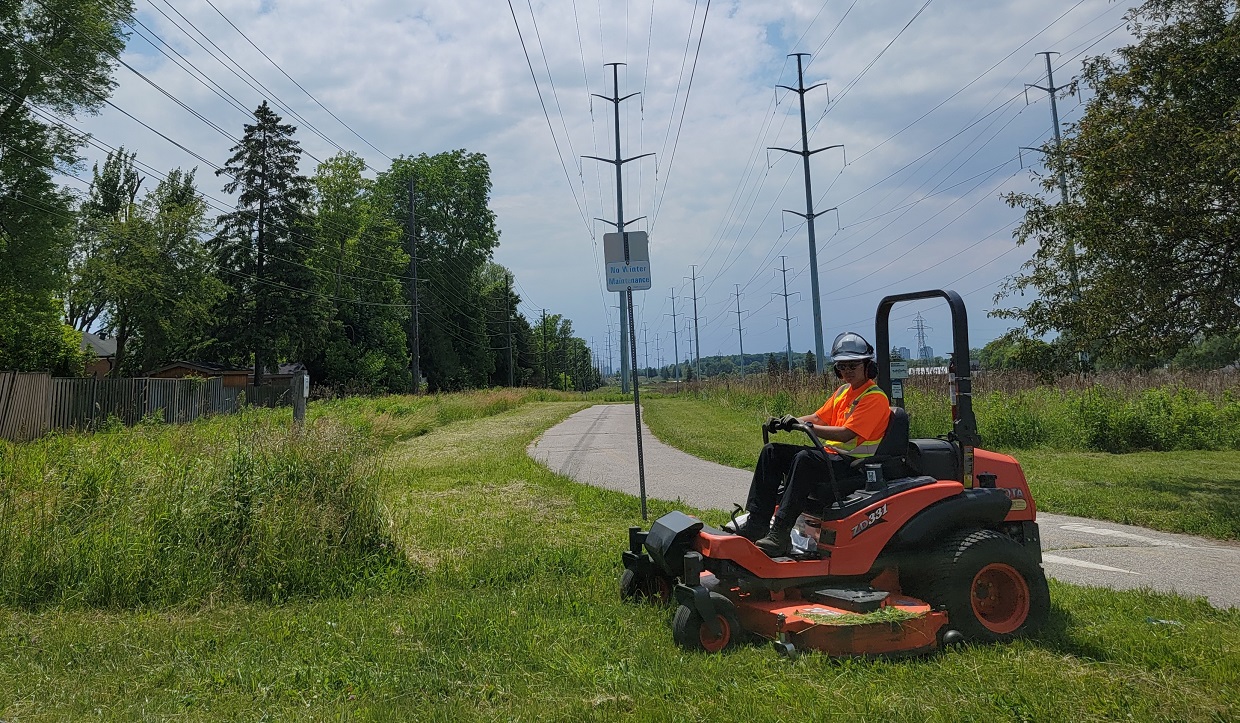
We’re excited to share that the City of Toronto has contributed to The Meadoway by planting multiple shrub nodes near Military Park.
Amidst all this work, the return of wildlife and plant species has been a joy to witness! Native seeds that were sown last winter from Scarborough Golf Club Rd. to Neilson Rd. have started germinating, and mature plants in older restoration areas – including milkweed, pussytoes, blue vervain, grey-headed coneflower, false sunflower, foxglove beardtongue, and evening primrose – are thriving.
This resurgence of native plants has attracted a variety of butterflies, bird species, and other pollinators, including monarchs, savanna sparrows, and mining bees.
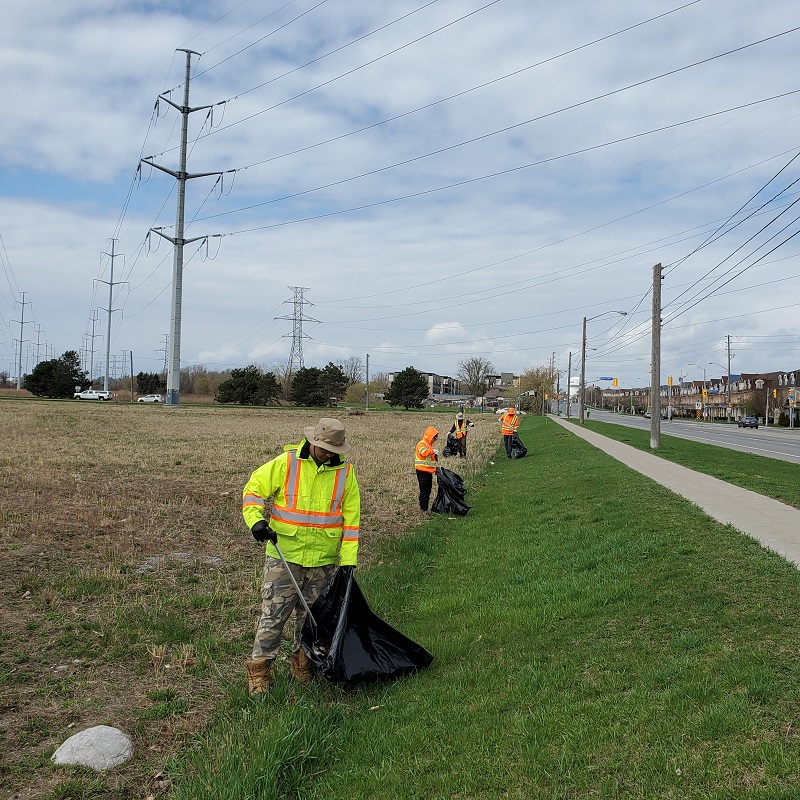
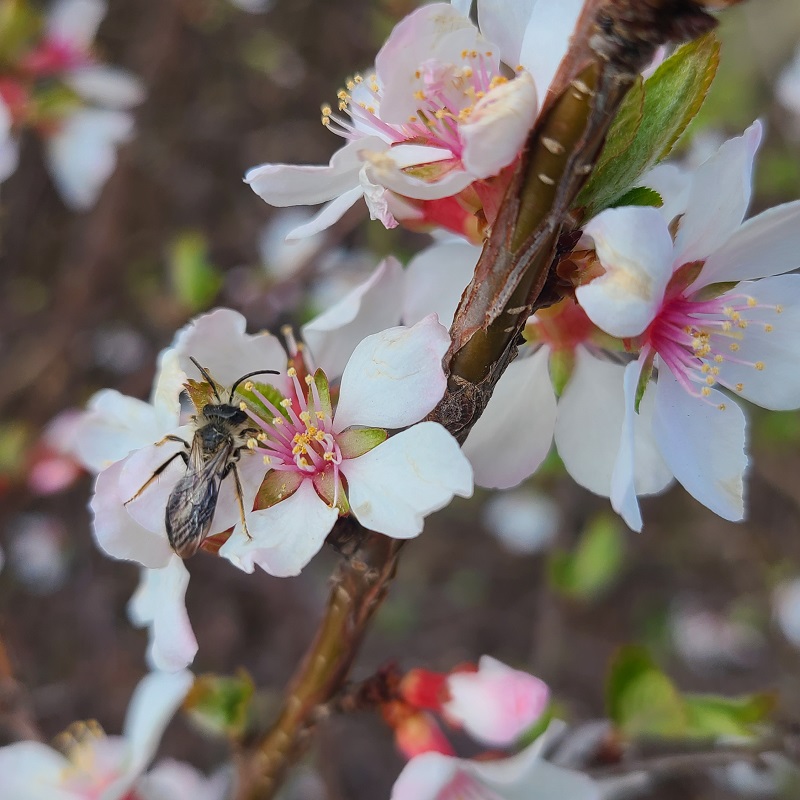
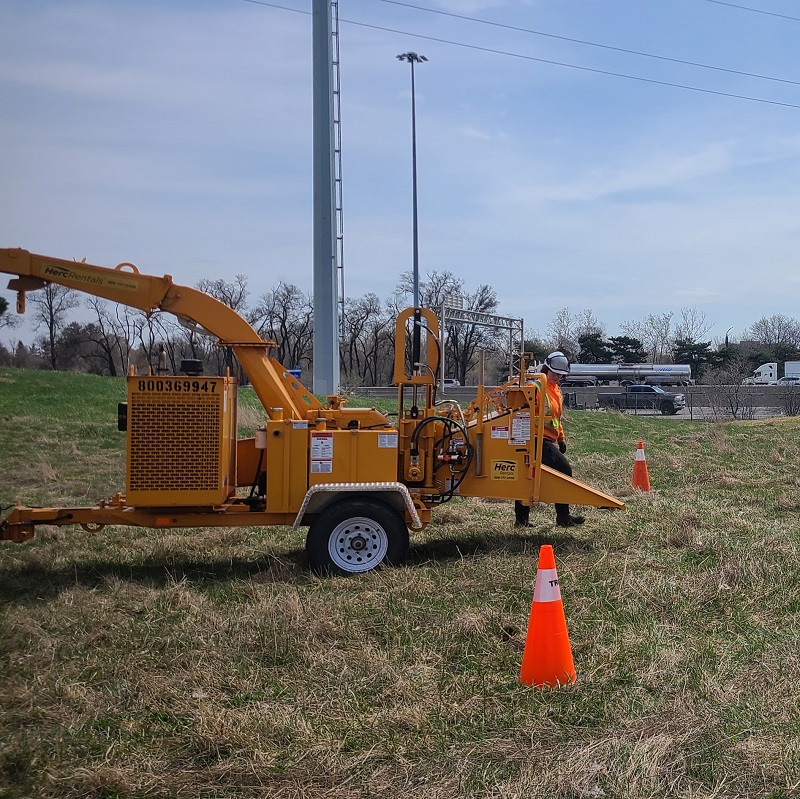
EDUCATION: SCHOOLS AND SCHOOL GROUPS
What a special spring it has been for students who live in and go to school around The Meadoway!
The education team is always so inspired by the young people who come out to learn more about The Meadoway project, how it relates to them as local residents, and to get their hands dirty as they work to steward the land!
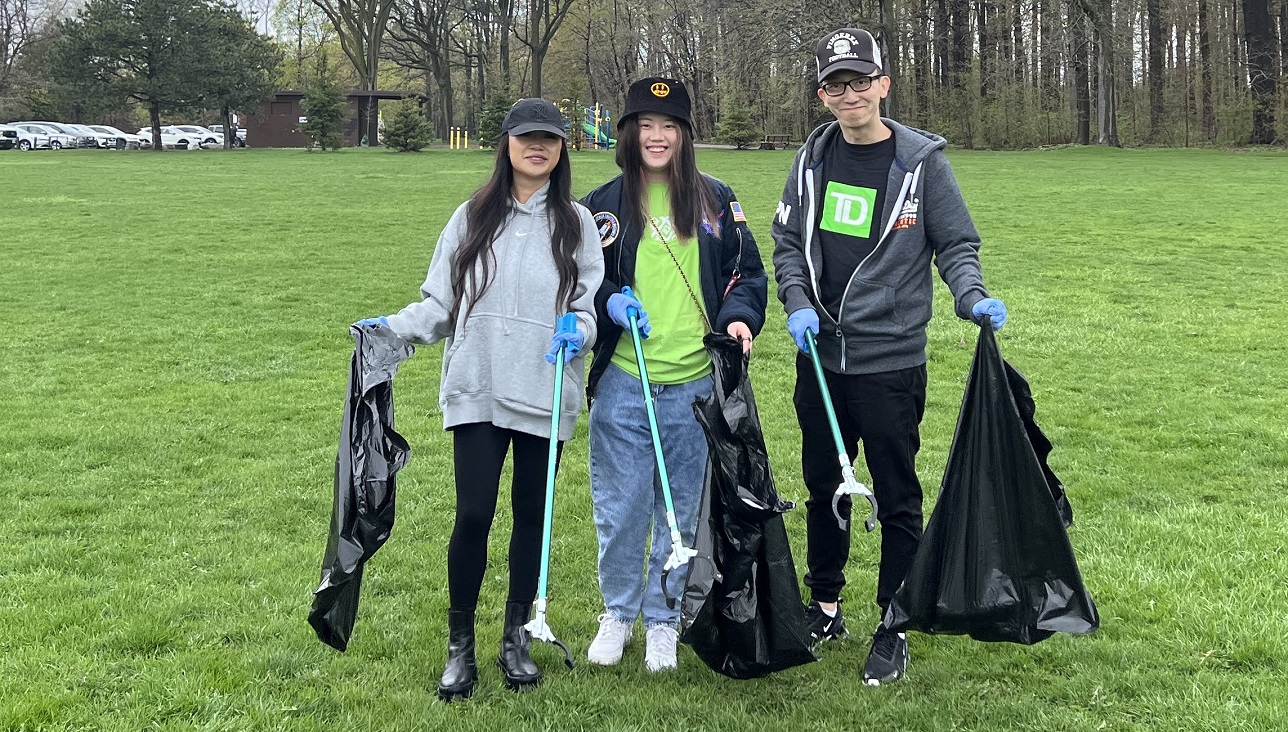
With 15 school field trips taking place in a variety of locations along the corridor, students from grades 1-10 came out to The Meadoway and learned about exciting topics like invasive species, winged migration, and native plants.
Students learned that when we all work together, we can support climate action in our shared spaces. The future is bright in The Meadoway!
April 2023: Implementation and Restoration in Sections 3 and 6
2023 IMPLEMENTATION AND RESTORATION
IN SECTIONS 3 AND 6
The Meadoway’s trail network will grow in 2023 as we continue to implement sections to fill in the remaining gaps.
This includes building a new trail within the hydro corridor between Military Trail and Morningside Avenue, as well as extending through the hydro corridor west from Marcos Boulevard to Arsandco Park.
Toronto and Region Conservation Authority (TRCA) will also begin meadow restoration in these sections of the corridor, converting 21 ha of mown lawn to native meadow.
The implementation work will include site preparation (mow, till, and overseed with a cover crop) from May to October, with final meadow seeding occurring from October to end of December.
The two new meadow restoration locations are immediately west of Midland Avenue to Brimley Road and immediately west of Military Trail to Conlins Road.
NOTICES OF CONSTRUCTION:
Section 3: TTC Line 3/GO Stouffville rail corridor to Brimley Road – VIEW THE NOTICE OF CONSTRUCTION
Section 6: Immediately west of Military Trail to Conlins Road – VIEW THE NOTICE OF CONSTRUCTION
December 2022: Year End Updates
December 2022: Year End
CONSTRUCTION NEWS
Since The Meadoway was formally launched in 2018, establishing a fully connected, 16 km multi-use trail system linking the East Don Trail to Rouge National Urban Park has been a top priority for the project team.
Several years of meticulous planning, design, and consultation with the local community culminated in a milestone year for The Meadoway in 2022, as we broke ground on the first major trail gap to be filled.
The 2 km long trail will route users through recently converted meadow habitat within hydro corridor lands, as well as down into a spectacular section of the Highland Creek ravine just north of Morningside Park.
A number of unique trail features help this portion of The Meadoway stand out from the rest, including an elevated boardwalk through a provincially significant wetland, a pedestrian-cycle bridge over the east Highland Creek, and a direct connection to the recently completed Upper Highland Creek Pan Am Path.
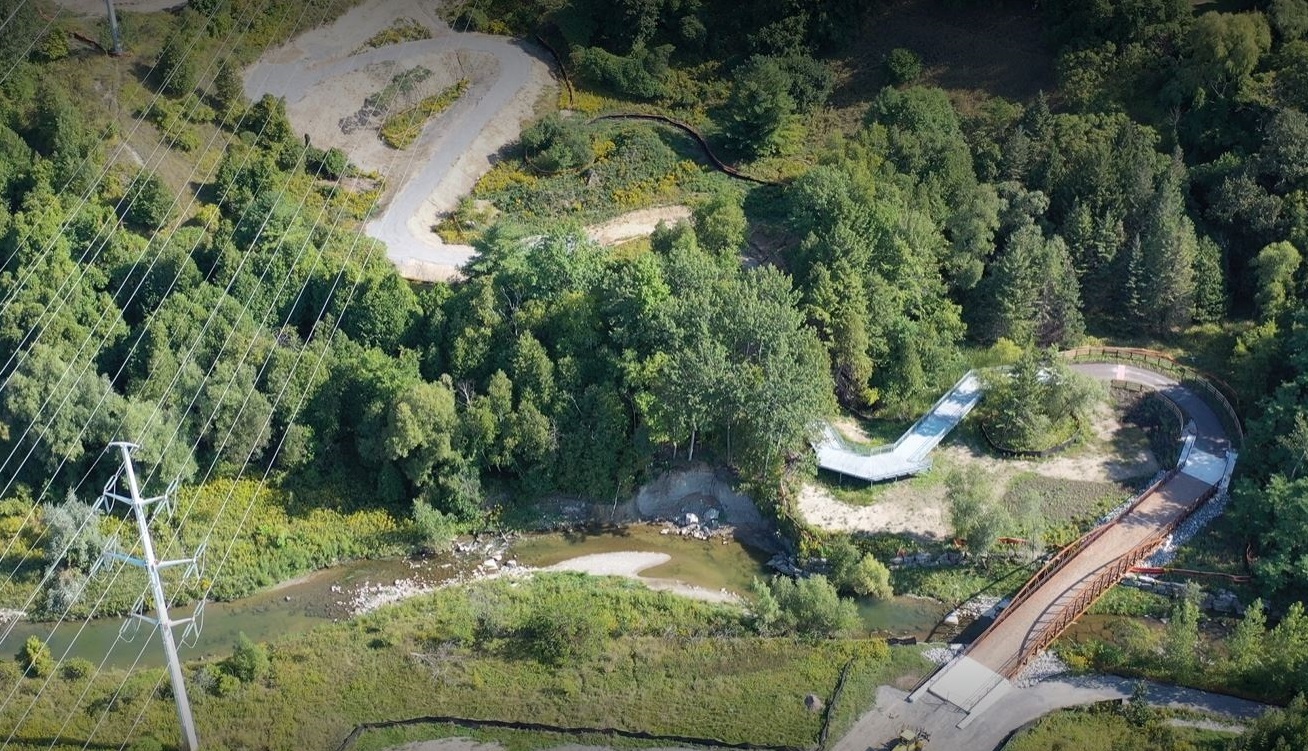
Built with accessibility in mind, the trail design minimizes steep grades while navigating challenging terrain and sensitive ravine habitat. A number of rest nodes will be constructed, offering excellent vistas of exposed bluffs and dense tree canopy.
Following full completion and site clean up, a comprehensive restoration and planting plan will be undertaken in 2023 that will include the placement of almost 1,000 trees and 7,000 riparian shrubs, supported by the extensive meadow restoration that is already underway. SEE BELOW.
We have big plans for 2023 as we continue to drive forward the construction of the remaining trail gaps within the Meadoway trail network.
This will include new trail built within the hydro corridor between Military Trail and Morningside Avenue, as well as a significant section of hydro corridor west of Thomson Memorial Park to Arsandco Park.
More information on these exciting new sections will follow in the new year. Stay tuned!
MEADOW RESTORATION NEWS
The meadow restoration team has had an excellent field season, as The Meadoway continues to transform into productive meadow habitat with the support and dedication from our field staff.
Meadow restoration and adaptive management has continued into the summer and fall of 2022, focusing on the Section 5 site preparation of 21 ha (Scarborough Golf Club Road and Neilson Road along Ellesmere Road). Native meadow seeding will be completed in late November to late December on the 17 ha within that footprint.
The meadow restoration crew size was increased this year to cover adaptive management and monitoring throughout the existing/established areas (sections 1, 2, 4 and 7), totaling 104 ha.
The activities being completed in these areas include management for invasive species, buffer mowing, meadow maintenance mowing and garbage collection.
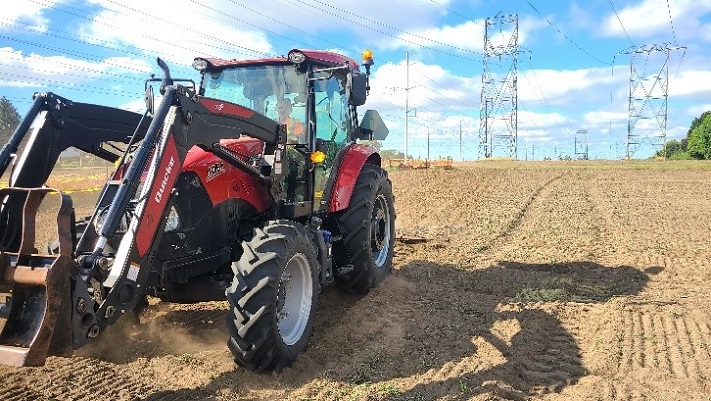
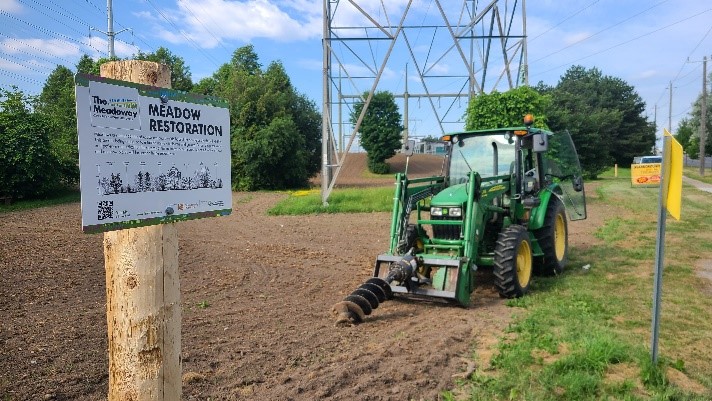
TRCA’s monitoring teams have completed their field analysis for birds/butterflies transects and flora plots and data is currently being reviewed, with the monitoring report to be completed by January 2023.
The Meadoway Restoration Manual was also published this year, providing practitioners with the methods and recommendations that the Restoration Team has learned over the years.
Finally, the Restoration Team has also hosted a variety of virtual and in-person informational tours that have showcased the hard work that the team has done over the years, some of the successes, and the resultant benefits of The Meadoway.
SECTION 1
This portion of The Meadoway runs from the edge of the Don Valley at Bermondsey Road to Victoria Park.
The meadow footprint was seeded in the spring of 2020, so this was its third year of growth. Activities completed here include removal of woody stemmed invasives, cleanup of fence lines, and buffer mowing around the meadow footprint.
The team is also preparing some areas for overseeding to increase the species diversity.
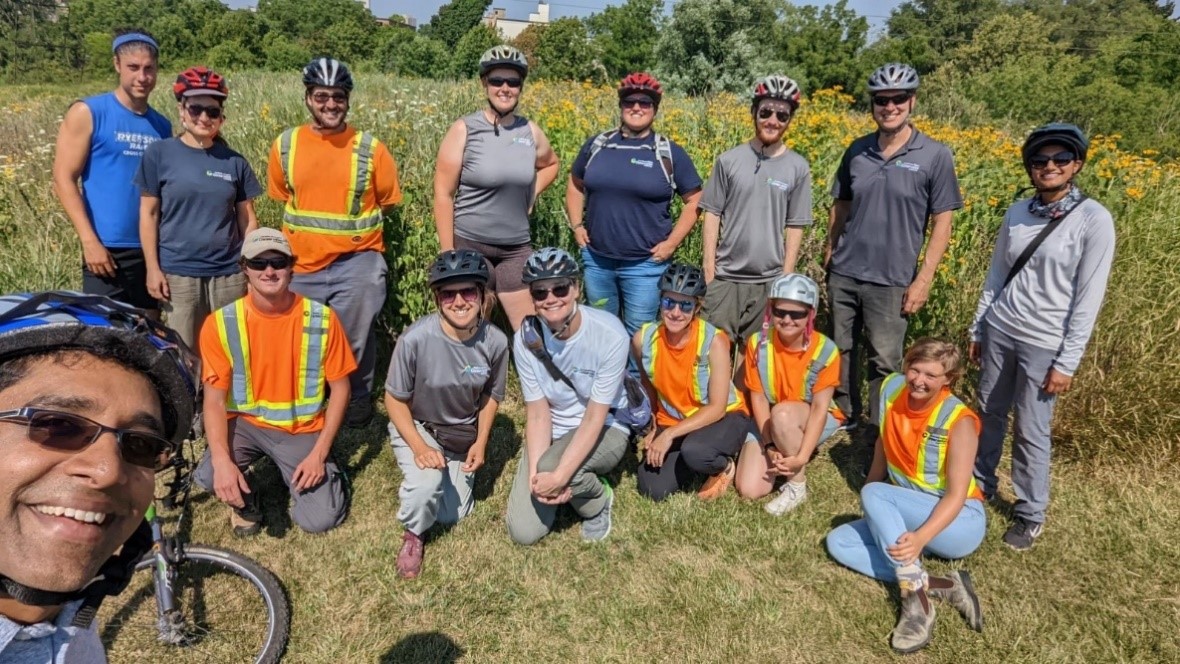
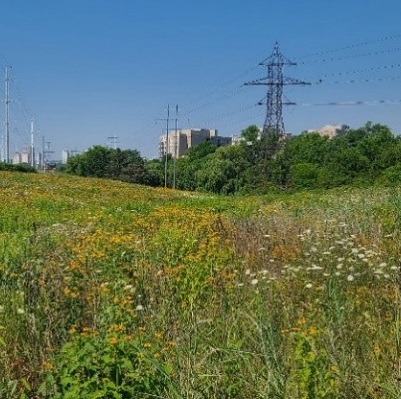
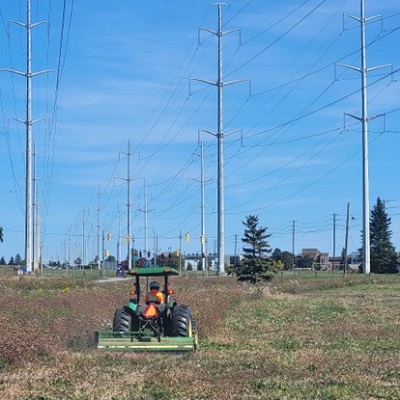
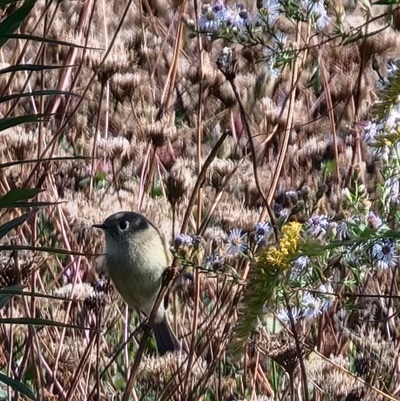
SECTION 2
The meadow areas from west of Warden to Kennedy Road south of Lawrence completed their second year of growth in 2022 and had a phenomenal year as species diversity increased and plants matured.
A lot of work was completed in these areas by restoration staff to conduct maintenance mows, invasive species management, overseeding trials and the mowing of the buffers along the meadow edges.
Seed collection also occurred here as we try to source our own seed for new sections.
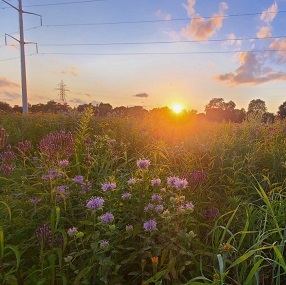
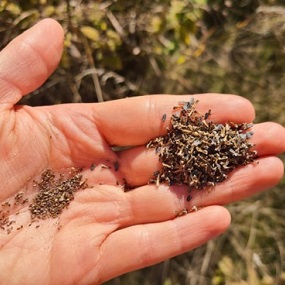
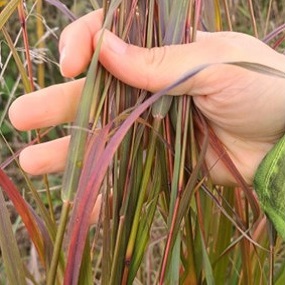
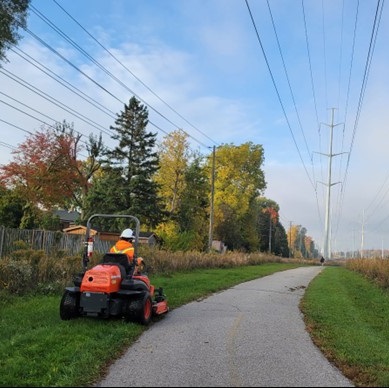
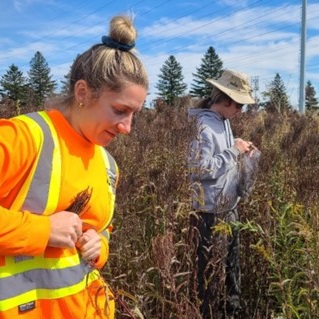
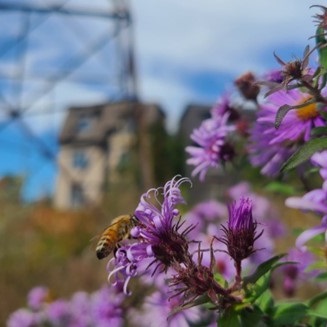
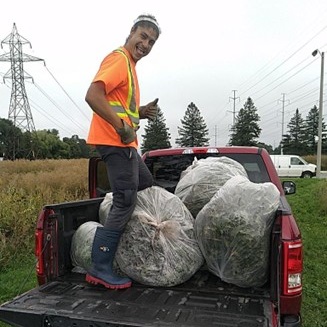
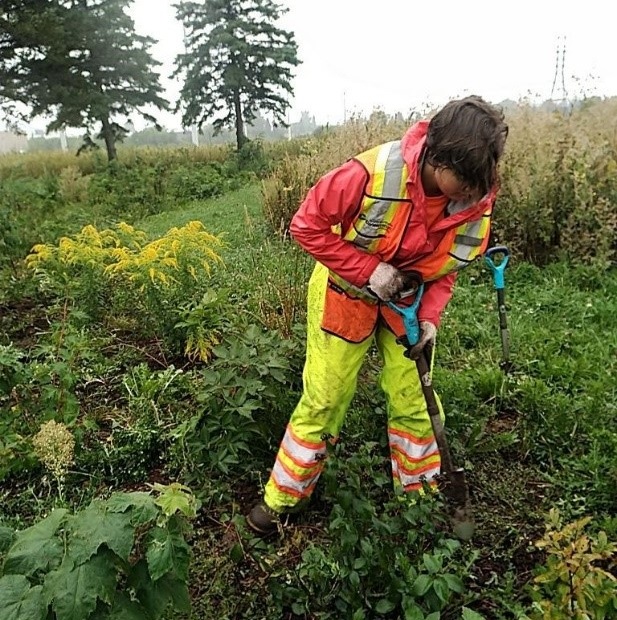
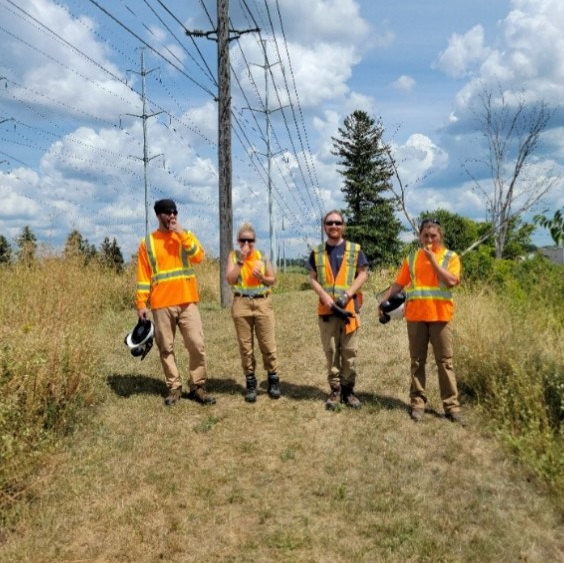
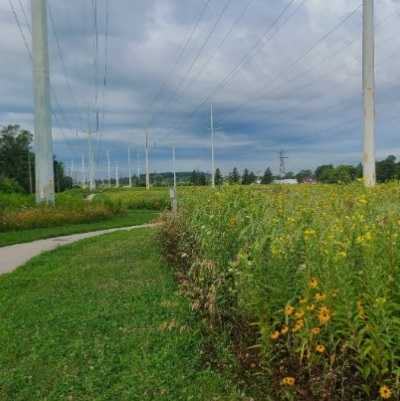
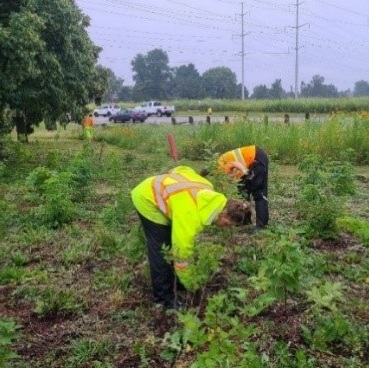
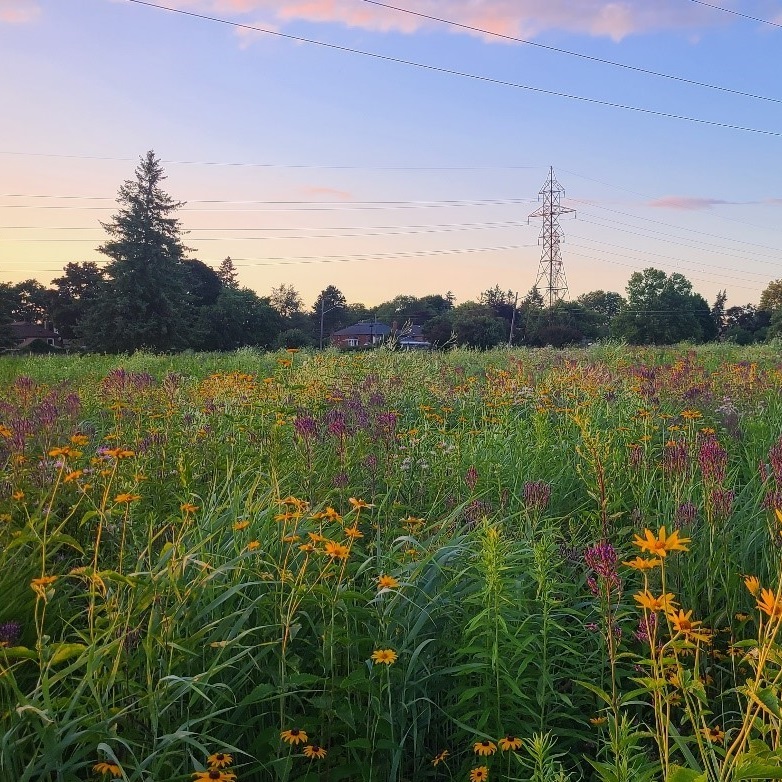
SECTION 4
This section, previously a part of the Scarborough Centre Butterfly Trail, runs from Thompson Memorial Park to Scarborough Golf Club Road and is the most mature meadow ecosystem within The Meadoway.
The Restoration team worked on activities such as maintenance mowing and invasive species management to encourage additional growth of native species and limit the establishment of the non-natives.
The eastern part of this section connects to the newly prepared meadow area (see before and after aerial images below), so trail users will be able to observe the differences and compare the more mature meadow to the new one as it ages.
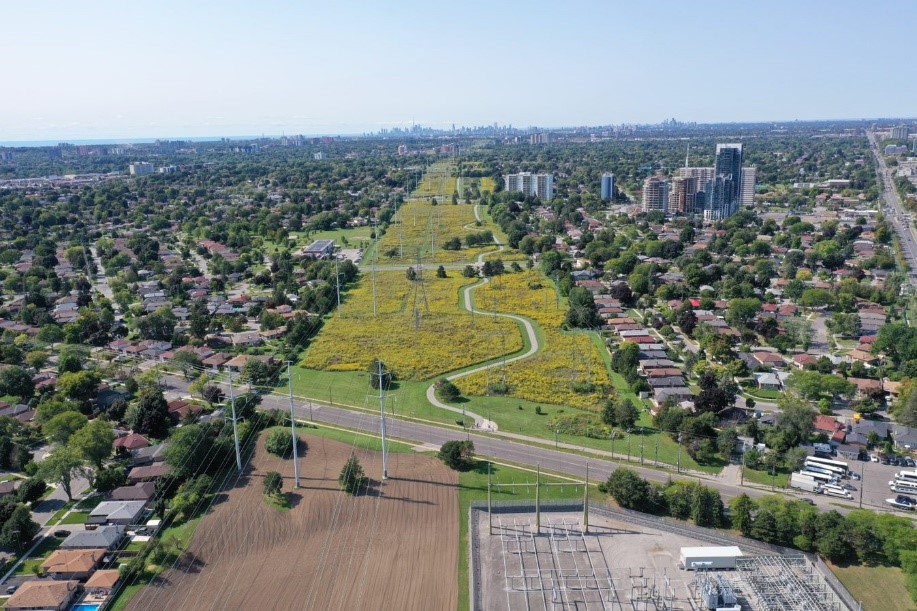
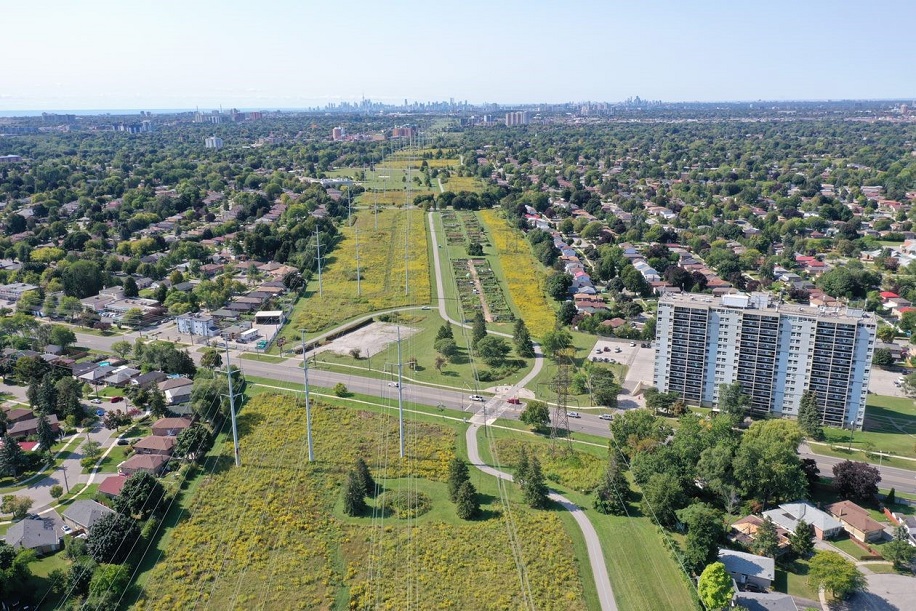
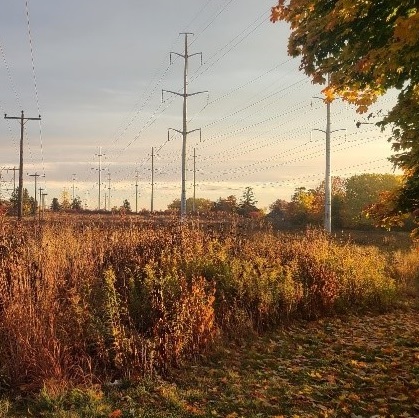
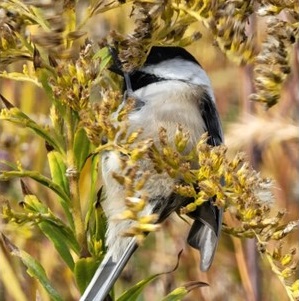
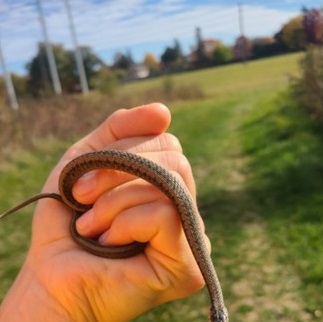
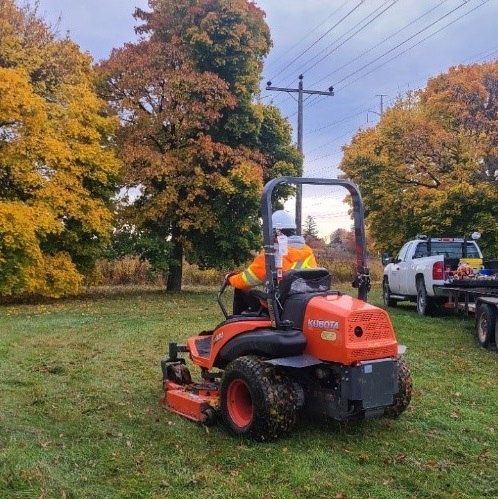
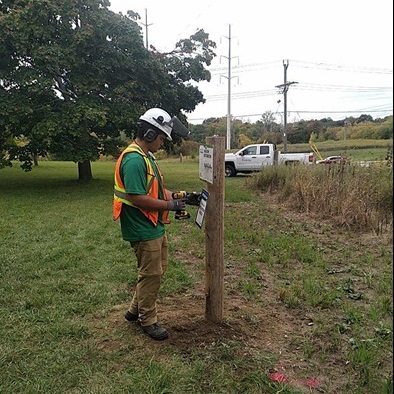
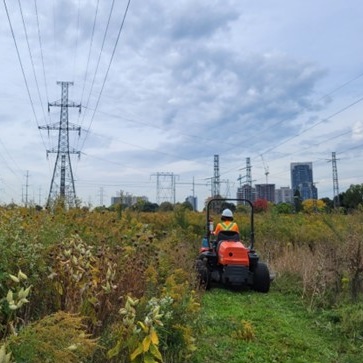

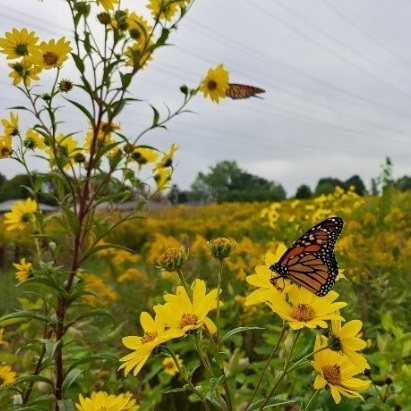
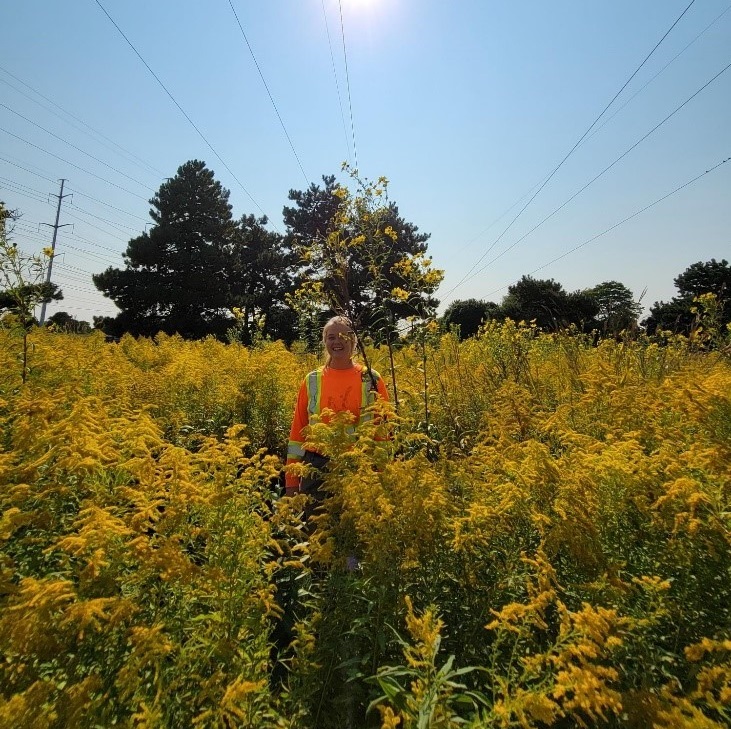
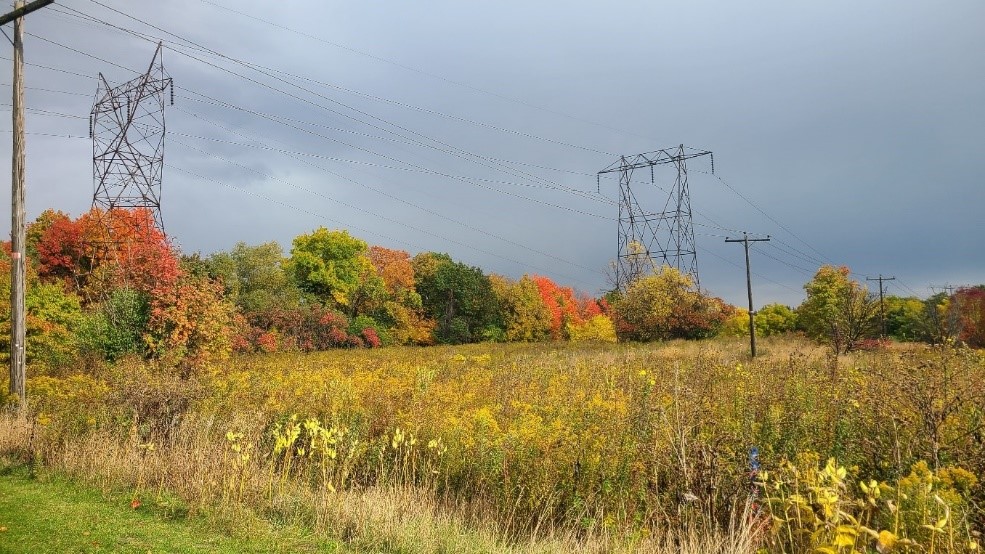
SECTION 5
The newest addition to The Meadoway is the section between Scarborough Golf Club Road and Neilson Road along Ellesmere Road.
This summer, the team completed four full rounds of site preparation on the 17ha of proposed meadow footprint. We were then able to put down our custom native seed mixes using our new seed drill, to ensure adequate spacing and uniformity.
The team also worked to prune back and mow the buffer areas around the meadow footprint, place informational signage, and remove the old tree stumps.
A lot of research was also conducted by the restoration team on topics like soil health, best practices for site preparation, and invasive species removal strategies.
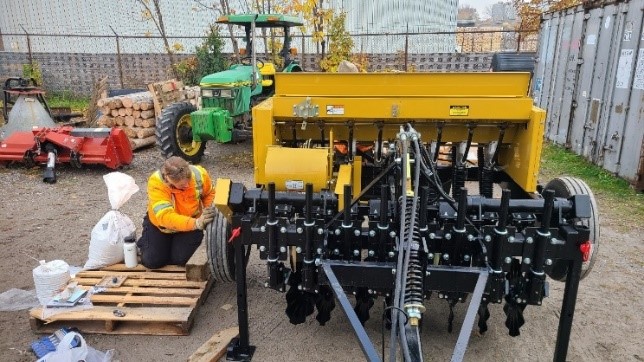
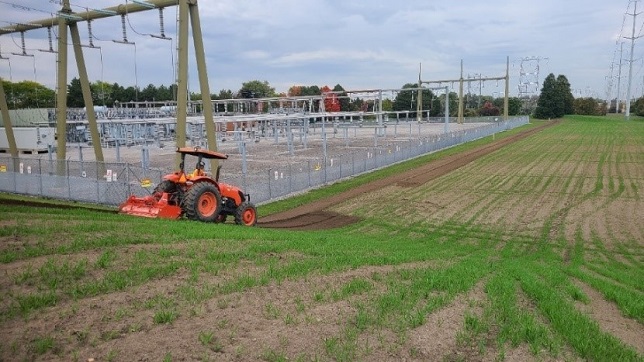
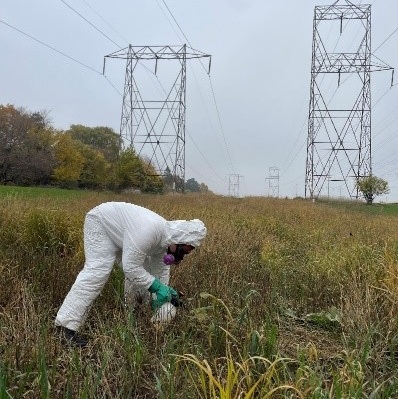
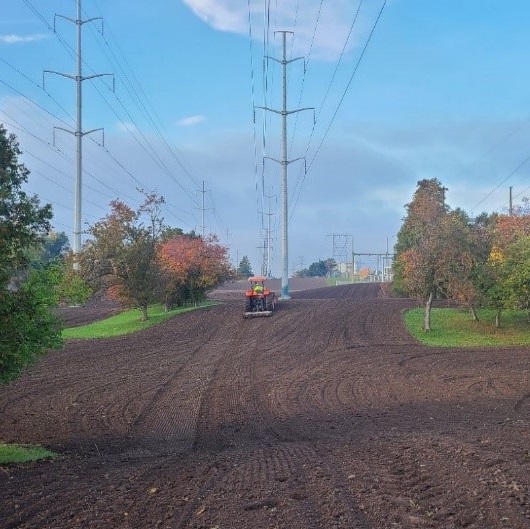
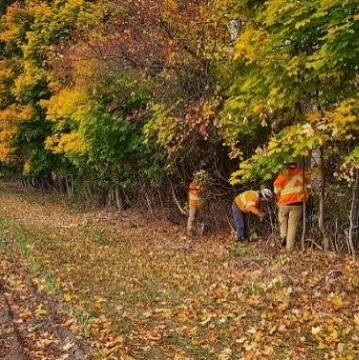
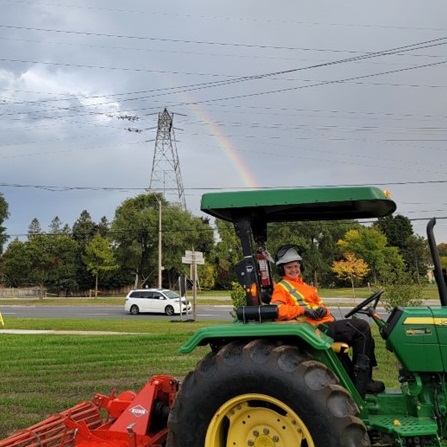
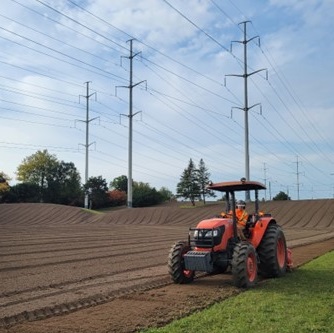
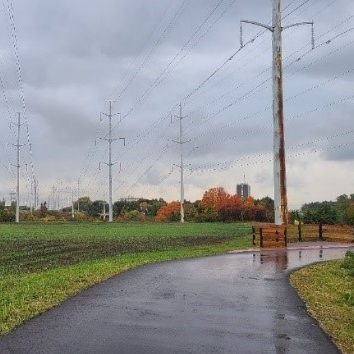
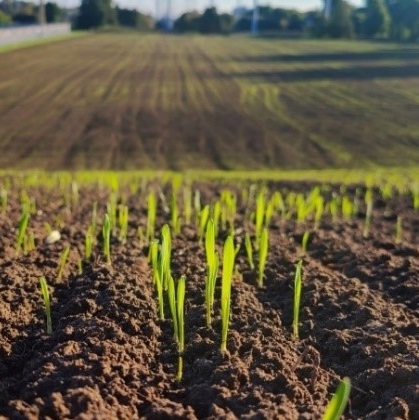
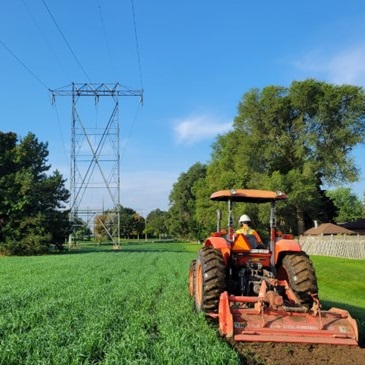
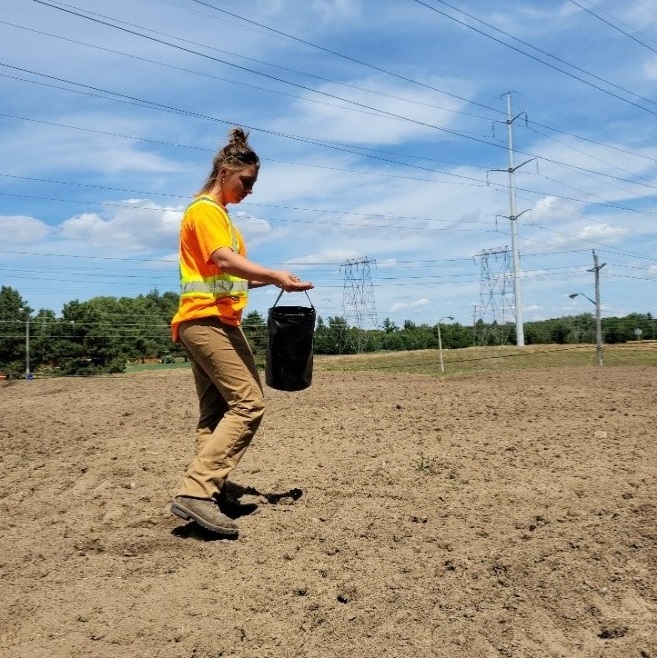
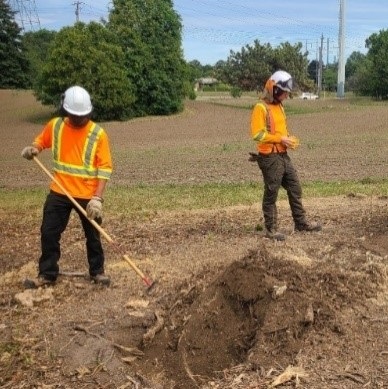
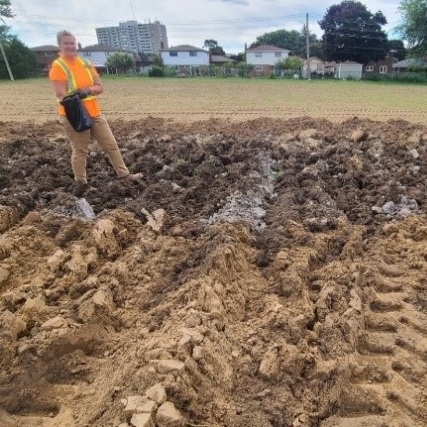
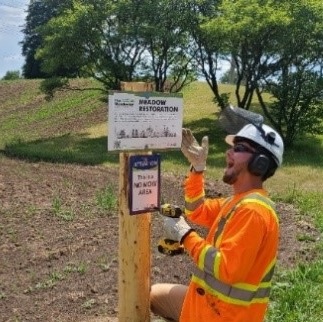
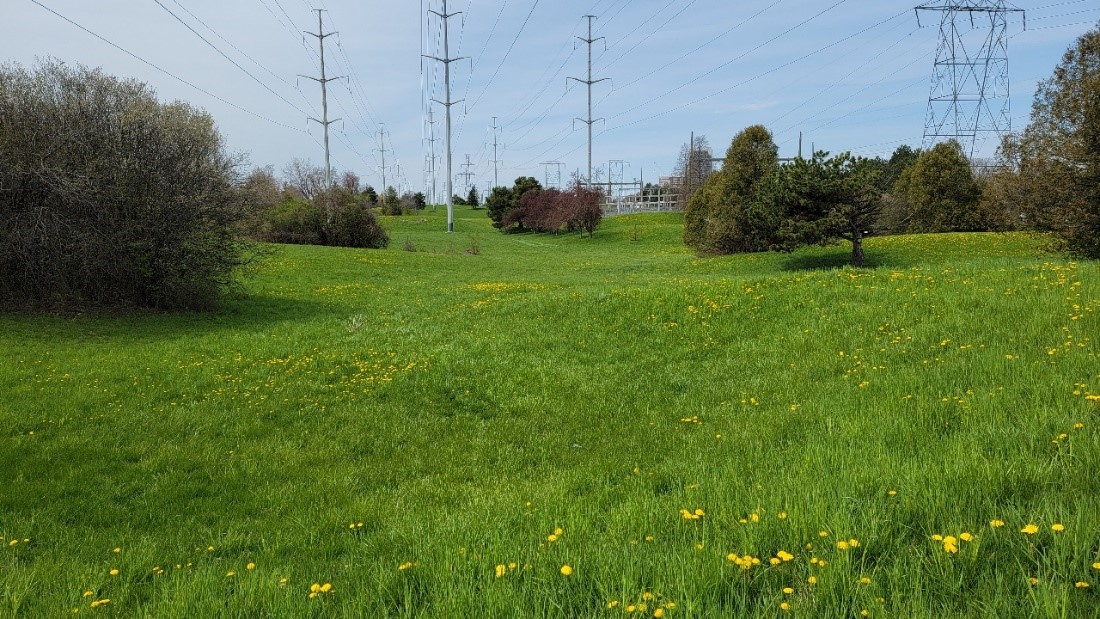
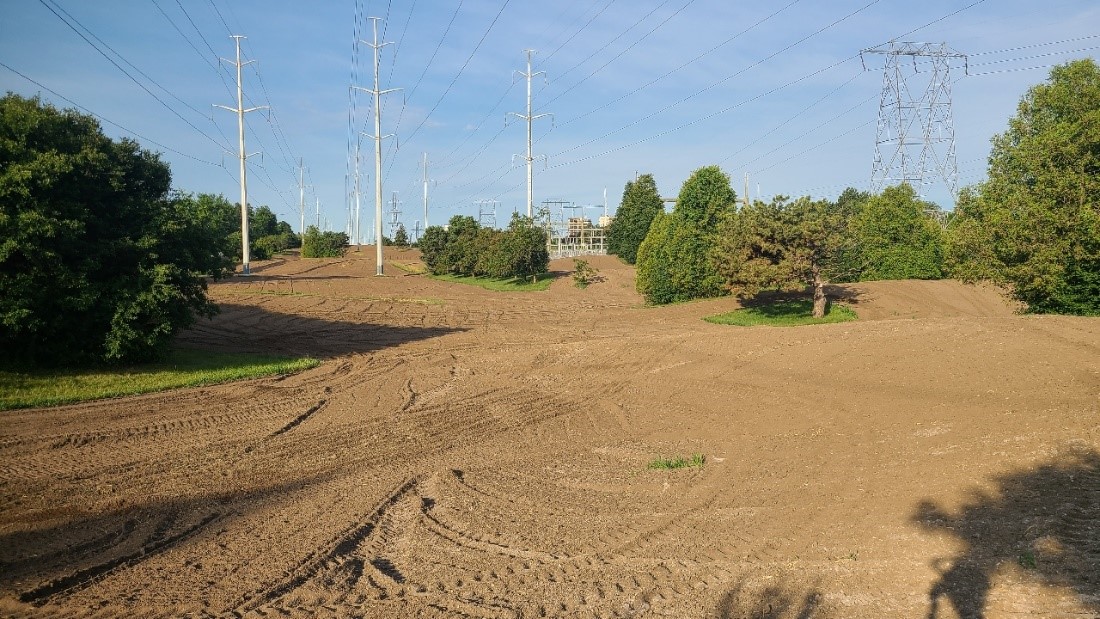
SECTION 7
The area north of the 401 from Conlins Road east to Meadowvale received a lot of invasive species management in 2022. Our restoration team did a great job removing the Spotted Knapweed and Tree of Heaven.
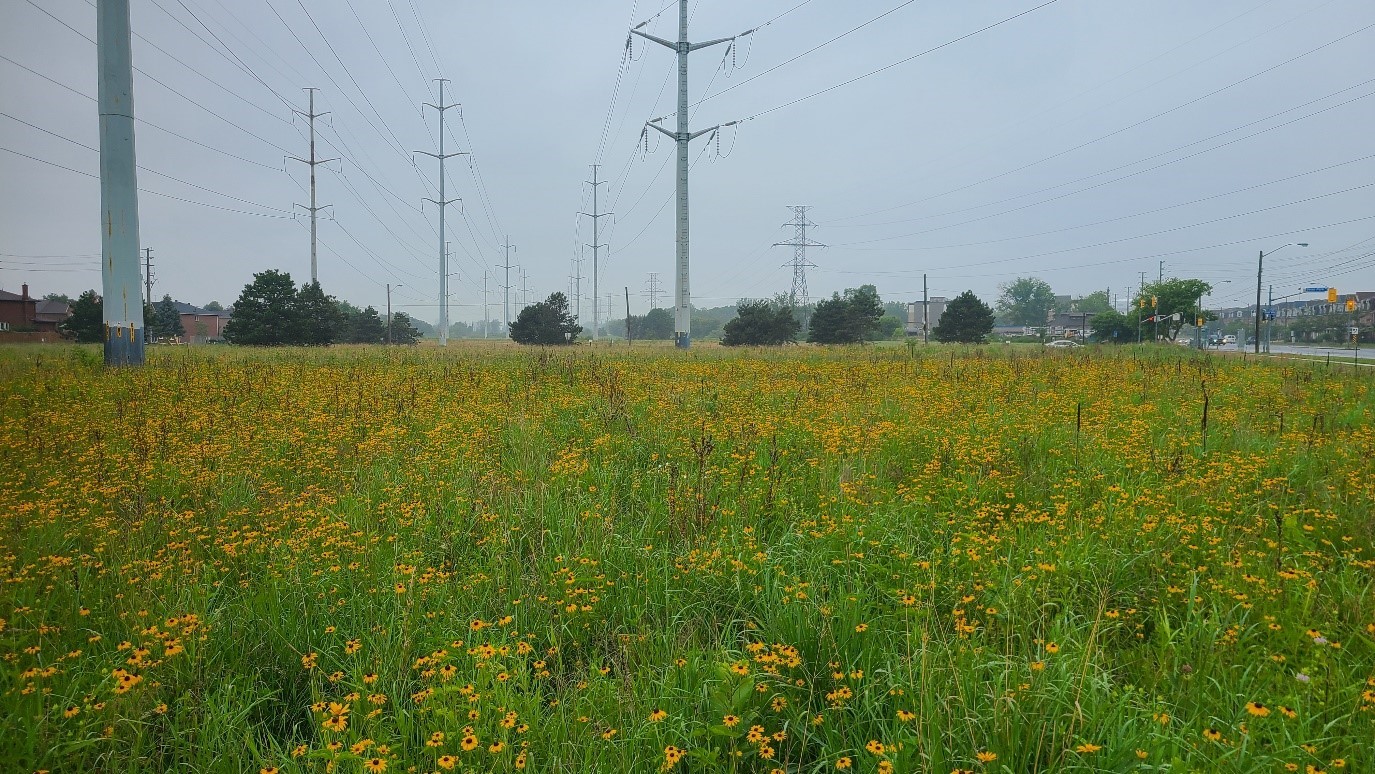
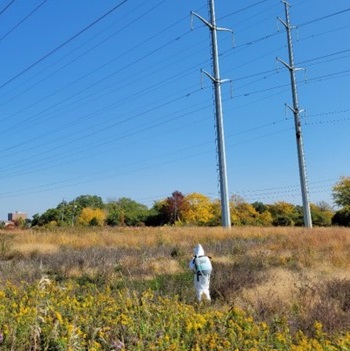
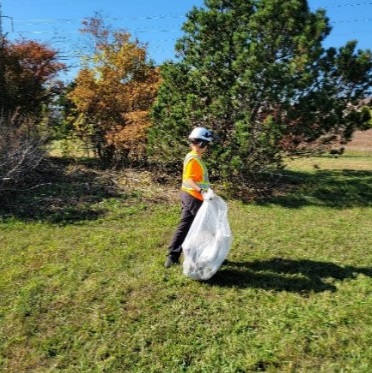
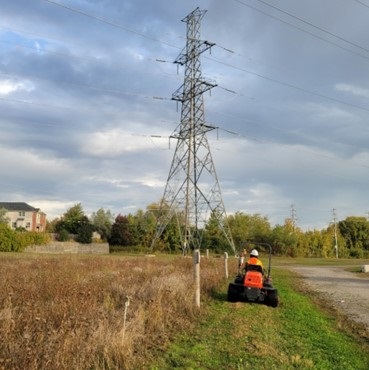
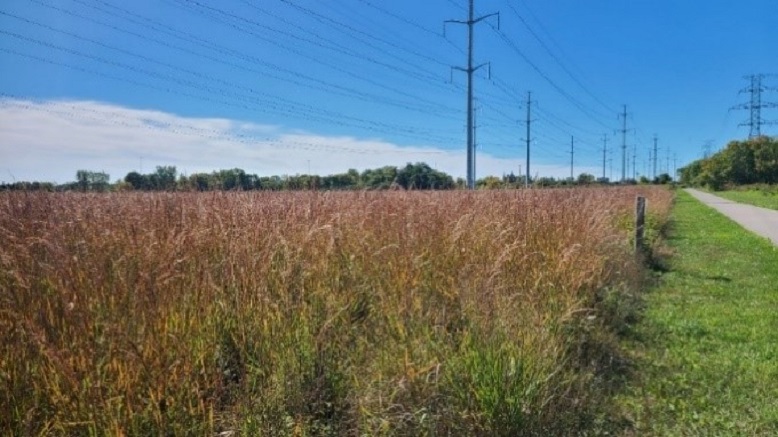
September 2022: The Permanent Bridge is Now in Place
September 2022
Some exciting news from The Meadoway: the permanent bridge is now in place!
Once complete, the bridge will take users over the East Highland Creek to an elevated boardwalk. An accessible switchback trail on the east slope of the ravine will take users back into the hydro corridor and newly restored meadow habitat, where it will connect to Neilson Road.
Bridging this gap in The Meadoway is a huge project milestone for this iconic trail system.
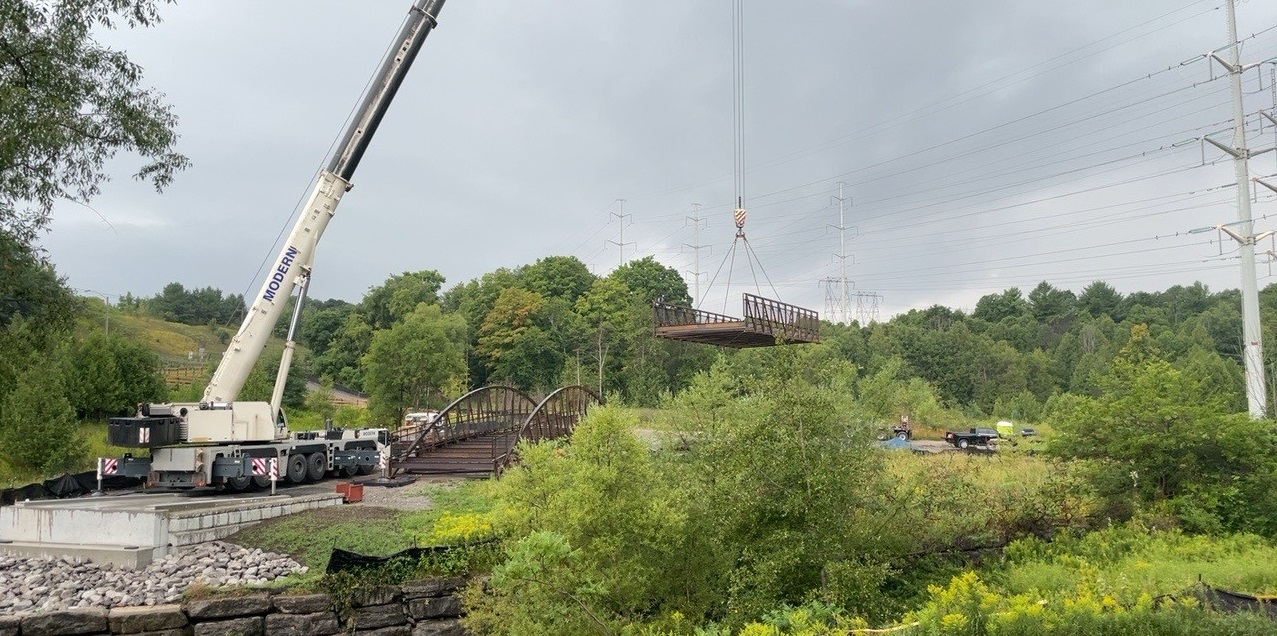
Following completion of the bridge installation and formalization of the switchback and at-grade trail, disturbed areas will receive a layer of topsoil and terraseeding, followed by additional planting by TRCA’s Restoration Ecosystem Management team in early 2023.
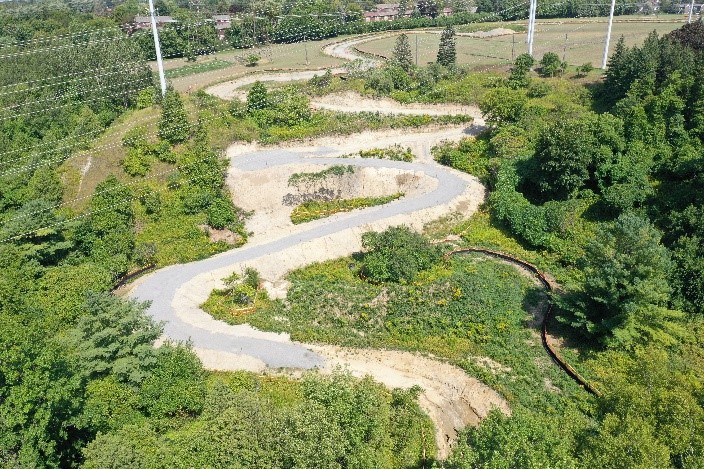
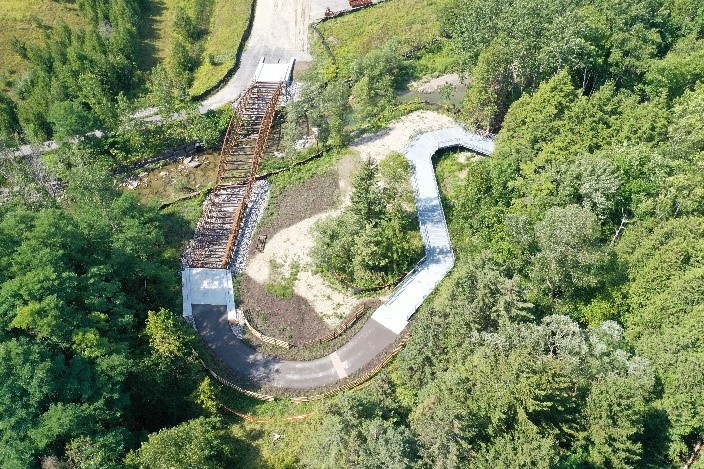
Stay tuned for updates on when construction of this section of The Meadoway, from Military Trail to Neilson Road, will be complete and open to the public.
July 2022: Paving and Fence Installation
July 2022
As shown in the photo below, paving and fence installation is well underway as crews work towards completing the Meadoway multi-use trail connection from Military Trail along Ellesmere Road to Neilson Road.
The next major milestone will be the installation of a permanent pedestrian/cycling bridge across East Highland Creek. Stay tuned!
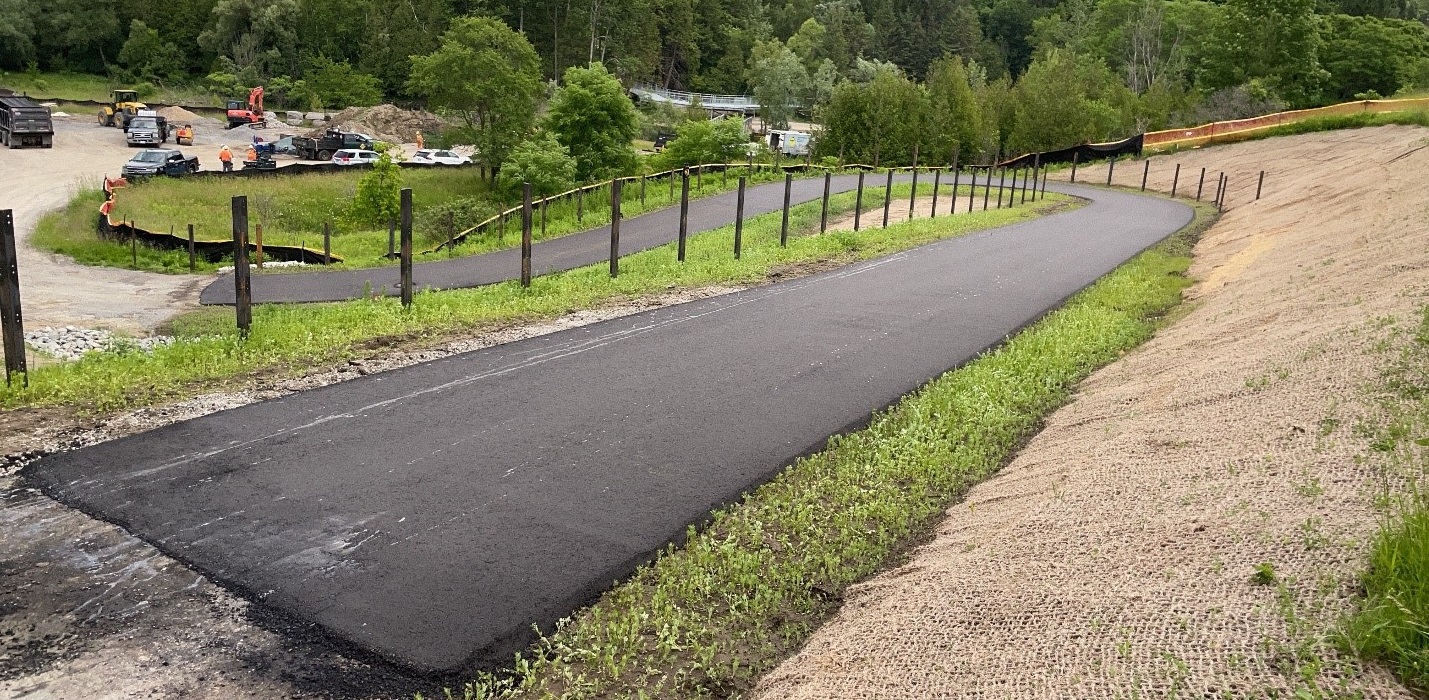
June 2022: Meadow Site Preparation
June 2022
Good news! Staff have begun meadow site preparation in the Highland Creek section of The Meadoway. Currently under construction, this section will form a key segment in the overall trail network.
Restoration staff have begun rototilling the turfgrass to help remove invasive species and prepare the soil for native seeding. This will occur several times throughout the summer to ensure the area is ready for seeding this fall.
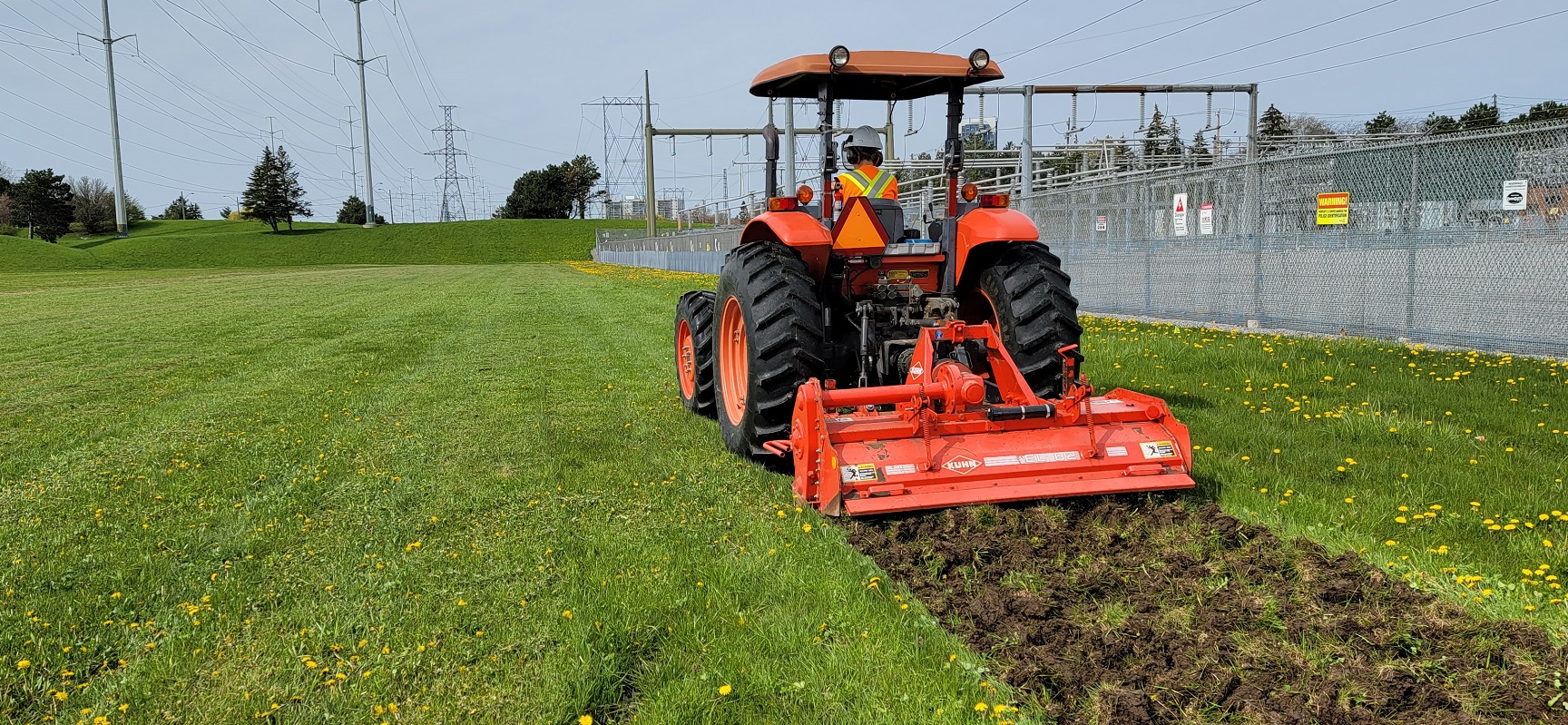
Did you know that by keeping the turfgrass around the meadow footprint mowed, sightlines along the trail are maintained and the spread of invasive species in the meadow and adjacent properties is reduced?
With the warmer temperatures and spring rain, the turfgrass and meadow have grown substantially in the last month. Restoration staff have been working to keep the turfgrass at bay while allowing the meadow to flourish in time for summer.
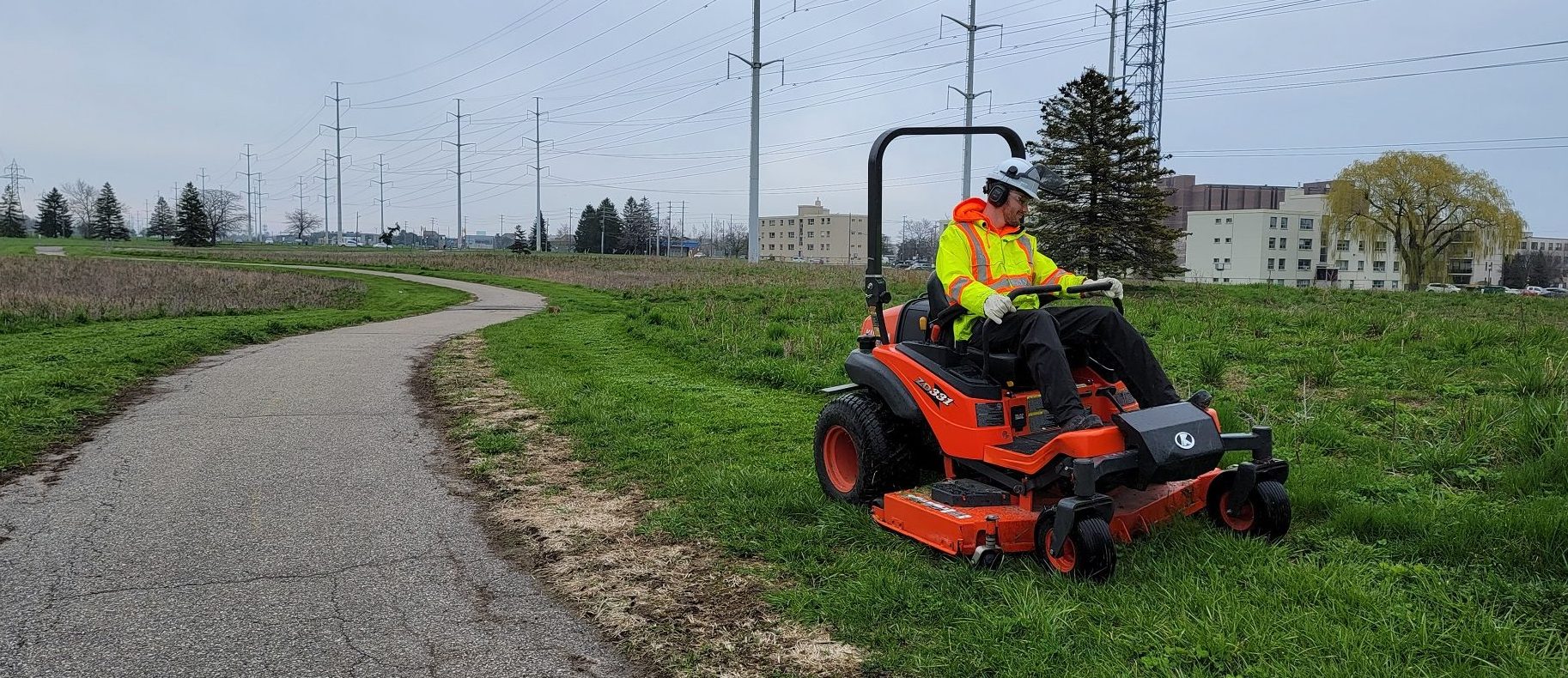
Maintenance mowing in the established meadow sections is also an important part of the job!
Mowing the meadow helps to increase the breakdown of the dead standing plant material. Doing this exposes bare soil and increases seed germination, helping plants to grow.
This would naturally be done through large animal grazing or fire, but staff are able to mimic these practices through mowing.
Restoration staff take extra caution to ensure that mowing occurs before birds return to The Meadoway to breed.
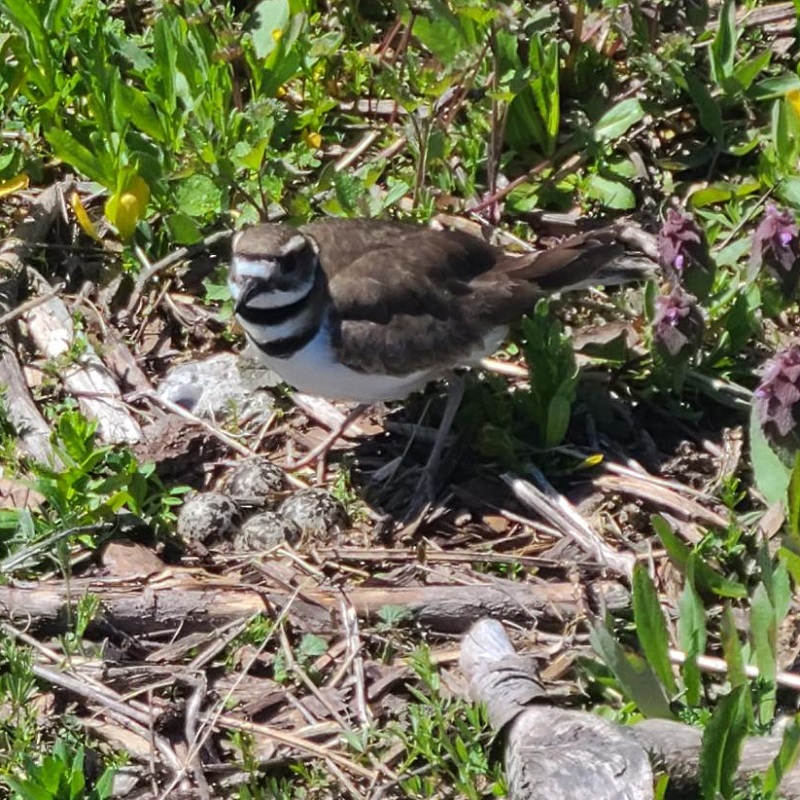
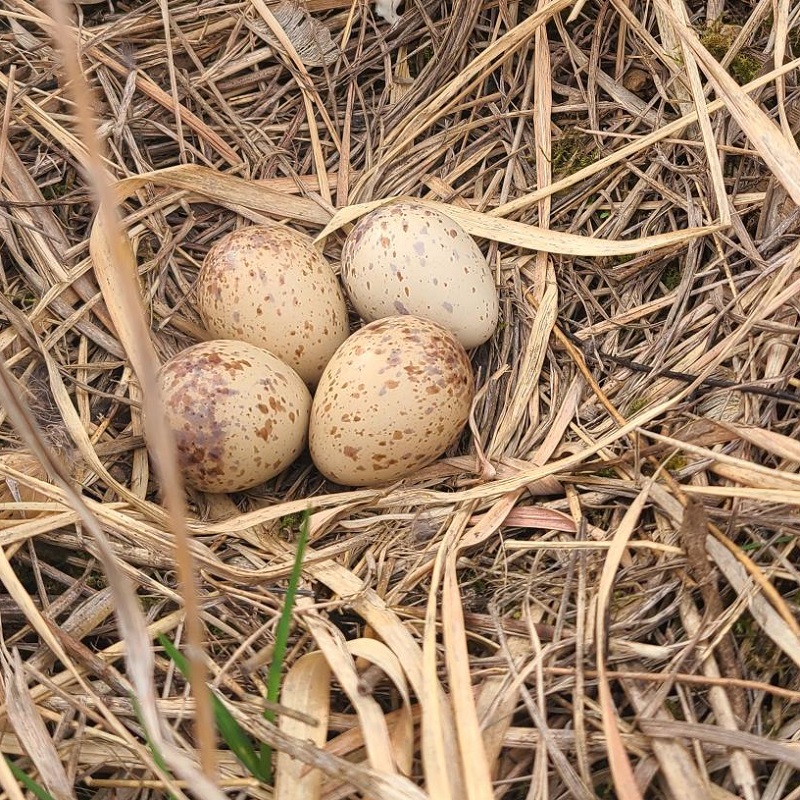
January 2022: Notice of Construction
The Meadoway Multi-use Trail: Section 5 Highland Creek – Phase 2 – VIEW THE NOTICE OF CONSTRUCTION
November 25, 2020: A Brownie Award for The Meadoway
TRCA Wins 2020 Brownie Award for The Meadoway
Toronto and Region Conservation Authority (TRCA) is thrilled to be this year’s recipient of the prestigious “Reach Out” Brownie award for The Meadoway.
Founded by the Canadian Urban Institute, the Brownie Awards recognize innovative rehabilitation efforts by organizations focusing on under-utilized and underdeveloped spaces by remaking them into projects that contribute to healthy communities. The awards are an annual celebration of the outstanding work in remediation and redevelopment of brownfield sites across Canada.
The “Reach Out” award is for excellence in communications, marketing, and public engagement. It recognizes TRCA’s collaboration with Toronto design firm Perkins&Will, which featured a suite of digital tools to help tell The Meadoway story.
The resulting Visualization Toolkit includes experiential elements such as augmented reality, animations, videos and conceptional renderings (like the one shown below) from Future Landscapes. The result is a high-tech, compelling visual identity and narrative.
This past spring, the toolkit also played an important role in helping The Meadoway join the prestigious High Line Network in New York.
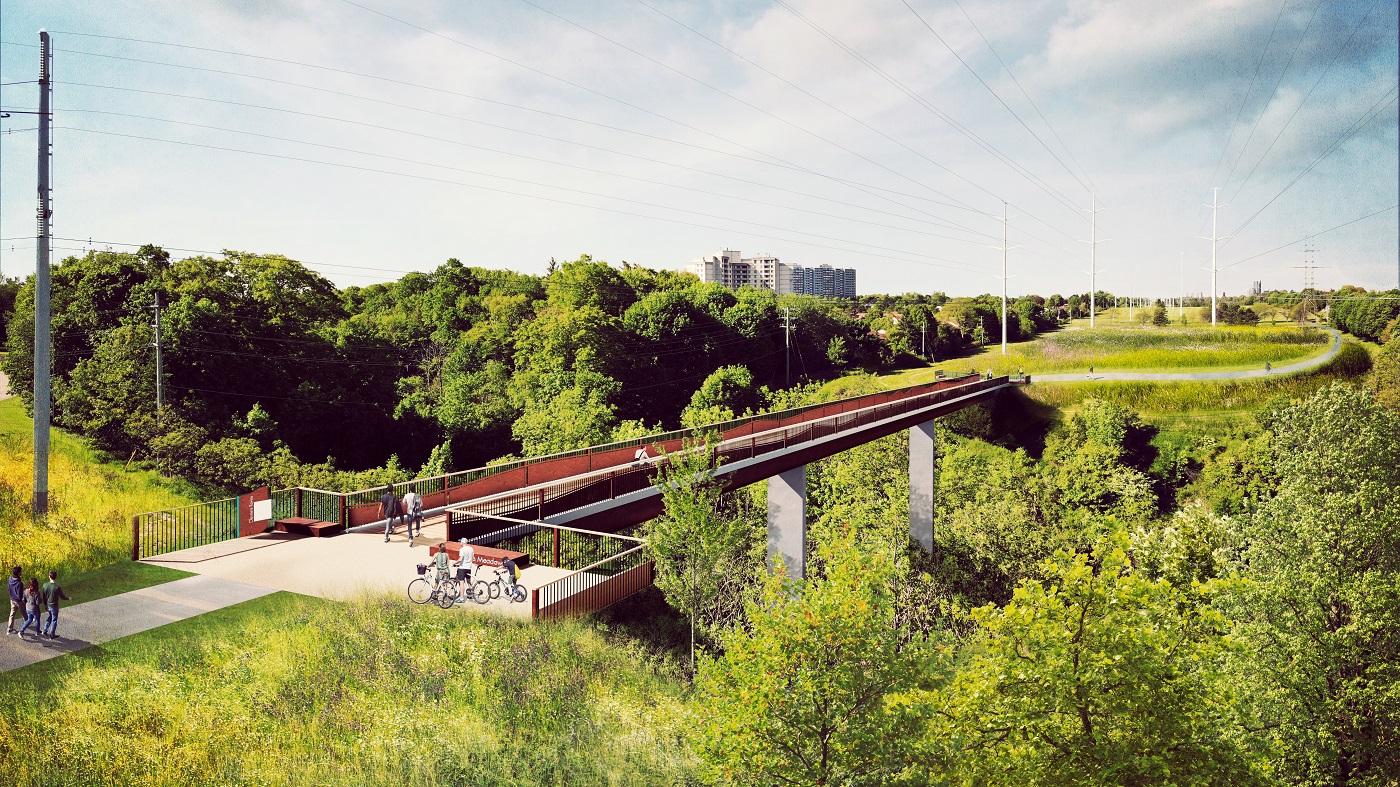
“It’s an honour for TRCA to be recognized for its innovation and dedication to building a thriving greenspace for residents of the City of Toronto. It has never been more important for people to be outside and connect with nature. The revitalization of this space, including a multi-use trail through-out a hydro corridor, will transform the way people move in the city.” – Jennifer Innis, Chair of TRCA’s Board of Directors
“Meaningful communications and community engagement play such a critical role in the ongoing and future success of The Meadoway. As the lead funder of the initiative, our Foundation applauds TRCA for its tremendous efforts to work with the many communities surrounding The Meadoway to ensure it meets the needs of, and is celebrated by, local residents. Congratulations to TRCA and Perkins&Will for this well-deserved award.” – Tamara Rebanks, Chair of Weston Family Foundation
The Meadoway will allow users to get up close and personal with the natural environment. We are transforming more than 200 hectares of turf grass into a thriving meadow, creating habitat for native plants, pollinators and wildlife.
The 16-km multi-use trail will travel across Scarborough, connecting Rouge National Urban Park with the East Don trail system leading to the Toronto downtown core.
The Meadoway will also connect 70 schools, 34 neighbourhoods, and 15 parks and will also provide a critical connection between Toronto’s ravine system.
September 22, 2020: A New Look for The Meadoway
A NEW Look for The Meadoway!
There’s nothing like a fresh coat of paint to make things pop!
In our efforts to let people know they’ve arrived in The Meadoway, we’ve added our colours onto the trail. A brilliant blue line has been painted down the centre of the path to separate direction of traffic.
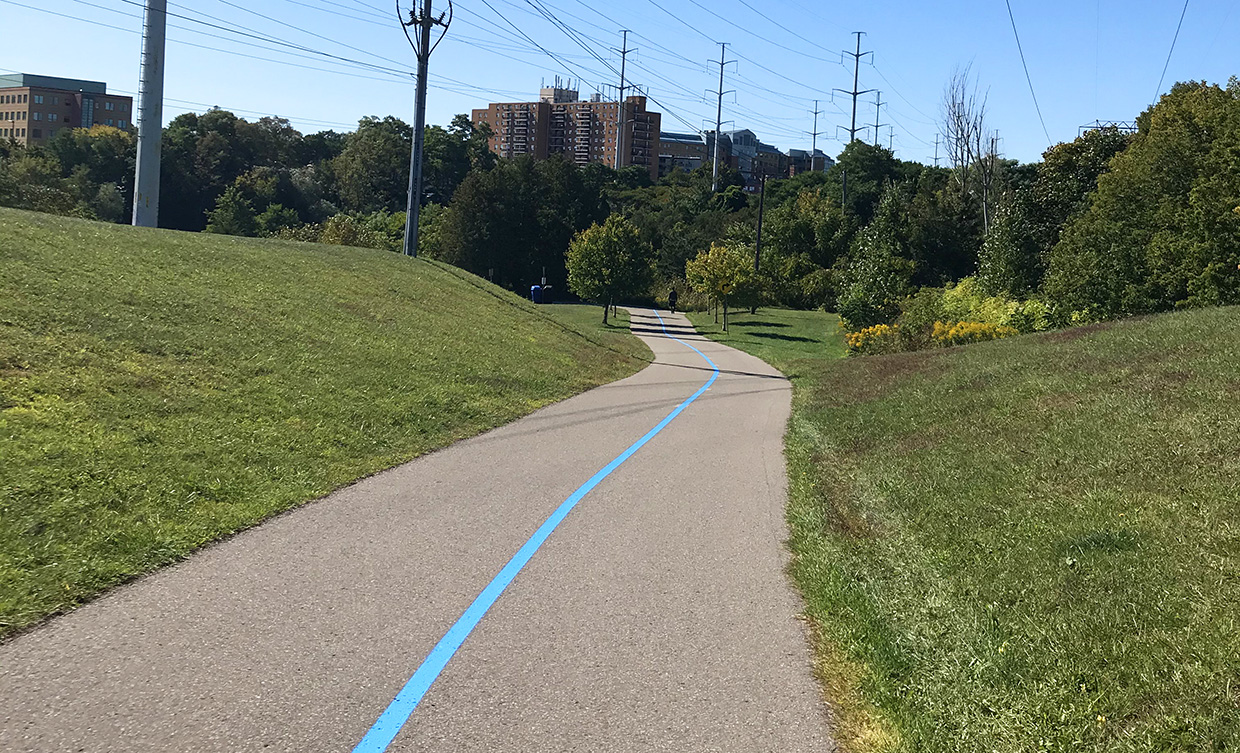
Green logos have also been added at many of the crosswalks. Now it’s easier than ever to recognize The Meadoway.
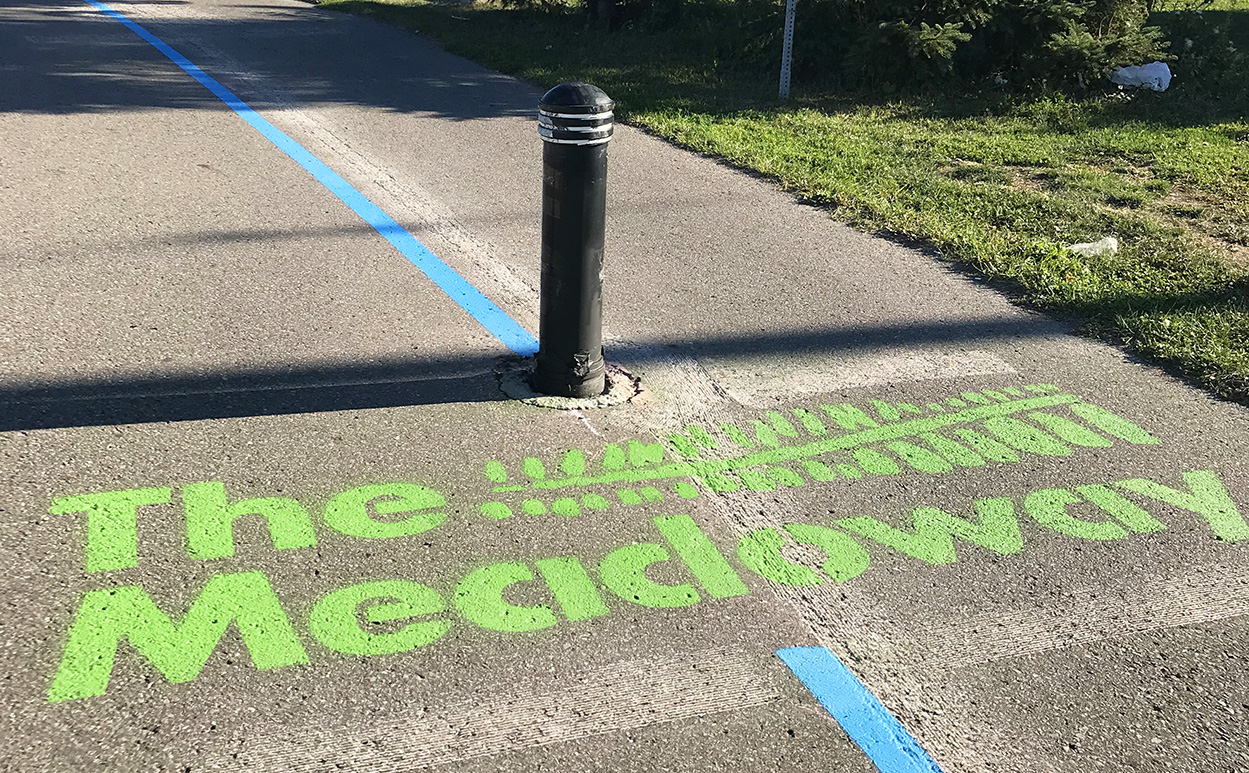
Phase one of The Meadoway, extending from Brimley Road to Scarborough Golf Club Road, is the first completed section of Toronto’s newest linear greenway project. It features 3.5 kilometres of continuous multi-use trail with pedestrian crossings and fully restored, thriving meadows.
With the meadows now in full bloom, this the perfect time to visit. Check out the public access map to find the entry points closest to you!
August 26, 2020: Adaptive Management
UPDATE: August 26, 2020
We often use the term adaptive management when describing the important work our crew regularly focuses on in The Meadoway. What does that mean for our project?
Adaptive management requires our team to stay attentive and nimble. We are always monitoring and assessing how each section adapts to site preparation and native meadow restoration.
Each section of The Meadoway is completely different, due to the variety of soil types found across its 16-kilometre span. This and other factors, including the timing of seeding (spring, fall, or winter) and climate-related concerns ranging from drought to heavy rain events, play a decisive role in creating and adjusting the adaptive management plan for each section.
For example, in Section 7, southeast of Dean Park Road and Sheppard Avenue East, we seeded native wildflowers and grasses in the spring. Adaptive management on this 1.5-hectare parcel of land included adding a nurse crop of oats (pictured below) to help protect the native seeds from the summer drought in July by providing increased shade.
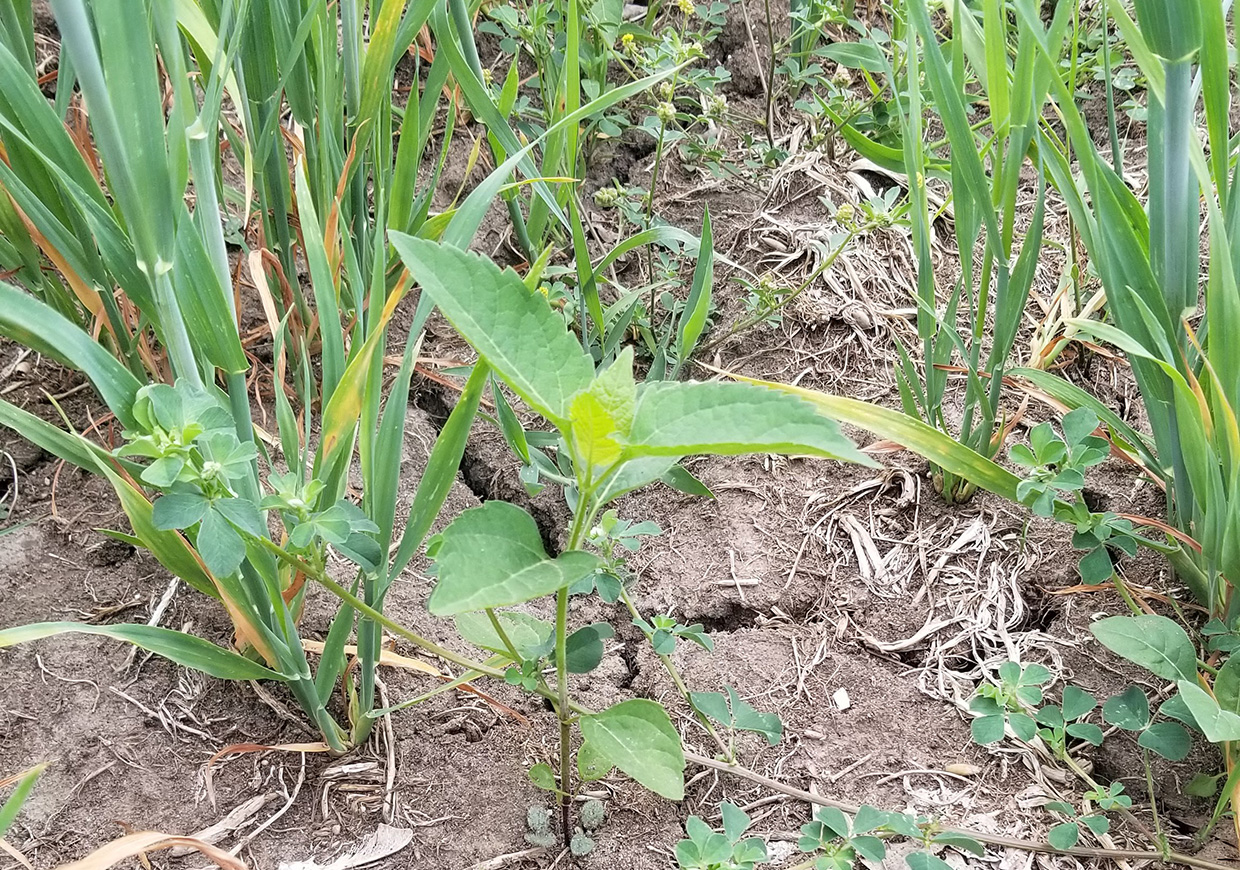
Our ongoing work against invasive species continues this week with a focus on Canada thistle and spotted knapweed. We are always looking for new methods and environmentally friendly treatments.
We are experimenting with a supplier who uses hot steam to eradicate invasive species. We are monitoring the experimental plots closely and will compare results with a variety of other methods.
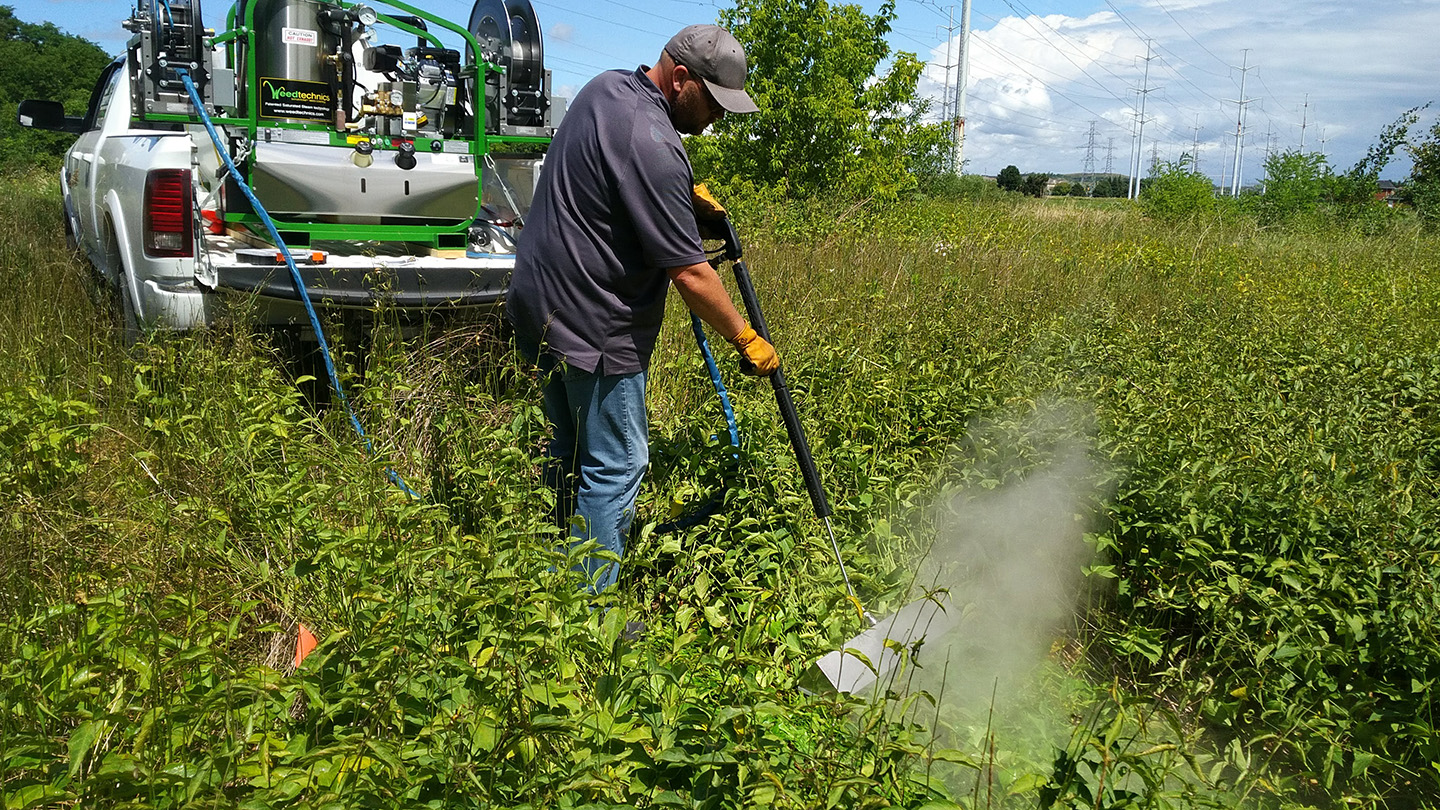
Site preparation continues in earnest as we work towards our goal of a fully seeded Meadoway by 2024.
What’s blooming now in The Meadoway? Bergamot (Monarda fistulosa) with a visitor: a silver spotted skipper butterfly (Epargyreus clarus).
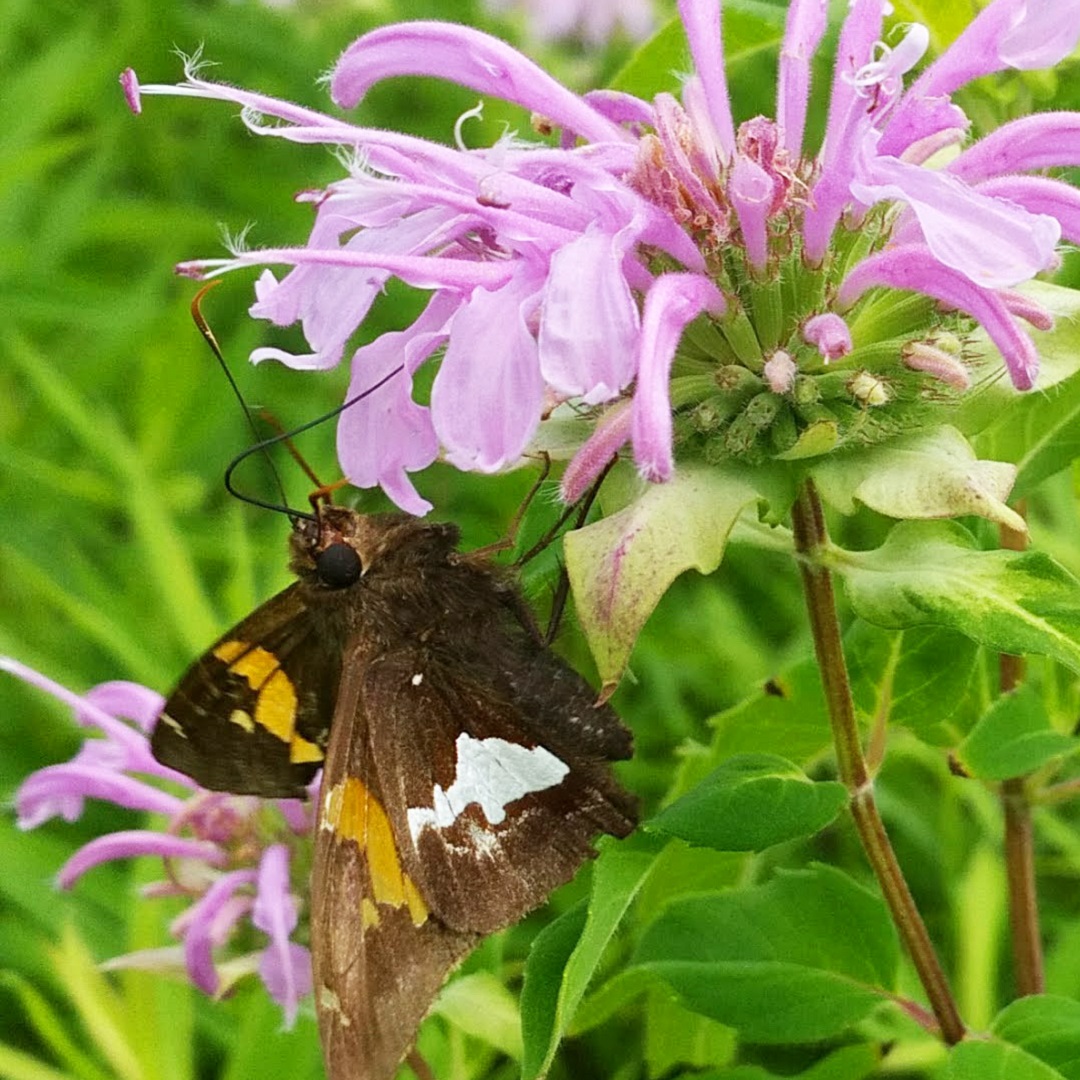
July 30, 2020: State of the Soil
UPDATE: July 30, 2020
Good news! Soil conditions have improved after The Meadoway received some much-needed rain this week.
Preparing the ground for planting native species this fall involves churning up the soil with heavy equipment. During dry conditions, this generates an enormous amount of dust and dirt.
Now that there’s been some rain, you’ll see crews back in the corridor working the soil.
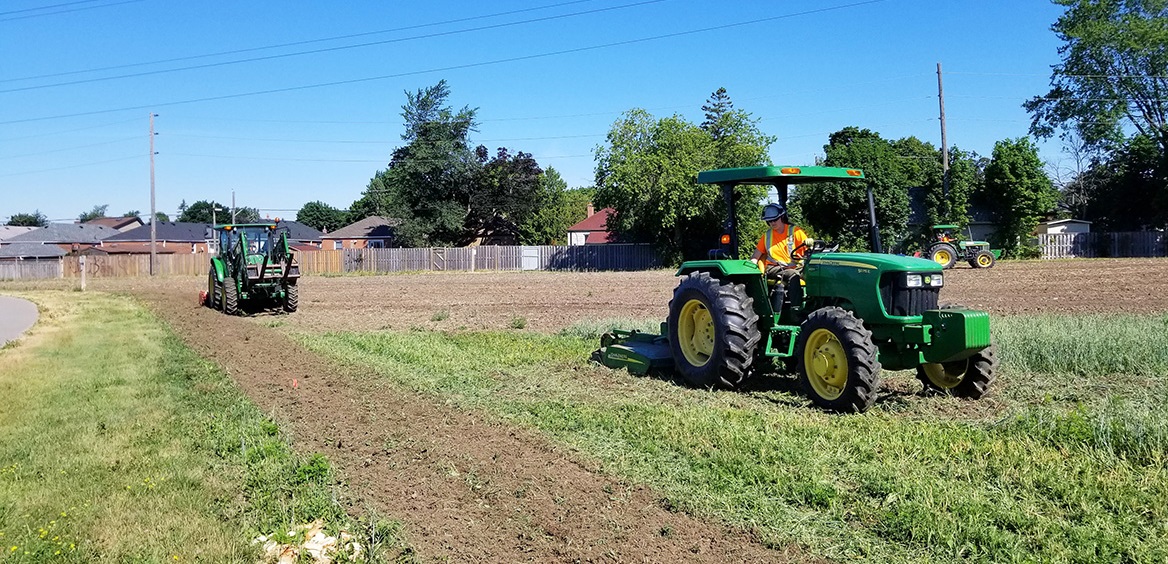
We often talk about the advantages of native meadow plants and their long root structures. Even with weeks of very little precipitation, there is no sign of heat stress on the native plants.
Our restoration team has also adjusted their site preparation due to the intense heat. The “nurse crop”, which was seeded with the native wildflowers and grasses this spring, has been able to protect the new native seedlings while they grow during periods of drought.
The native plants benefit from the shade of the nurse crop, and the nurse crop also helps to push out any non-desired species trying to push through.
Newly seeded native plants are thriving in The Meadoway. If the nurse crop becomes too tall or thick, it will be given a high mow cut to help open sunlight for the native species below.
Tackling invasive species is an ongoing challenge. Pulling them by hand is hard work — but necessary to keep the meadow healthy.
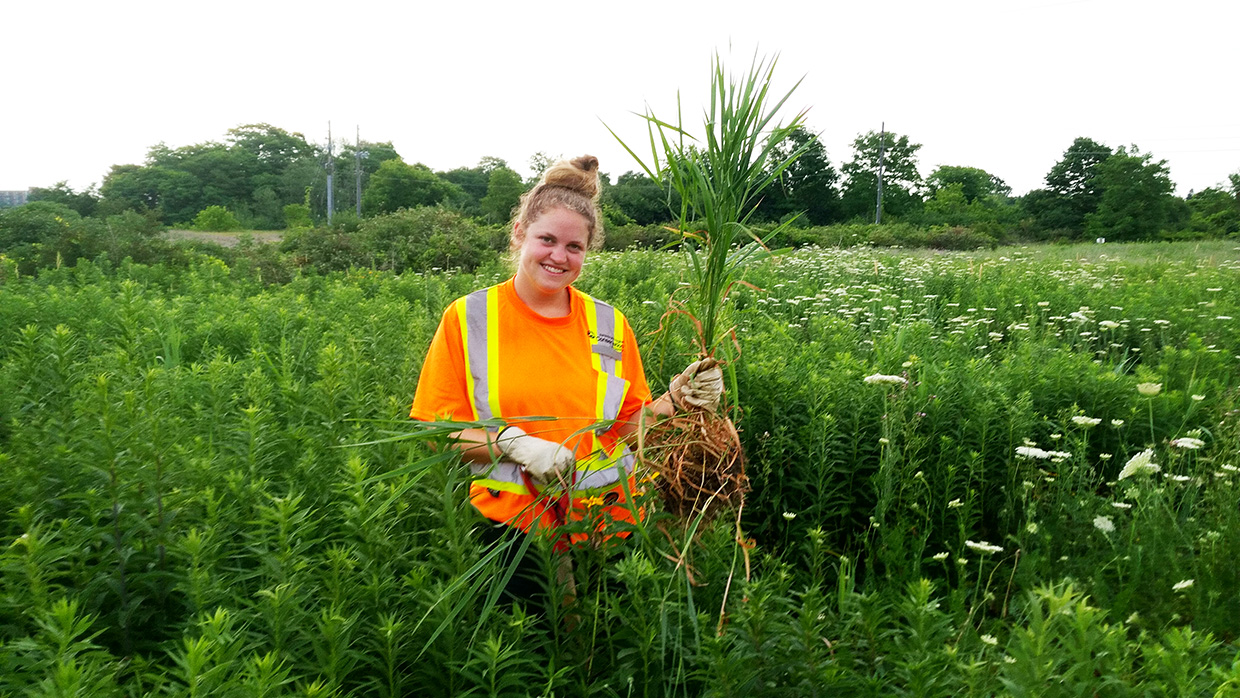
There’s no doubt the colour yellow pops this time of year, thanks to one of our Meadoway marvels.
False sunflower (Heliopsis helianthoides) looks similar to another familiar Meadoway denizen, the cup plant. However, the false sunflower’s leaves don’t clasp the stem to form the distinctive “cup” feature that gives the cup plant its name. Instead, the leaves attach to the stem with thin stalks.
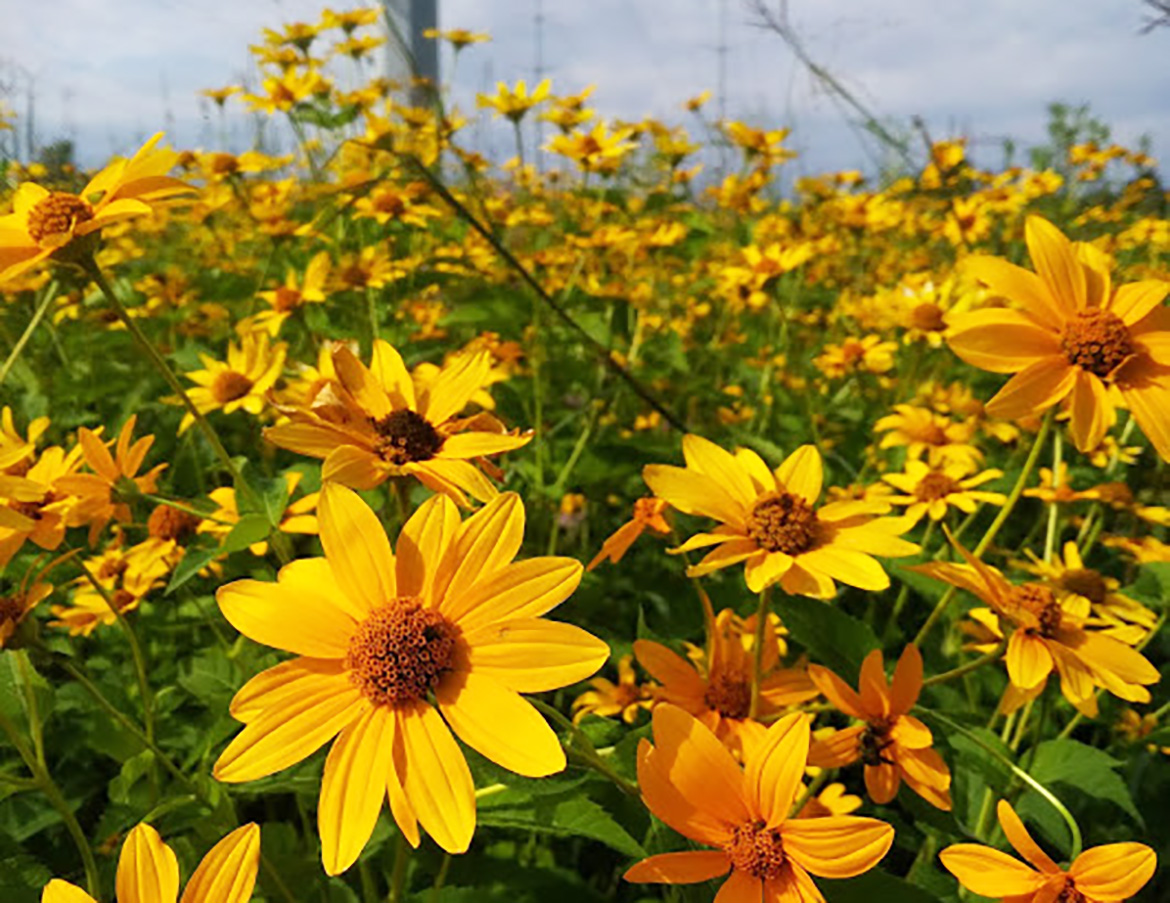
July 16, 2020: A Living Lab Underneath a Hydro Corridor
A Living Lab Underneath a Hydro Corridor
Connecting an urban community with nature is at the heart of The Meadoway.
The project is also a model for how the conversion of mown grass to native meadow habitat in urban environments can help mitigate the effects of climate change — including providing protection against flooding, reducing invasive species, and improving air quality.
Scientific research is a key component to The Meadoway story.
There are a variety of investigative projects underway, including a partnership with the University of Toronto’s Dr. Jennifer Drake to examine the hydrologic improvement brought on by meadow restoration.
The goal is to track and predict the performance of The Meadoway’s flood control capacity under various climate scenarios.
To begin, Dr. Drake and a team from Toronto and Region Conservation Authority (TRCA) set up a series of experiments on a particularly hot day in July to measure and contrast the “infiltration rates” of established meadow versus mown grass test plots.
A common technique in hydrology and soil science, infiltration rate is the speed at which water on the ground surface enters the soil.
Harder, more compacted soils with little vegetation (such as lawns) typically have lower infiltration rates, which can slow or prevent rainwater from entering the soil during a rain event, and which and contributes to flooding.
By introducing diverse meadow species with deep roots that break-up the soil and soak up water, it is hypothesized that The Meadoway will function as a sponge during storms and reduce the amount of rainwater that flows into city streets and rivers.
Dr. Drake and her team are aiming to test that theory, and will be collecting data throughout 2020 that will be analyzed for a range of issues, including the effects that meadow restoration has on soil properties, nutrient retention, and the response of ecosystems to changing hydrologic conditions.
The work has just begun! Stay tuned for more research highlights as we continue to gather data and uncover the impacts of transforming an under-utilized corridor into a vibrant greenspace and urban connecter.
June 29, 2020: The Meadoway Invited to Join the Prestigious High Line Network
The Meadoway Invited to Join the Prestigious High Line Network
The High Line Network fosters collaboration between infrastructure project teams to help these valuable community initiatives reach their full potential. This is only the second time in the Network’s history that the highly-regarded organization has extended an invitation to a Canadian project.
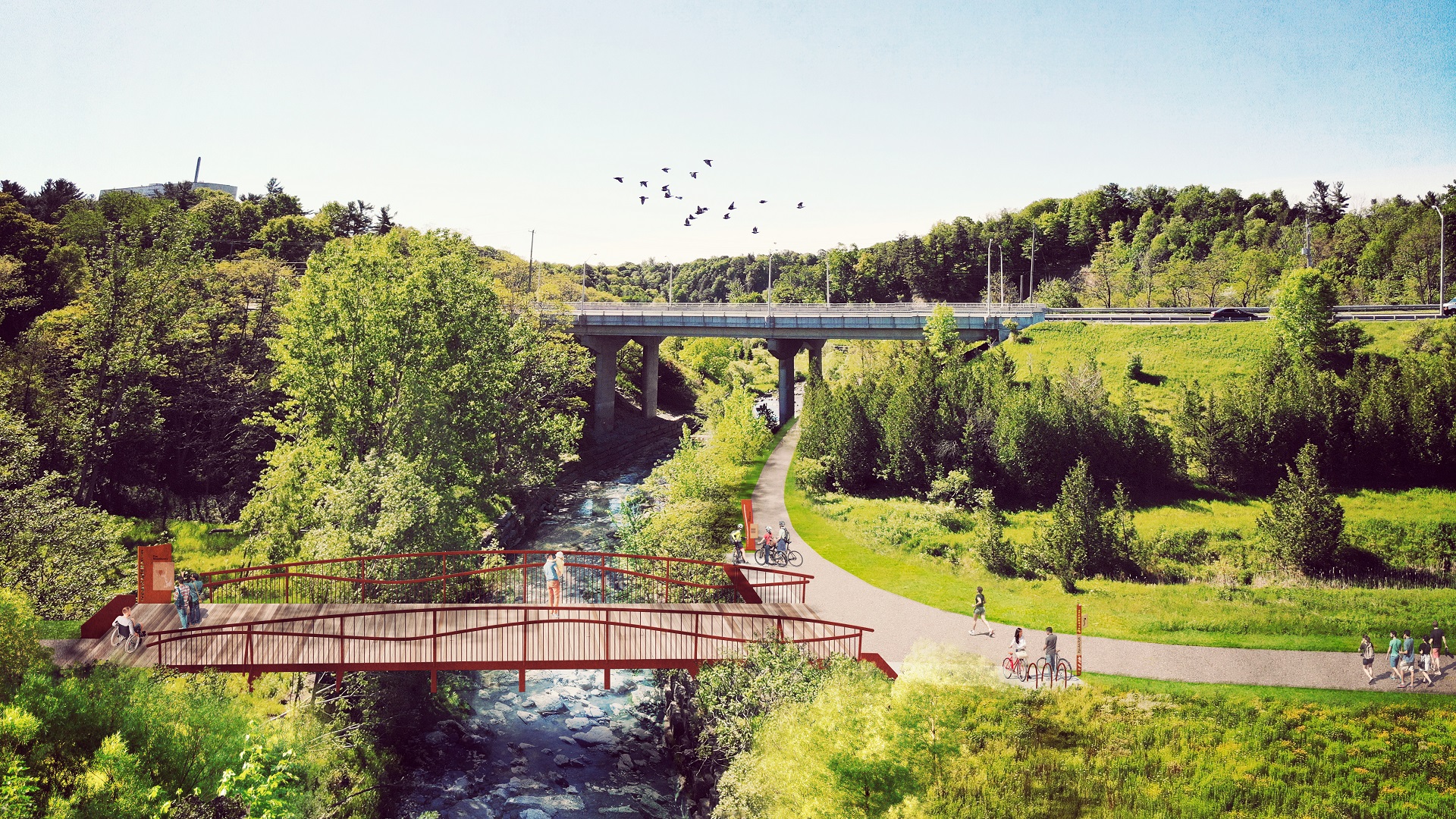
“We believe your commitment to reusing infrastructure to create dynamic open spaces will be a worthy addition to our learning community,” said Asima Jansveld, Vice-President of the High Line Network.
Thanks to the vision and generous support of the Weston Family Foundation, The Meadoway will transform the day-to-day lives of thousands of Torontonians, giving them easy access to nature.
The 16-km, 500-acre hydro corridor will connect Rouge National Urban Park with the Don River path system leading to the downtown core.
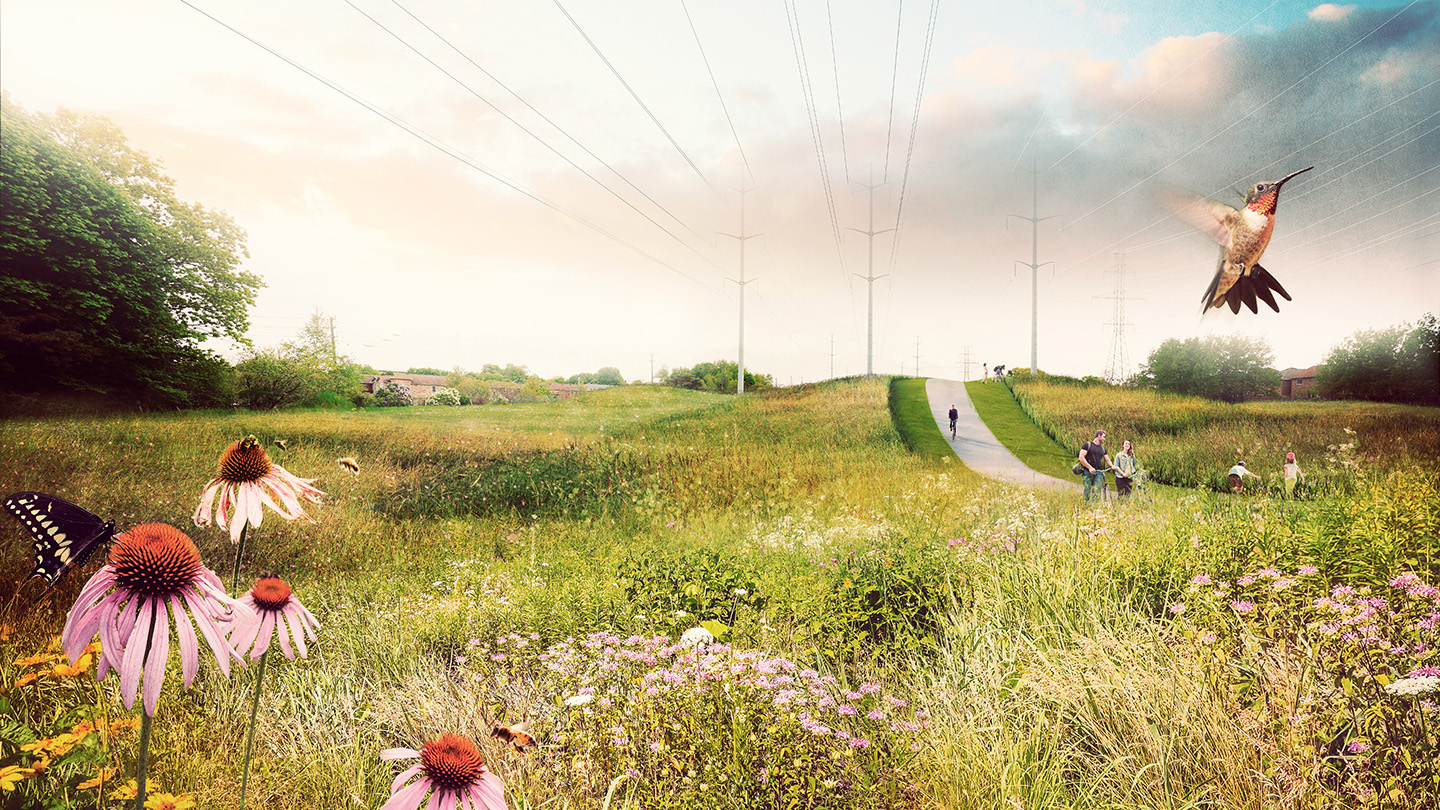
“We’re delighted to see The Meadoway join this group of innovative urban infrastructure projects,” said Tamara Rebanks, Chair, Weston Family Foundation.
“With more and more Canadians living in cities, the need to reimagine these underutilized spaces grows to provide places for communities to connect with nature and each other.”
The Meadoway will connect users to the natural environment, as more than 200 hectares of turf grass are transformed into a thriving meadow, creating habitat for native plants, pollinators, and wildlife.
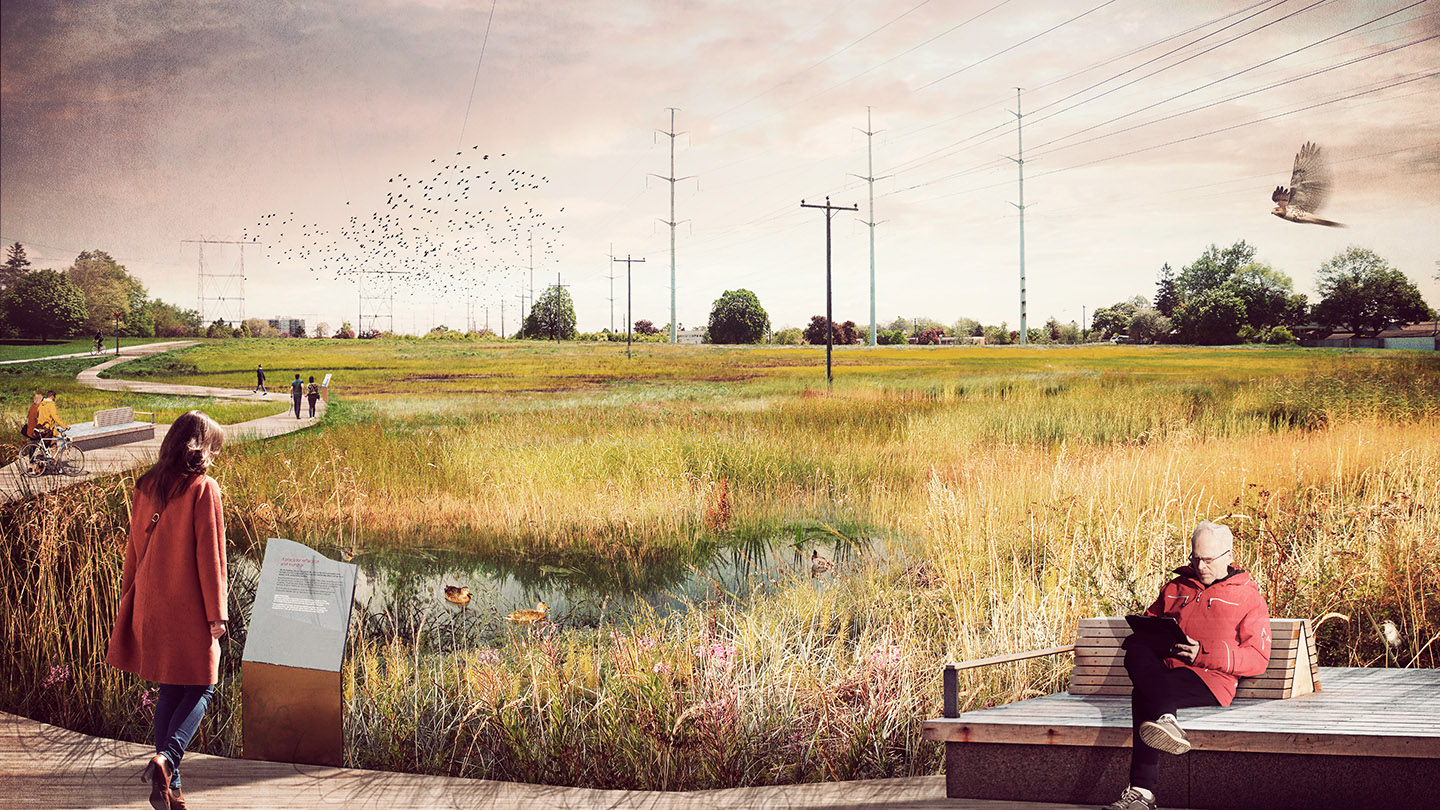
“It’s a tremendous honor and recognition of TRCA’s creativity, vision, and dedication to integrating natural and built environments that The Meadoway has been invited to join the prestigious High Line Network,” said Jennifer Innis, Chair of TRCA’s Board of Directors.
“When complete, this multi-use trail along a hydro corridor will transform the way people move, and breathe new life into Toronto and its surrounding communities. A special thank you to the Weston Family Foundation for their generous support in making this a reality.”
Slated to be completed in the fall of 2024, The Meadoway will connect 70 schools, 34 neighbourhoods, and 15 parks, and will provide a critical connection between Toronto’s unique ravine system.
June 24, 2020: Meadoway Wildlife & More
UPDATE: June 24, 2020
In a previous update (June 11) we mentioned the importance of doing nest checks before we bring in the mowing equipment.
When our crews spot wildlife, they mark the location and give it a wide berth.
Recently, crews have been seeing a lot of ground-nesting birds, including killdeer and Savannah sparrow. This week, in fact, a team member snapped this photograph of a newly hatched killdeer!
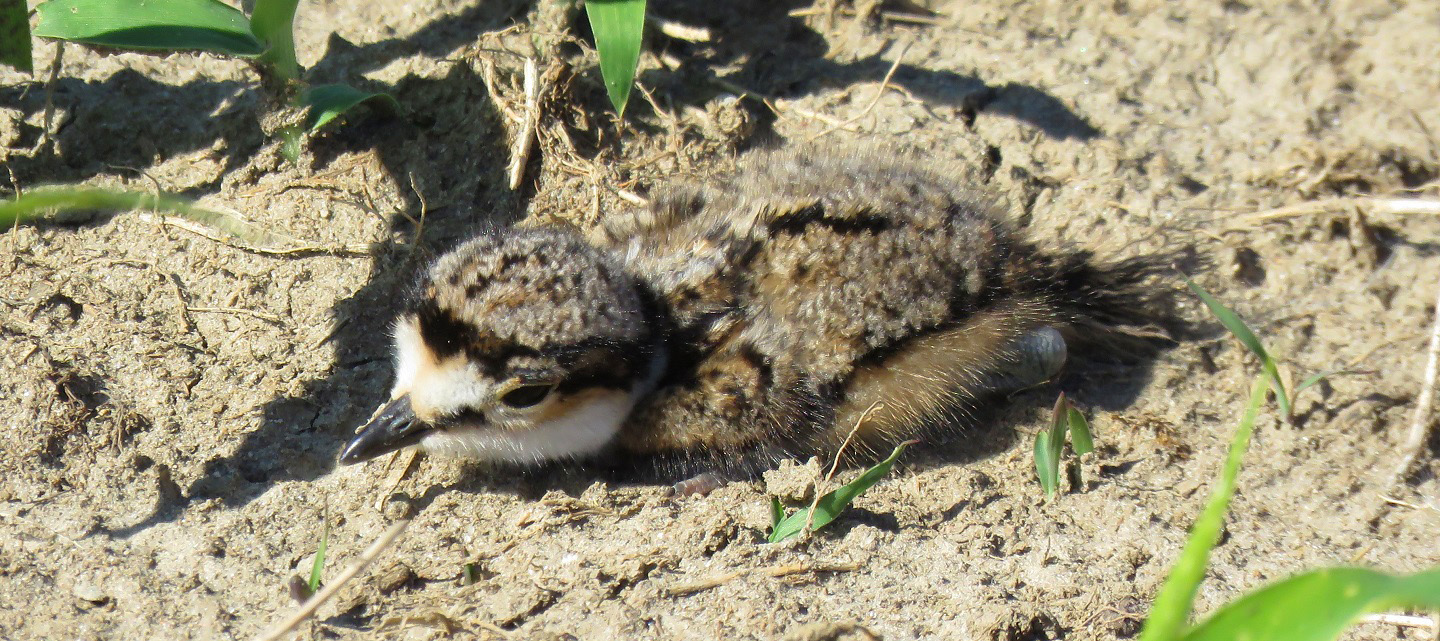
Speaking of wildlife, another sharp-eyed crew member managed to grab a photo of this fawn strolling across the path.
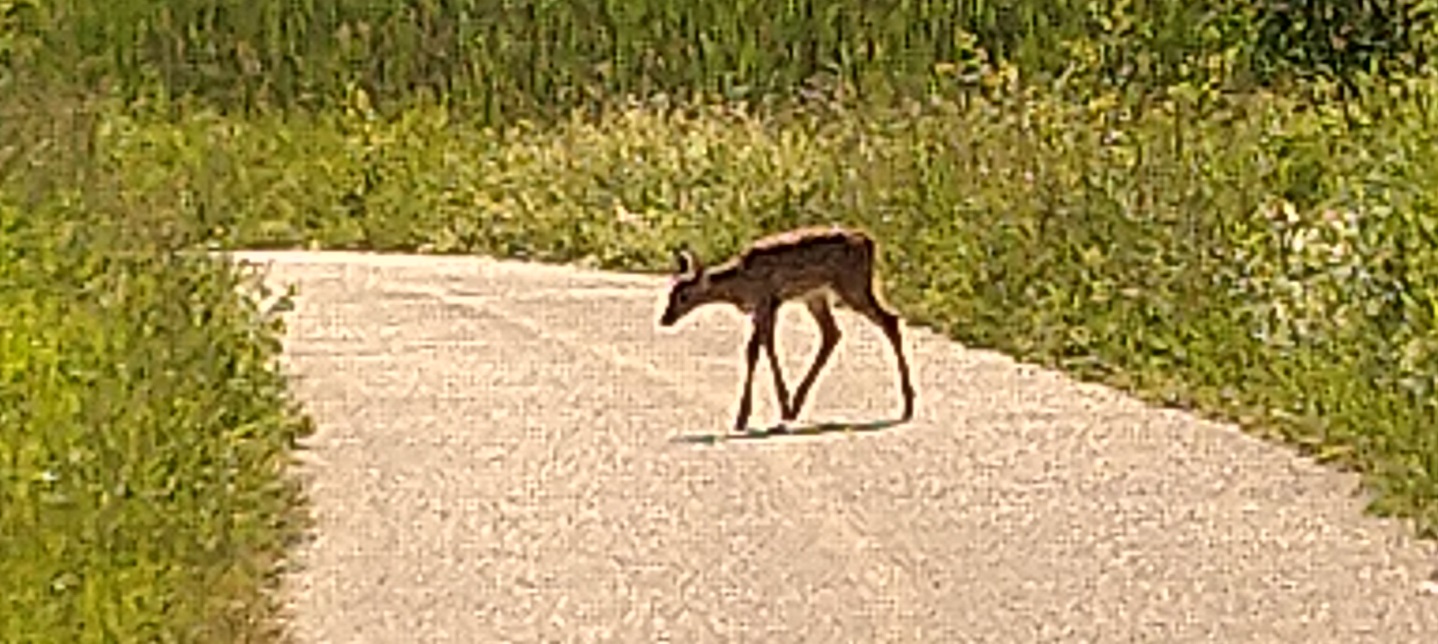
When you see a group of our dedicated restoration team members trimming along fences, it isn’t just about making things look tidy — it also helps to control invasive species.
Dog-strangling vine, for example, is an invasive plant that tends to grow heavily along fences. Keeping it cut back helps to prevent additional seeding.
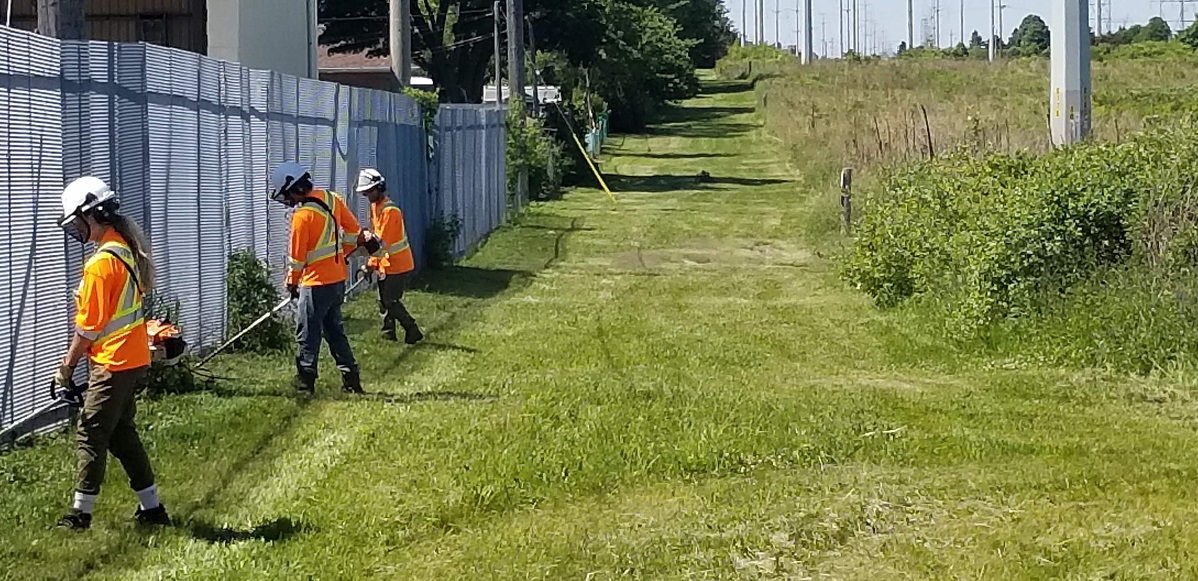
Mowing the buffers between the meadow and shrub nodes (as shown below) is another way to prevent the transfer of invasive species into the meadow.
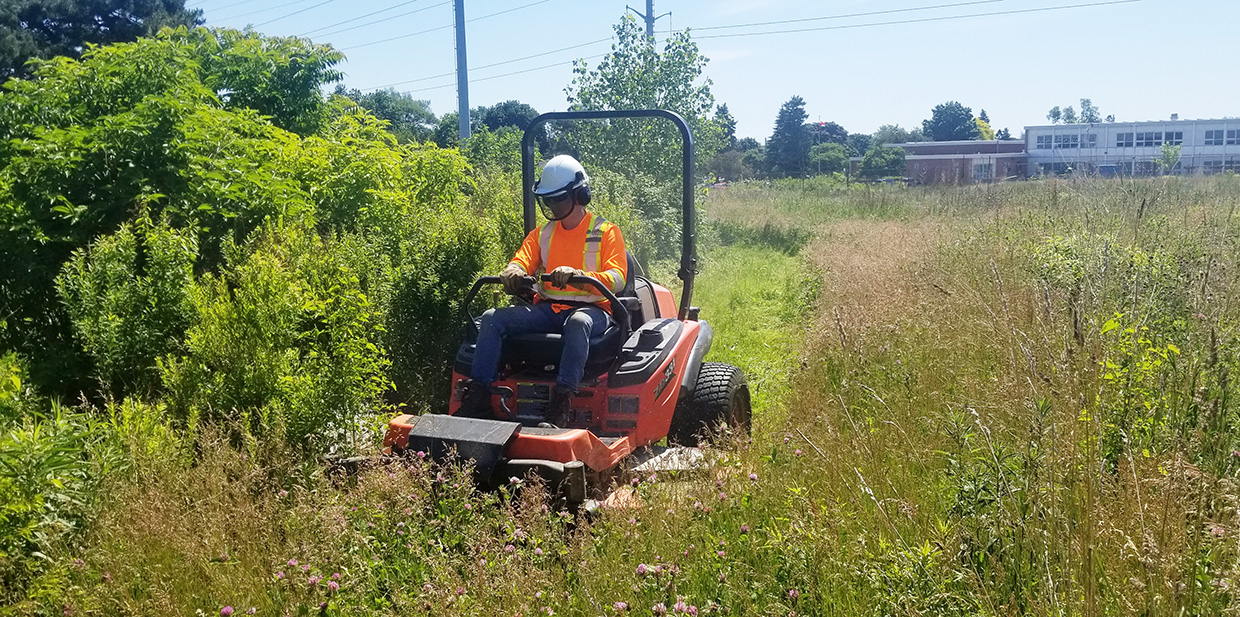
So what’s blooming in The Meadoway this week? Say hello to Coreopsis tripteris (sometimes called tall coreopsis or tall tickseed) and blue flag Iris (Iris versicolor).
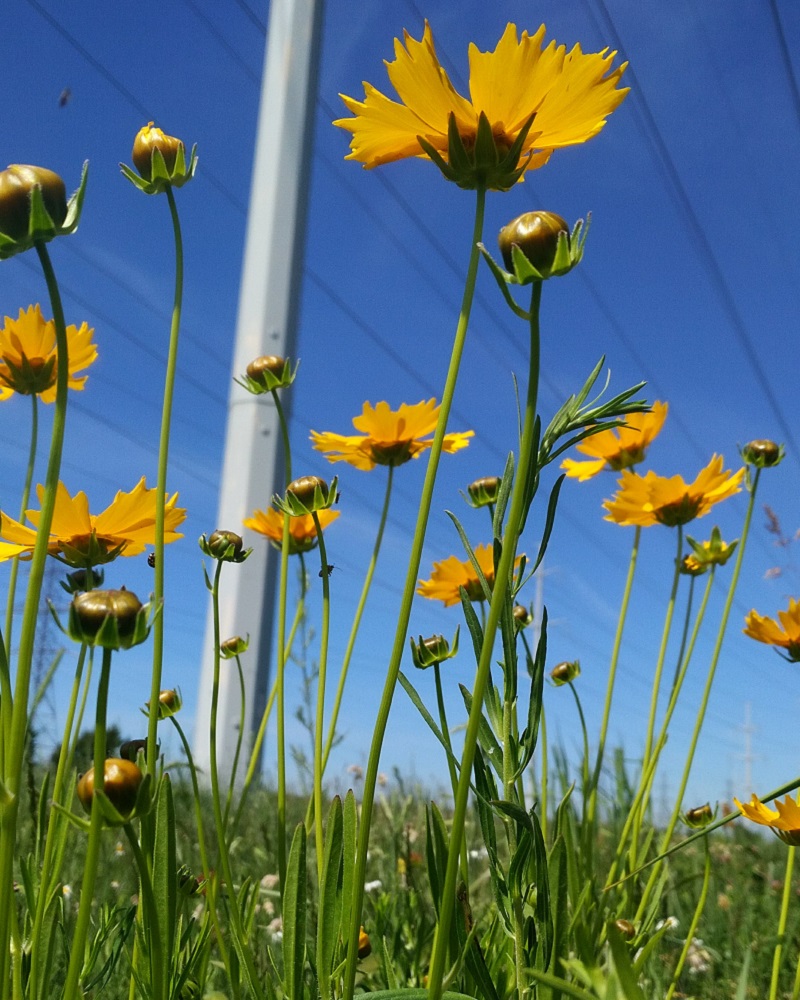
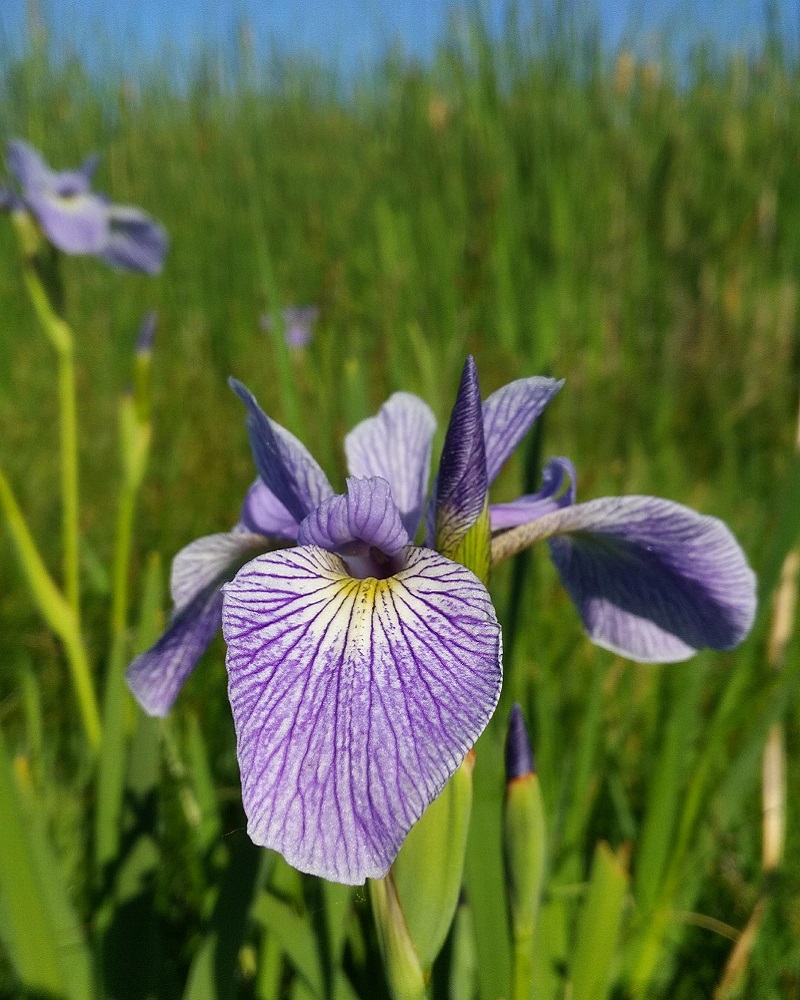
June 18, 2020: Mowing, Trimming, Planting & More
UPDATE: June 18, 2020
This time of year, it’s non-stop activity in The Meadoway.
It’s a common sight to see our crews using a range of equipment for mowing, trimming, planting, and a variety of other tasks!
The first round of site preparation is now complete, from Victoria Park Ave to Kennedy Road. The cover crop of oats is growing well, and next week crews will begin the second round of site prep.
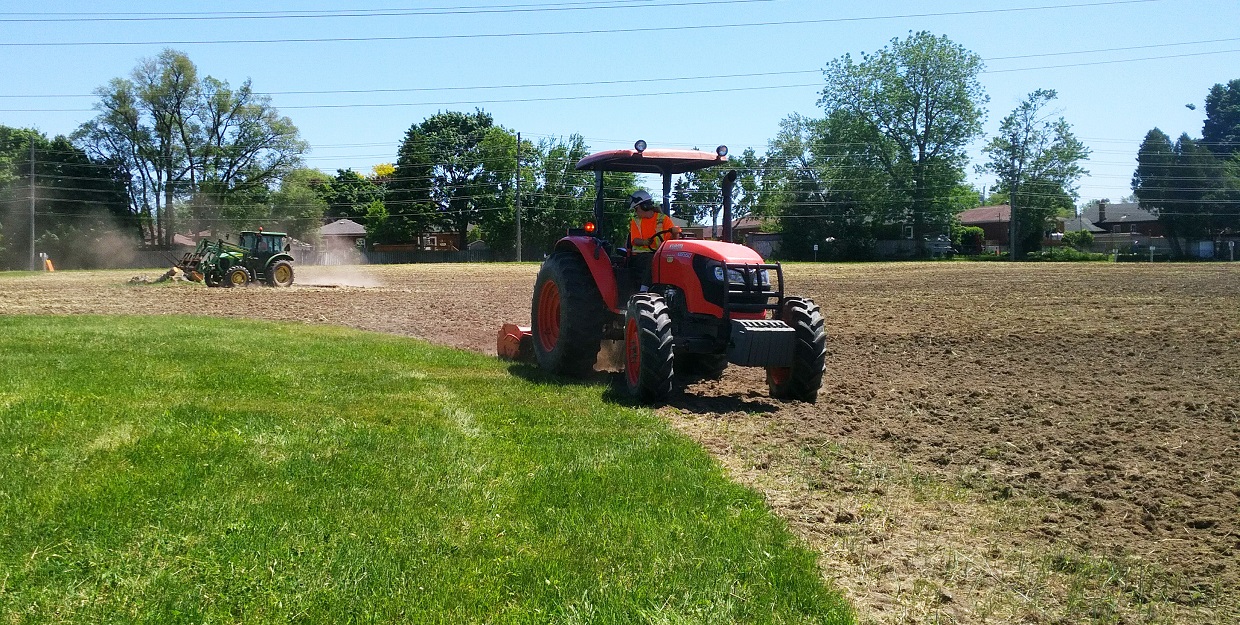
As for the stars of the show, many of The Meadoway’s native plants are starting to bloom.
This past week it was wild lupin (Lupinus perennis). Be sure to look for some on your next visit — but don’t wait too long! This species only stays in flower for a couple of weeks.
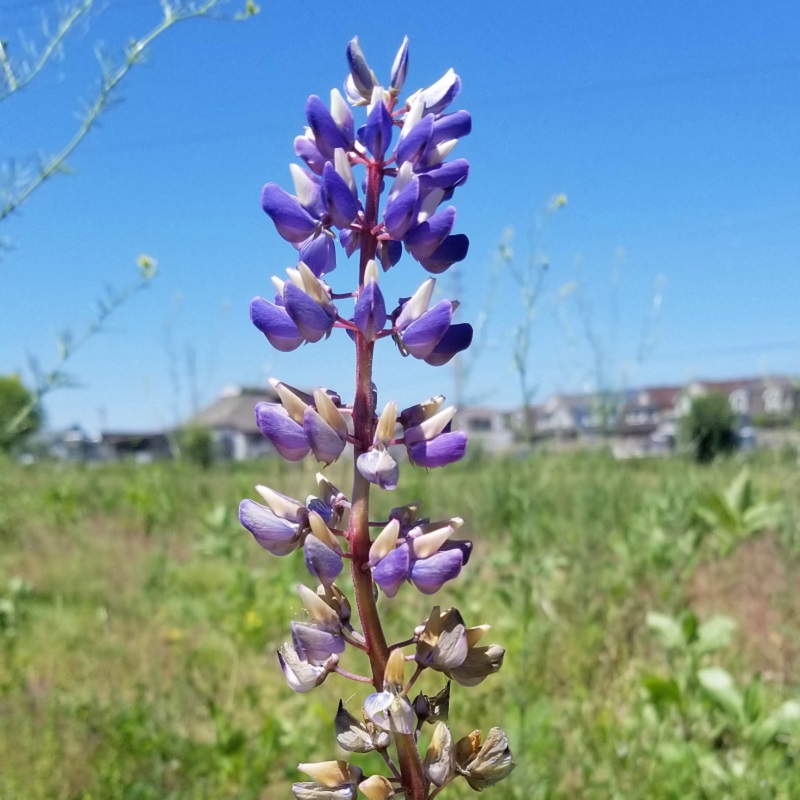
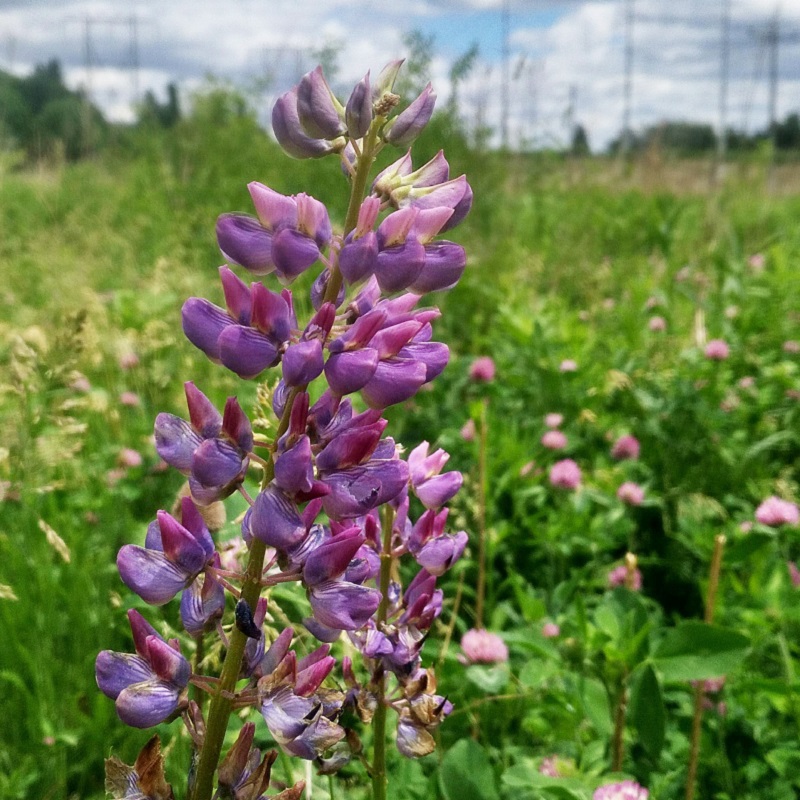
Something new! We are adding QR code stickers to our signs in phase one of The Meadoway, from Scarborough Golf Club Road to McCowan Road. Scan one with your phone the next time you visit!
Check out The Meadoway visualization toolkit to try some of our QR codes.
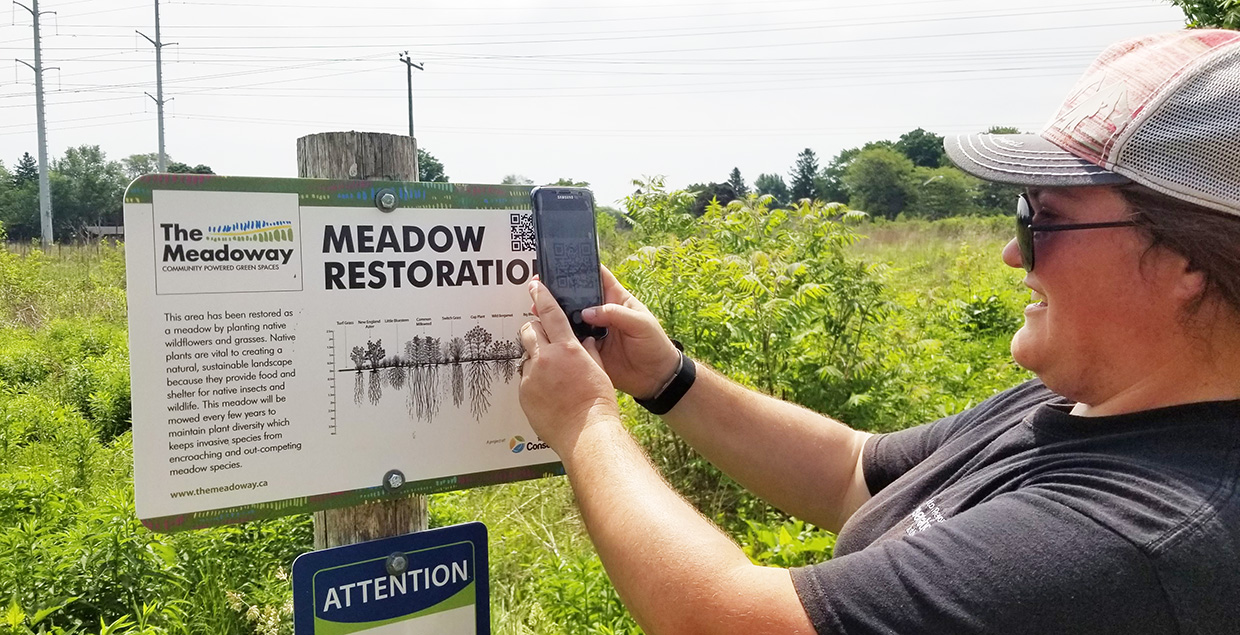
There are many native species now appearing in a section that was seeded last year. It’s mostly black-eyed Susan starting to poke up from the grasses (see image 1 below).
This area will be full of flowers soon, like the established area shown in image 2.

Image 1
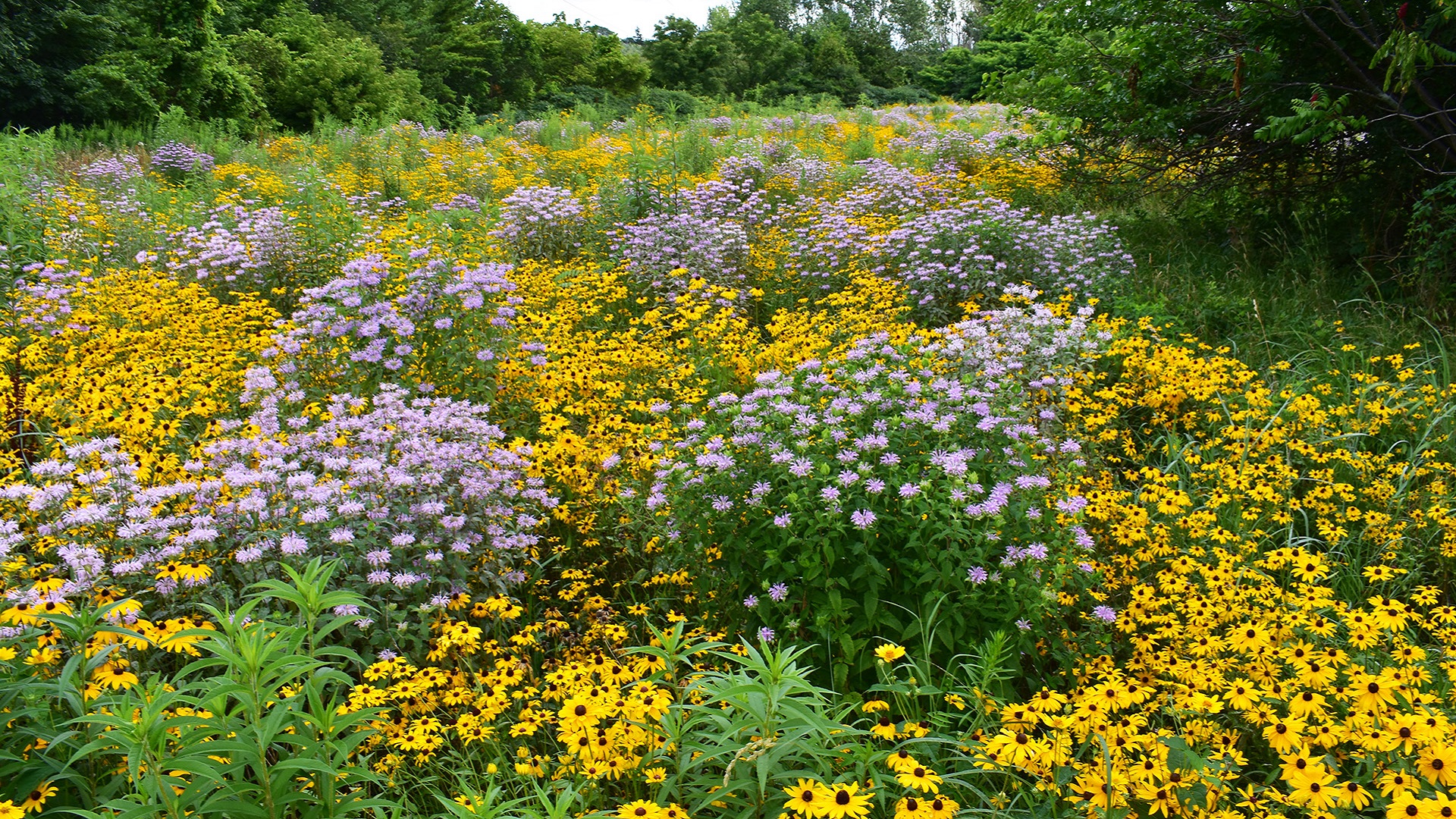
Image 2
June 11, 2020: All About Our Cover Crop
UPDATE: June 11, 2020
This week, it’s all about our cover crop.
Rye and oats are key to site preparation, which is the most important step in meadow restoration. This blog post explains why.
The rye we planted last year is now over 30 cm tall in some sections. Our crews always conduct a sweep through the tall rye for nesting birds before bringing in tractor equipment. Any nests are marked with a wide buffer and avoided.
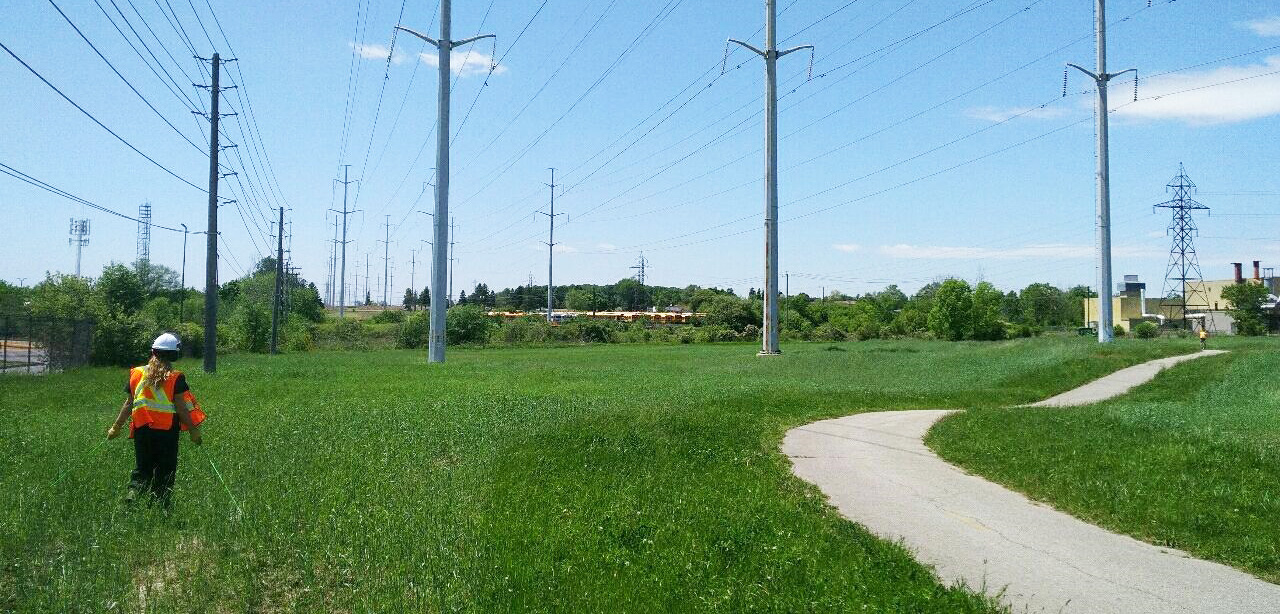
The last of the rye was cut this week! We don’t want it growing any larger, since we want to avoid reseeding.
Fall rye is seeded late in the year and helps to stabilize the soils from erosion while also helping to suppress non-desired weeds forming in the meadow footprint.
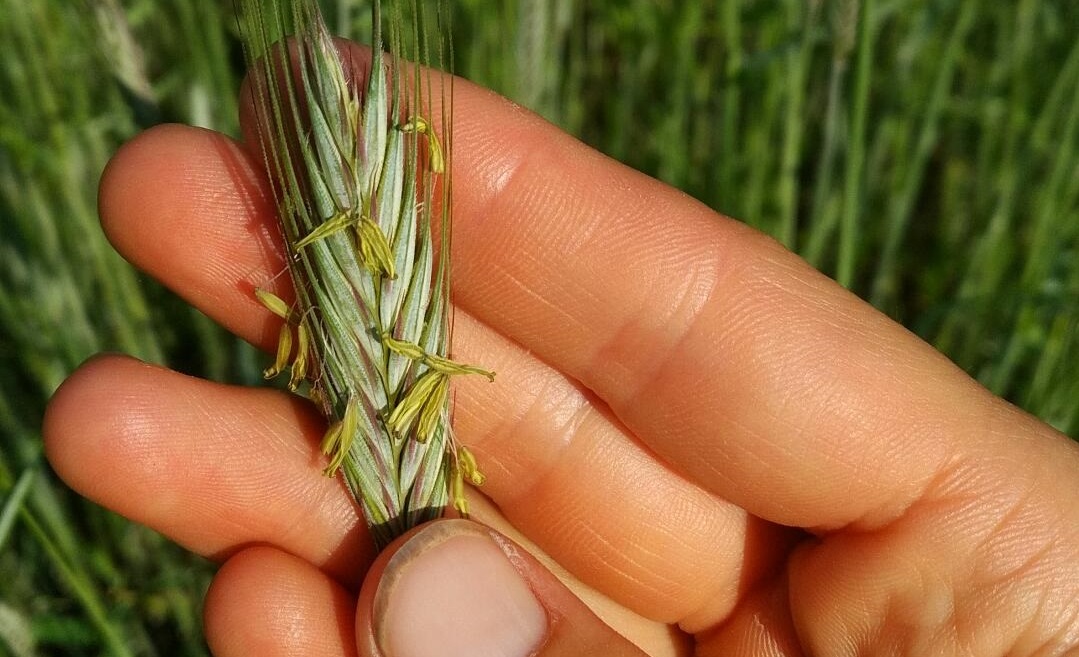
This year the field will be mowed and tilled, and a cover crop of oats will be seeded. We’ll do this three times, from spring to fall.
This process helps to reduce the existing non-native seed supply in the fields, and prepares the site for fall native wildflower and grass seeding.
Periods of hot weather and intermittent rain create ideal growing conditions for grass. Our crews were busy tending to our mown buffers again this week. This is important to reduce the spread of invasive species and create a walking corridor bordering the meadow plots.
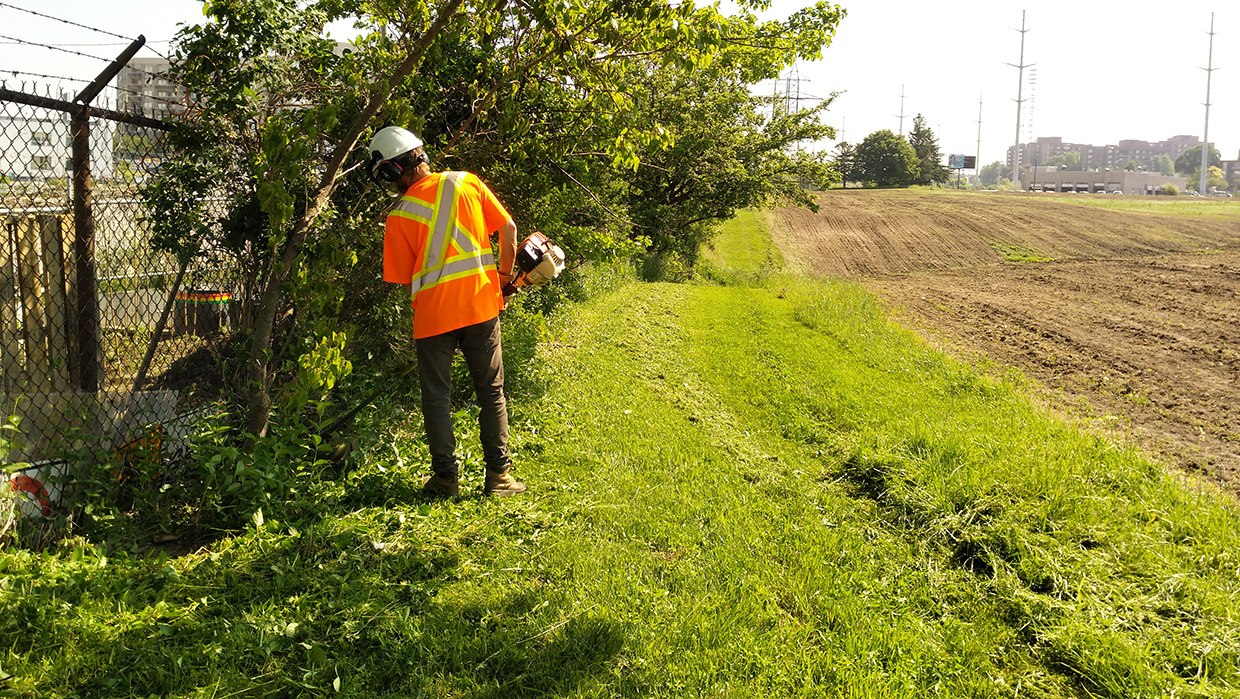
Last week, staff turned up a horseshoe in The Meadoway. This week brought another surprising find! A rare species was spotted outside of the meadow footprint: a lady’s slipper.
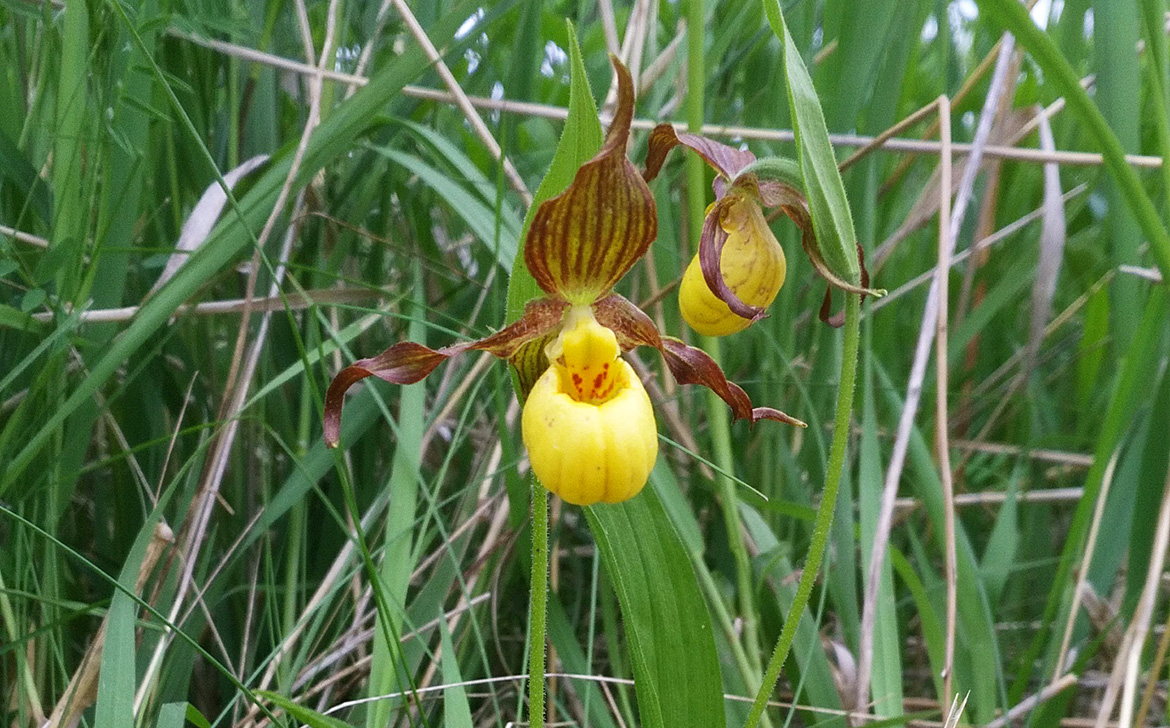
June 5, 2020: Invasive Species, Bumblebees & More
UPDATE: June 5, 2020
When it comes to weeds, fellow gardeners know the feeling: you can never let your guard down!
It’s the same for invasive species. A great deal of effort goes into controlling non-native plants in The Meadoway. Our crew found large patches of garlic mustard this week under many trees. It was all dug out before the seeds could mature.
Have you noticed how many bumblebees are out and about? This one was captured feasting on the flowers of a fragrant sumac.
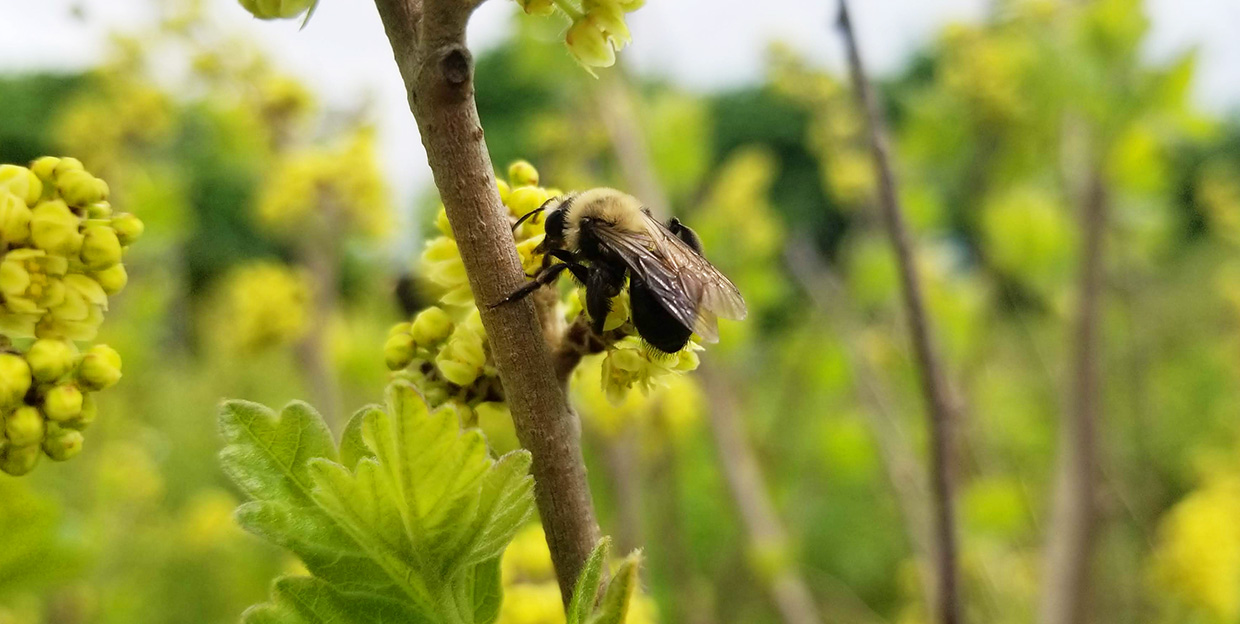
Keeping the mown buffers around The Meadoway tidy is important for many reasons.
Most important, allowing a space between the neighboring yards and the meadow encourages a leisurely stroll along the entire perimeter.
Check out the before and after images.
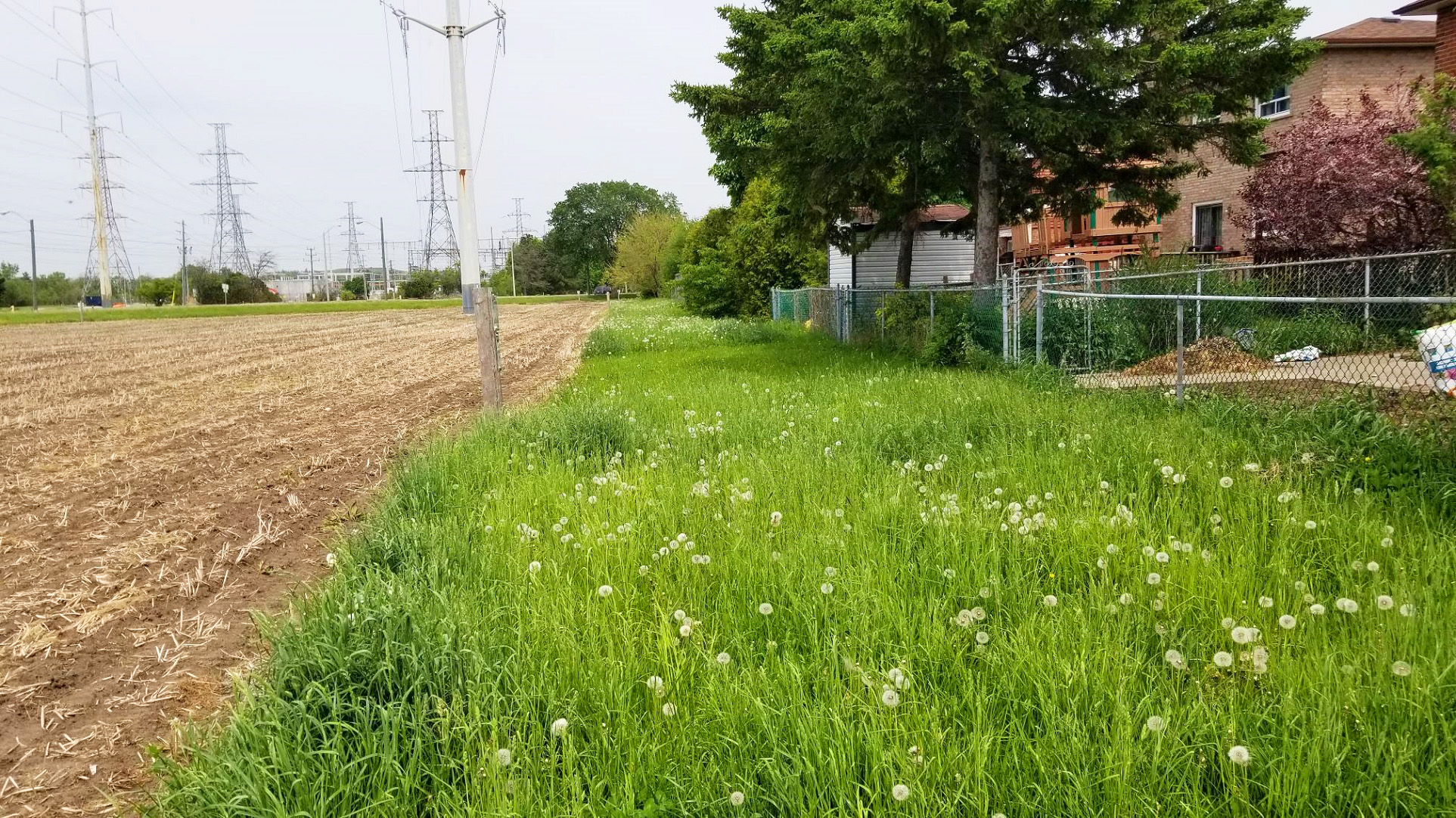
Before
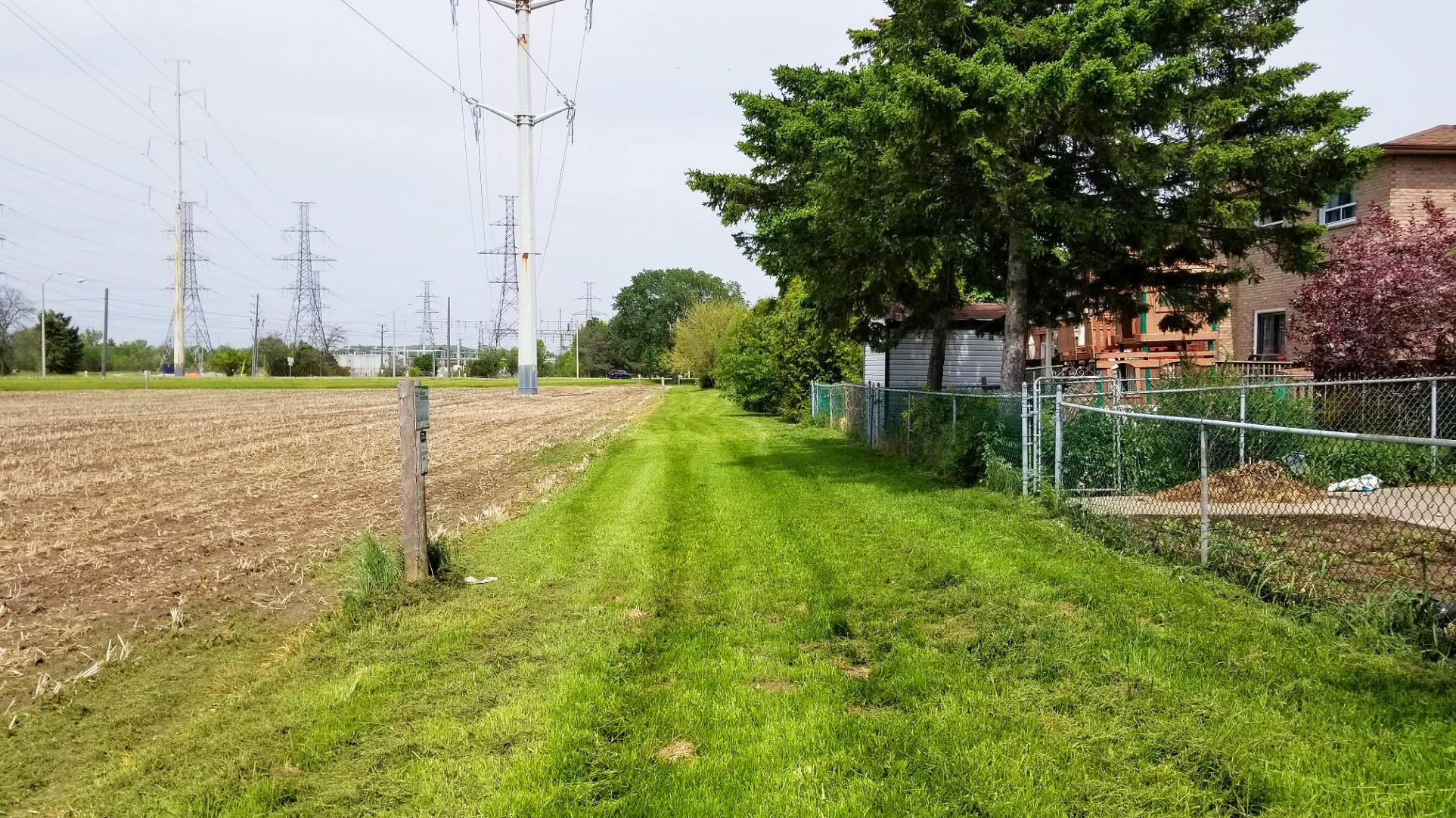
After
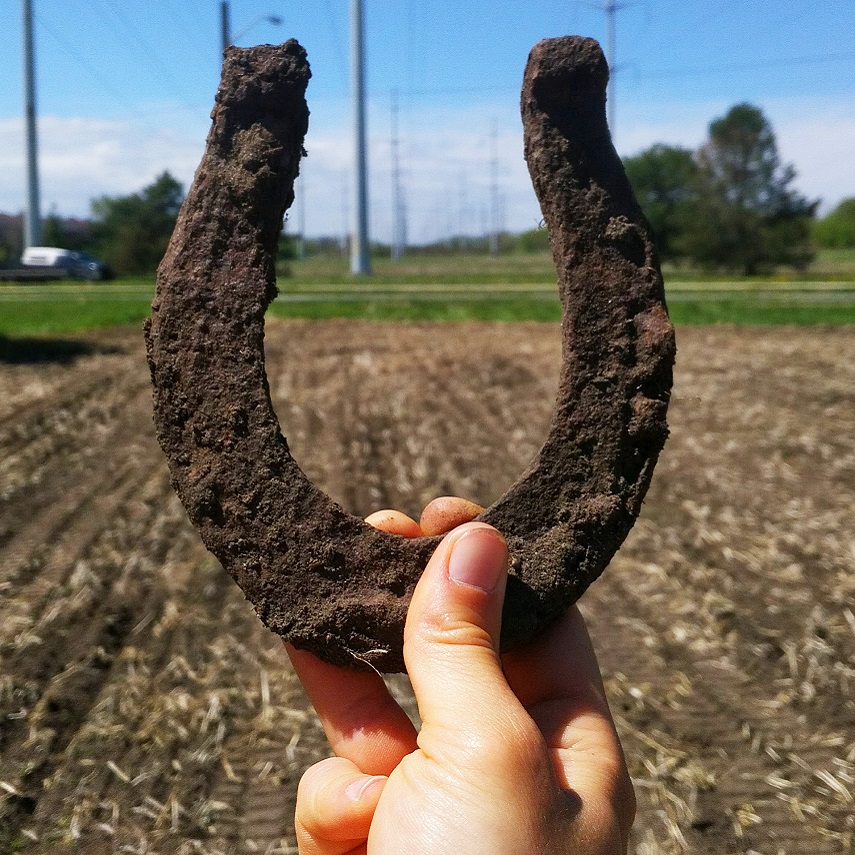 Official archaeological surveys are conducted in The Meadoway, and every now and then something turns up. We’ll take this lucky horseshoe (left) as a sign of good things to come!
Official archaeological surveys are conducted in The Meadoway, and every now and then something turns up. We’ll take this lucky horseshoe (left) as a sign of good things to come!
May 27, 2020: Soil Prep & Cover Crop Seeding
UPDATE: May 27, 2020
It’s been easy to spot our crews working hard on their meadow restoration checklists.
Garbage cleanup this time of year is a priority — as is non-native shrub removal within the meadow footprint. It’s important to keep invasive woody vegetation from establishing and spreading in the hydro corridor so it doesn’t out-compete the native flora.
The rye planted last year as a cover crop is now over 30 cm tall in some areas! Our crews will mow and till these sections to prepare the soil for planting native grasses and wildflowers in the fall.
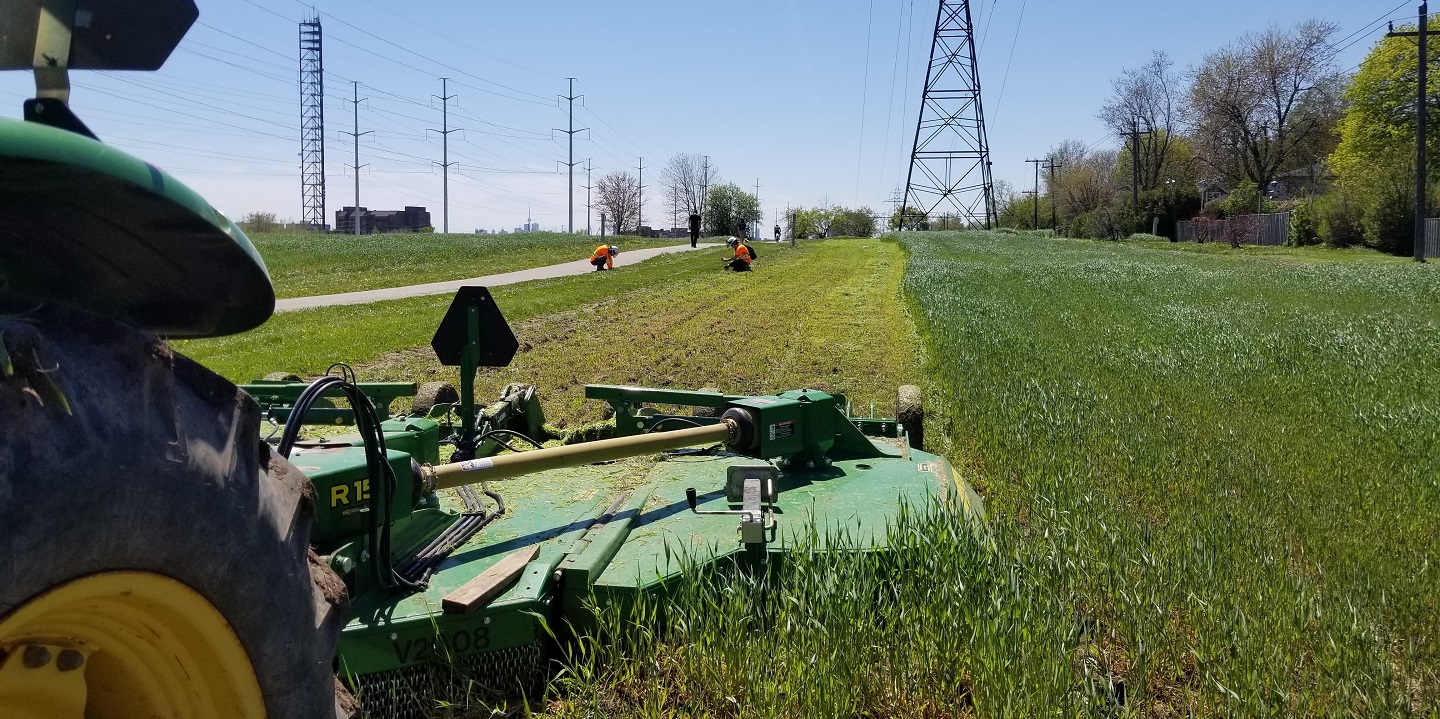
Grass mown buffers (like the one pictured above) are a distinctive feature of The Meadoway. They separate the multi-use path from the meadow with a 3.25m mown buffer that contributes to the safety of trail users by providing clear sight lines.
The homes that back onto the corridor have a 5m mown buffer, which keeps the vegetation away from the fence lines.
Native seed mix trials and research are also ongoing priorities. A variety of new seed mixes are now in the experimentation stage. We are also monitoring how a mix with a higher percentage of grass seed compares to one with lower grass components.


